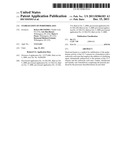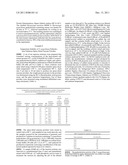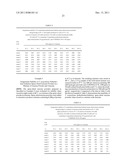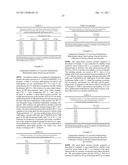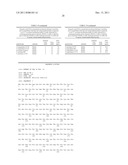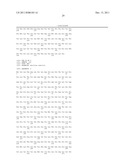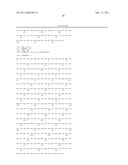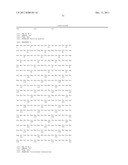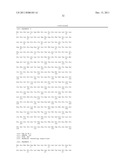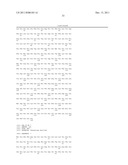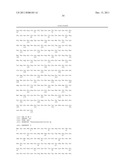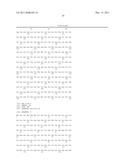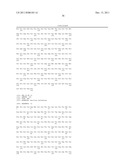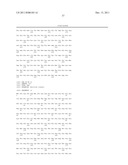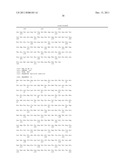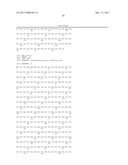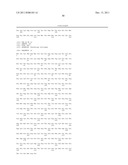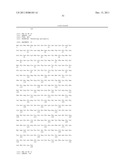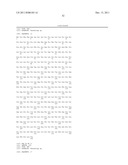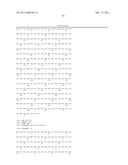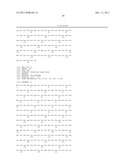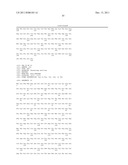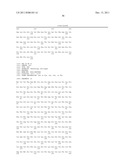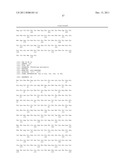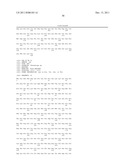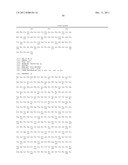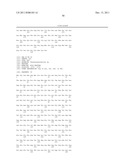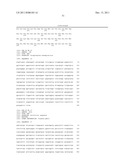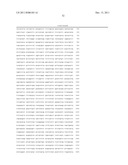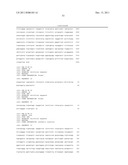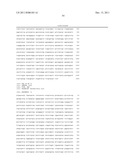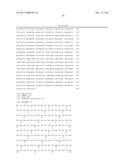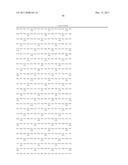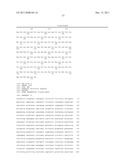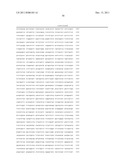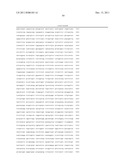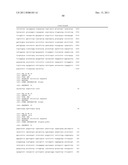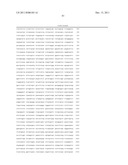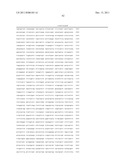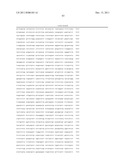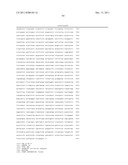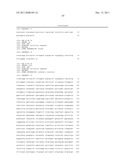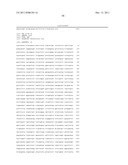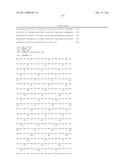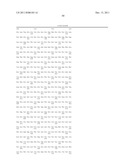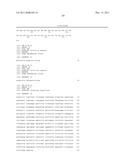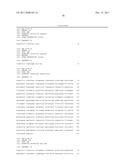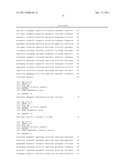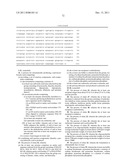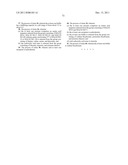Patent application title: Stabilization Of Perhydrolases
Inventors:
Robert Dicosimo (Chadds Ford, PA, US)
Arie Ben-Bassat (Wilmington, DE, US)
Arie Ben-Bassat (Wilmington, DE, US)
Mark S. Payne (Wilmington, DE, US)
Raymond Richard Zolandz (Wilmington, DE, US)
Raymond Richard Zolandz (Wilmington, DE, US)
IPC8 Class: AC12P740FI
USPC Class:
435136
Class name: Micro-organism, tissue cell culture or enzyme using process to synthesize a desired chemical compound or composition preparing oxygen-containing organic compound containing a carboxyl group
Publication date: 2011-12-15
Patent application number: 20110306103
Abstract:
Disclosed herein is a method for stabilization of the perhydrolase
activity of the CE-7 esterase in a formulation with a carboxylic acid
ester that employs the addition of a buffering agent, substantially
undissolved, to the mixture of the CE-7 esterase and the carboxylic acid
ester. Further, disinfectant and laundry care formulations comprising the
peracids produced by the processes described herein are provided.Claims:
1-21. (canceled)
22. A process for enzymatically producing a peroxycarboxylic acid comprising: (a) providing a set of reaction components, said components comprising: (1) the formulation comprising a mixture of: (I) at least one carboxylic acid ester selected from the group consisting of monoacetin, diacetin, triacetin, monopropionin, dipropionin, tripropionin, monobutyrin, dibutyrin, tributyrin, and mixtures thereof; (II) an enzyme powder comprising (i) at least one enzyme structurally classified as a CE-7 enzyme and having perhydrolysis activity and a signature motif comprising: (A) an RGQ motif at amino acid residues 118-120, (B) a GXSQG motif at amino acid residues 179-183, and (C) an HE motif at amino acid residues 298-299 when aligned to reference sequence SEQ ID NO:1 using CLUSTALW, (ii) at least one excipient, and (iii) optionally at least one surfactant; and (III) at least one buffer; wherein said at least one buffer enhances the stability of said at least one enzyme when present in said formulation as compared to the perhydrolase activity of said at least one enzyme when the at least one excipient is not present; and (2) a source of peroxygen in water; and (b) combining said reaction components whereby a peroxycarboxylic acid is produced.
23. The process of claim 22, wherein: (a) the at least one enzyme comprises an amino acid sequence selected from the group consisting of SEQ ID NO:6, SEQ ID NO:7, SEQ ID NO:19 and SEQ ID NO:20, wherein amino acid residue 277 of SEQ ID NO: 19 or SEQ ID NO: 20 is selected from the group consisting of alanine, valine, serine, and threonine; (b) the at least one excipient is maltodextrin; (c) the at least one buffer is selected from the group consisting of sodium bicarbonate, potassium bicarbonate, a mixture of sodium bicarbonate and potassium bicarbonate, sodium phosphate, potassium phosphate, and a mixture of sodium phosphate and potassium phosphate; (d) the at least one carboxylic acid ester is triacetin; and (e) the peroxycarboxylic acid produced is peracetic acid.
24-26. (canceled)
27. The process of claim 22, wherein the at least one excipient ranges from about 95 wt % to about 25 wt % of the enzyme powder.
28. The process of claim 27, wherein the at least one excipient is selected from the group consisting of maltodextrin, trehalose, xylan, mannan, fucoidan, galactomannan, chitosan, raffinose, stachyose, pectin, inulin, levan, graminan, amylopectin, and mixtures thereof.
29. The process of claim 28, wherein the at least one excipient is maltodextrin.
30. The process of claim 28, wherein the at least one excipient is trehalose.
31. The process of claim 22, wherein the carboxylic acid ester is triacetin.
32. The process of claim 22, wherein the at least one surfactant is present and is polysorbate 80.
33. The process of claim 27, wherein the at least one excipient is an oligosaccharide excipient having a number average molecular weight of at least about 1250 and a weight average molecular weight of at least about 9000.
34. The process of claim 33, wherein the oligosaccharide excipient has a number average molecular weight of at least about 1700 and a weight average molecular weight of at least about 15000.
35. The process of claim 22, wherein the formulation is substantially free of water.
36. The process of claim 35, wherein the at least one buffer is sodium bicarbonate, potassium bicarbonate, a mixture of sodium bicarbonate and potassium bicarbonate, sodium phosphate, potassium phosphate, or a mixture of sodium phosphate and potassium phosphate.
37. The process of claim 36, wherein the at least one buffer has a buffering capacity in a pH range of from about 5.5 to about 9.5.
38. The process of claim 36, wherein: (a) the at least one enzyme comprises an amino acid sequence selected from the group consisting of SEQ ID NO:6, SEQ ID NO:7, SEQ ID NO:19, and SEQ ID NO:20, wherein amino acid residue 277 of SEQ ID NO: 19 or SEQ ID NO: 20 is selected from the group consisting of alanine, valine, serine, and threonine, and (b) the carboxylic acid ester is selected from the group consisting of diacetin, triacetin, and mixtures thereof.
39. The process of claim 38, wherein said at least one excipient is maltodextrin.
40. The process of claim 36, wherein: (a) the at least one enzyme comprises an amino acid sequence selected from the group consisting of SEQ ID NO:6 and SEQ ID NO:7; (b) the at least one excipient is maltodextrin; (c) the at least one buffer is selected from the group consisting of sodium bicarbonate, potassium bicarbonate, and mixtures thereof; and (d) said carboxylic acid ester is triacetin.
41. The process of claim 40, wherein the at least one buffer is sodium bicarbonate.
Description:
CROSS REFERENCE TO RELATED APPLICATIONS
[0001] This application claims the benefit of U.S. Provisional Application Nos. 61/102,505; 61/102,512; 61/102,514; 61/102,520; 61/102,531; and 61/102,539; each filed Oct. 3, 2008, each of which incorporated by reference herein in their entireties.
FIELD OF THE INVENTION
[0002] This invention relates to the field of enzymatic peracid synthesis and in situ enzyme catalysis. At least one peroxycarboxylic acid is produced at sufficient concentrations as to be efficacious for the disinfection or sanitization of surfaces, medical instrument sterilization, food processing equipment sterilization, and suitable for use in textile and laundry care applications such as bleaching, destaining, deodorizing, disinfection or sanitization.
BACKGROUND OF THE INVENTION
[0003] Peracid compositions have been reported to be effective antimicrobial agents. Methods to clean, disinfect, and/or sanitize hard surfaces, meat products, living plant tissues, and medical devices against undesirable microbial growth have been described (e.g., U.S. Pat. No. 6,545,047; U.S. Pat. No. 6,183,807; U.S. Pat. No. 6,518,307; U.S. Pat. No. 5,683,724; and U.S. Patent Application Publication No. 2003/0026846). Peracids have also been reported to be useful in preparing bleaching compositions for laundry detergent applications (U.S. Pat. No. 3,974,082; U.S. Pat. No. 5,296,161; and U.S. Pat. No. 5,364,554).
[0004] Peracids can be prepared by the chemical reaction of a carboxylic acid and hydrogen peroxide (see Organic Peroxides, Daniel Swern, ed., Vol. 1, pp 313-516; Wiley Interscience, New York, 1971). The reaction is usually catalyzed by a strong inorganic acid, such as concentrated sulfuric acid. The reaction of hydrogen peroxide with a carboxylic acid is an equilibrium reaction, and the production of peracid is favored by the use of an excess concentration of peroxide and/or carboxylic acid, or by the removal of water.
[0005] Some peracid-based disinfectants or bleaching agents are comprised of an equilibrium mixture of peracid, hydrogen peroxide, and the corresponding carboxylic acid. One disadvantage of these commercial peracid cleaning systems is that the peracid is oftentimes unstable in solution over time. One way to overcome the stability problem is to generate the peracid prior to use by combining multiple reaction components that are individually stable for extended periods of time. Preferably, the individual reaction components are easy to store, relatively safe to handle, and capable of quickly producing an efficacious concentration of peracid upon mixing.
[0006] The CE-7 family of carbohydrate esterases has recently been reported to have perhydrolase activity. These "perhydrolase" enzymes have been demonstrated to be particularly effective for producing peracids from a variety of carboxylic acid ester substrates when combined with a source of peroxygen (See WO2007/070609 and U.S. Patent Application Publication Nos. 2008/0176299 and 2008/176783 to DiCosimo et al.; each herein incorporated by reference in their entireties). Some members of the CE-7 family of carbohydrate esterases have been demonstrated to have perhydrolytic activity sufficient to produce 4000-5000 ppm peracetic acid from acetyl esters of alcohols, diols, and glycerols in 1 minute and up to 9000 ppm between 5 minutes and 30 minutes once the reaction components were mixed (DiCosimo et al., U.S. Patent Application Publication No. 2009/0005590).
[0007] The enzymatic peracid generation system described by U.S. 2009/0005590 to DiCosimo et al. is typically based on the use of multiple reaction components that remain separated until the peracid solution is needed. Using this approach overcomes the peracid instability issues associated with storage of many peracid-based disinfectants and bleaching agents. However, specific formulations that provide long term stability of perhydrolase activity when using multicomponent formulations comprising CE-7 carbohydrate esterases remains to be addressed. Of particular concern is the long term storage stability of a CE-7 enzyme having perhydrolysis activity when stored in an organic liquid or solvent having a log P (i.e., the logarithm of the partition coefficient of a substance between octanol and water, where P equals [solute]octanol/[solute]water) of less than two. Several of the organic ester substrates previous described by DiCosimo et al. have log P values of less than two.
[0008] Organic liquids or solvents can be deleterious to the activity of enzymes, either when enzymes are suspended directly in organic liquids or solvents, or when miscible organic/aqueous single phase liquids or solvents are employed. Two literature publications that review the effects of organic solvents on enzyme activity and structure are: (a) C. Laane et al., Biotechnol. Bioeng. 30:81-87 (1987) and (b) Cowan, D. A. and Plant, A., Biocatalysis in Organic Phase Systems., Ch. 7 in Biocatalysis at Extreme Temperatures, Kelly, R. W. W. and Adams, M., eds., Amer. Chem. Soc. Symposium Series, Oxford University Press, New York, N.Y., pp 86-107 (1992). Cowan and Plant, supra, note (on page 87) that the art generally recognizes that there is little or no value in using organic solvents having a log P≦2 to stabilize intracellular enzymes in an organic phase system. Organic solvents having a log P between two and four can be used on a case-by-case basis dependent on enzyme stability, and those having a log P>4 are generally useful in organic phase systems.
[0009] Cowan and Plant, supra, further note (on page 91) that the effect of direct exposure of an enzyme dissolved in a single-phase organic-aqueous solvent depends on solvent concentration, solvent/enzyme surface group interactions, and solvent/enzyme hydration shell interactions. Because a solvent's log P value must be sufficiently low so that the solvent is fully miscible with the aqueous phase to produce a single-phase, a single-phase organic-aqueous solvent containing a low log P organic solvent usually has a negative effect on enzyme stability except in low organic solvent concentration applications. Triacetin is reported to have a log P of 0.25 (Y. M. Gunning, et al., J. Agric. Food Chem. 48:395-399 (2000)), similar to that of ethanol (log P -0.26) and isopropanol (log P 0.15) (Cowan and Plant); therefore the storage of enzyme powder in triacetin would be expected to result in unacceptable loss of enzyme activity, as would the use of additional cosolvents with log P<2 (e.g., cyclohexanone, log P=0.94) (Cowan and Plant); 1,2-propanediol, log P=-1.41 (Gunning, et al.); 1,3-propanediol, log P=-1.3 (S-J. Kuo, et al., J. Am. Oil Chem. Soc. 73:1427-1433 (1996); diethylene glycol butyl ether, log P=0.56 (N. Funasaki, et al., J. Phys. Chem. 88:5786-5790 (1984); triethyleneglycol, log P=-1.75 (L. Braeken, et al., Chem Phys Chem 6:1606-1612 (2005)).
[0010] Thus, the problem to be solved is to formulate a product using a mixture of a peracid-generating enzyme in an organic ester substrate employed for peracid production, where the enzyme retains significant perhydrolase activity even when stored in a mixture with the carboxylic acid ester substrate.
SUMMARY OF THE INVENTION
[0011] The stated problem has been solved by the discovery of a process for stabilizing the perhydrolysis activity of at least one enzyme structurally classified as a CE-7 enzyme and having perhydrolysis activity when present in a formulation with a carboxylic acid ester. More specifically, the addition of at least one buffer to a formulation comprising a carboxylic acid ester and an enzyme powder comprising the CE-7 enzyme and at least one excipient enhances the stability of the perhydrolysis activity of the CE-7 enzyme stored in the formulation.
[0012] In one aspect, a process to stabilize the perhydrolysis activity of an enzyme when present in a formulation comprised of said enzyme and a carboxylic acid ester is provided, the process comprising: [0013] (a) providing an aqueous formulation comprising at least one enzyme structurally classified as a CE-7 enzyme having perhydrolysis activity, at least one excipient, and optionally at least one surfactant; [0014] (b) spray-drying the aqueous formulation of (a) to produce an enzyme powder comprising said at least one enzyme, said at least one oligosaccharide excipient, and optionally said at least one surfactant; and [0015] (c) combining the enzyme powder of (b) with at least one buffer and a carboxylic acid ester to form a formulation, wherein the addition of the at least one buffer to the formulation enhances the stability of the perhydrolysis activity of said at least one enzyme when stored in said formulation.
[0016] In another aspect, a formulation used as a first component in a multi-component peracid generation system is provided, said formulation comprising a mixture of: [0017] (a) at least one carboxylic acid ester selected from the group consisting of monoacetin, diacetin, triacetin, monopropionin, dipropionin, tripropionin, monobutyrin, dibutyrin, tributyrin, and mixtures thereof; [0018] (b) an enzyme powder comprising a spray-dried formulation of at least one enzyme structurally classified as a CE-7 enzyme and having perhydrolysis activity, at least one excipient, and optionally at least one surfactant; and [0019] (c) at least one buffer; wherein said at least one buffer enhances the stability of said at least one enzyme when present in said formulation.
[0020] In a further aspect, a disinfectant system comprising a first component and a second component is provided, said first component comprising the formulation described above and said second component comprising a source of peroxygen in water and optionally a hydrogen peroxide stabilizer.
[0021] In an additional aspect, a process for enzymatically producing a peroxycarboxylic acid is provided comprising: [0022] (a) providing a set of reaction components, said components comprising: [0023] (1) the formulation described above; and [0024] (2) a source of peroxygen in water; and [0025] (b) combining said reaction components whereby a peroxycarboxylic acid is produced.
[0026] In another aspect, a process to disinfect or sanitize a hard surface or inanimate object using an enzymatically-produced peroxycarboxylic acid composition is provided, said process comprising: [0027] (a) providing a set of reaction components, said components comprising: [0028] (1) the formulation described above; and [0029] (2) a source of peroxygen in water; [0030] (b) combining said reaction components whereby a peroxycarboxylic acid product is produced; [0031] (c) optionally diluting said peroxycarboxylic acid product; and [0032] (d) contacting said hard surface or inanimate object with the peroxycarboxylic acid produced in step (b) or step (c) whereby said surface or said inanimate object is disinfected.
[0033] A further aspect is for a process for treating an article of clothing or a textile for bleaching, stain removal, odor reduction, sanitization or disinfection using an enzymatically-produced peroxycarboxylic acid composition, said process comprising: [0034] (a) providing a set of reaction components, said components comprising: [0035] (1) a formulation comprising [0036] (i) the formulation describe above; and [0037] (ii) a carboxylic acid ester; and [0038] (2) a source of peroxygen; [0039] (b) combining said reaction components under suitable aqueous reaction conditions whereby a peroxycarboxylic acid product is formed; [0040] (c) optionally diluting said peroxycarboxylic acid product; and [0041] (d) contacting said article of clothing or textile fabric with the peroxycarboxylic acid produced in step (b) or step (c); wherein said article of clothing or textile is cleaned, destained, deodorized, sanitized, disinfected, or a combination thereof.
BRIEF DESCRIPTION OF THE BIOLOGICAL SEQUENCES
[0042] The following sequences comply with 37 C.F.R. §§1.821-1.825 ("Requirements for Patent Applications Containing Nucleotide Sequences and/or Amino Acid Sequence Disclosures--the Sequence Rules") and are consistent with World Intellectual Property Organization (WIPO) Standard ST.25 (1998) and the sequence listing requirements of the European Patent Convention (EPC) and the Patent Cooperation Treaty (PCT) Rules 5.2 and 49.5(a-bis), and Section 208 and Annex C of the Administrative Instructions. The symbols and format used for nucleotide and amino acid sequence data comply with the rules set forth in 37 C.F.R. §1.822.
[0043] SEQ ID NO:1 is the deduced amino acid sequence of a cephalosporin C deacetylase from Bacillus subtilis ATCC® 31954®.
[0044] SEQ ID NO:2 is the deduced amino acid sequence of a cephalosporin C deacetylase from B. subtilis ATCC® 6633®.
[0045] SEQ ID NO:3 is the deduced amino acid sequence of a cephalosporin C deacetylase from B. licheniformis ATCC® 14580®.
[0046] SEQ ID NO:4 is the deduced amino acid sequence of an acetyl xylan esterase from B. pumilus PS213.
[0047] SEQ ID NO:5 is the deduced amino acid sequence of an acetyl xylan esterase from Clostridium thermocellum ATCC® 27405®.
[0048] SEQ ID NO:6 is the deduced amino acid sequence of an acetyl xylan esterase from Thermotoga neapolitana.
[0049] SEQ ID NO:7 is the deduced amino acid sequence of an acetyl xylan esterase from Thermotoga maritima MSB8.
[0050] SEQ ID NO:8 is the deduced amino acid sequence of an acetyl xylan esterase from Thermoanaerobacterium sp. JW/SL YS485.
[0051] SEQ ID NO:9 is the deduced amino acid sequence of a cephalosporin C deacetylase from Bacillus sp. NRRL B-14911. It should be noted that the nucleic acid sequence encoding the cephalosporin C deacetylase from Bacillus sp. NRRL B-14911 as reported in GENBANK® Accession number ZP--01168674 appears to encode a 15 amino acid N-terminal addition that is likely incorrect based on sequence alignments with other cephalosporin C deacetylases and a comparison of the reported length (340 amino acids) versus the observed length of other CAH enzymes (typically 318-325 amino acids in length; see co-owed, co-filed, and copending U.S. patent application under attorney docket number CL4205 US NA entitled "ENZYMATIC PERACID PRODUCTION USING A COSOLVENT"; herein incorporated by reference). As such, the deduced amino acid sequence reported herein for the cephalosporin C deacetylase sequence from Bacillus sp. NRRL B-14911 does not include the N-terminal 15 amino acids as reported under GENBANK® Accession number ZP--01168674.
[0052] SEQ ID NO:10 is the deduced amino acid sequence of a cephalosporin C deacetylase from Bacillus halodurans C-125.
[0053] SEQ ID NO:11 is the deduced amino acid sequence of a cephalosporin C deacetylase from Bacillus clausii KSM-K16.
[0054] SEQ ID NO:12 is the deduced amino acid sequence of a Bacillus subtilis ATCC® 29233® cephalosporin C deacetylase (CAH).
[0055] SEQ ID NO:13 is the deduced amino acid sequence of a Thermoanearobacterium saccharolyticum cephalosporin C deacetylase.
[0056] SEQ ID NO:14 is the deduced amino acid sequence of a Thermotoga lettingae acetyl xylan esterase.
[0057] SEQ ID NO:15 is the deduced amino acid sequence of a Thermotoga petrophila acetyl xylan esterase.
[0058] SEQ ID NO:16 is the deduced amino acid sequence of a first acetyl xylan esterase from Thermotoga sp. RQ2 described herein as "RQ2(a)".
[0059] SEQ ID NO:17 is the deduced amino acid sequence of a second acetyl xylan esterase from Thermotoga sp. RQ2 described herein as "RQ2(b)".
[0060] SEQ ID NO:18 is the amino acid sequence of the region encompassing amino acids residues 118 through 299 of SEQ ID NO:1.
[0061] SEQ ID NO:19 is the deduced amino acid sequence of a Thermotoga neapolitana acetyl xylan esterase variant from co-owned, co-filed, and copending U.S. patent application Attorney Docket No. CL4392 US NA (incorporated herein by reference in its entirety), where the Xaa residue at position 277 is Ala, Val, Ser, or Thr.
[0062] SEQ ID NO:20 is the deduced amino acid sequence of a Thermotoga maritima MSB8 acetyl xylan esterase variant from co-owned, co-filed, and copending U.S. patent application Attorney Docket No. CL4392 US NA, where the Xaa residue at position 277 is Ala, Val, Ser, or Thr.
[0063] SEQ ID NO:21 is the deduced amino acid sequence of a Thermotoga lettingae acetyl xylan esterase variant from co-owned, co-filed, and copending U.S. patent application Attorney Docket No. CL4392 US NA, where the Xaa residue at position 277 is Ala, Val, Ser, or Thr.
[0064] SEQ ID NO:22 is the deduced amino acid sequence of a Thermotoga petrophila acetyl xylan esterase variant from co-owned, co-filed, and copending U.S. patent application Attorney Docket No. CL4392 US NA, where the Xaa residue at position 277 is Ala, Val, Ser, or Thr.
[0065] SEQ ID NO:23 is the deduced amino acid sequence of a Thermotoga sp. RQ2 acetyl xylan esterase variant derived from"RQ2(a)" from co-owned, co-filed, and copending U.S. patent application Attorney Docket No. CL4392 US NA, where the Xaa residue at position 277 is Ala, Val, Ser, or Thr.
[0066] SEQ ID NO:24 is the deduced amino acid sequence of a Thermotoga sp. RQ2 acetyl xylan esterase variant derived from "RQ2(b)" from co-owned, co-filed, and copending U.S. patent application Attorney Docket No. CL4392 US NA, where the Xaa residue at position 278 is Ala, Val, Ser, or Thr.
[0067] SEQ ID NO:25 is the deduced amino acid sequence of a Thermoanaerobacterium sp. JW/SL YS485 acetyl xylan esterase.
[0068] SEQ ID NO:26 is the coding region of a kanamycin resistance gene (kan) from Streptomyces kanamyceticus.
[0069] SEQ ID NO:27 is plasmid pKD13, which contains the kanamycin resistance gene.
[0070] SEQ ID NO:28 is a forward primer used to clone katG from plasmid pKD13.
[0071] SEQ ID NO:29 is a reverse primer used to clone katG from plasmid pKD13.
[0072] SEQ ID NO:30 is the PCR product of the katG amplification from plasmid pKD13 using the primers of SEQ ID NO:28 and SEQ ID NO:29.
[0073] SEQ ID NO:31 is the coding region of the catalase-peroxidase gene (katG).
[0074] SEQ ID NO:32 is the deduced amino acid sequence of katG.
[0075] SEQ ID NO:33 is plasmid pKD46, which contains the λ-Red recombinase genes.
[0076] SEQ ID NO:34 is a forward primer used to confirm disruption of katG.
[0077] SEQ ID NO:35 is a reverse primer used to confirm disruption of katG.
[0078] SEQ ID NO:36 is the temperature-sensitive plasmid pCP20, which contains the FLP recombinase.
[0079] SEQ ID NO:37 is a forward primer used to clone katE from plasmid pKD13.
[0080] SEQ ID NO:38 is a reverse primer used to clone katE from plasmid pKD13.
[0081] SEQ ID NO:39 is the PCR product of the katE amplification from plasmid pKD13 using the primers of SEQ ID NO:37 and SEQ ID NO:38.
[0082] SEQ ID NO:40 is the coding region of the catalase HPII gene (katE).
[0083] SEQ ID NO:41 is the deduced amino acid sequence of katE.
[0084] SEQ ID NO:42 is a forward primer used to confirm disruption of katE.
[0085] SEQ ID NO:43 is a reverse primer used to confirm disruption of katE.
[0086] SEQ ID NO:44 is a coding region of a gene encoding acetyl xylan esterase from Thermotoga neapolitana as reported in GENBANK® (accession #AE000512).
[0087] SEQ ID NO:45 is a forward primer used to amplify the acetyl xylan esterase gene from Thermotoga neapolitana.
[0088] SEQ ID NO:46 is a reverse primer used to amplify the acetyl xylan esterase gene from Thermotoga neapolitana.
[0089] SEQ ID NO:47 is the PCR product of the acetyl xylan esterase amplification using the primers of SEQ ID NO:45 and SEQ ID NO:46.
[0090] SEQ ID NO:48 is a gene encoding acetyl xylan esterase from Thermotoga maritima MSB8 as reported in GENBANK® (accession #NP--227893.1).
[0091] SEQ ID NO:49 is a forward primer used to amplify the acetyl xylan esterase gene from Thermotoga maritima.
[0092] SEQ ID NO:50 is a reverse primer used to amplify the acetyl xylan esterase gene from Thermotoga maritima.
[0093] SEQ ID NO:51 is the PCR product of the acetyl xylan esterase amplification using the primers of SEQ ID NO:49 and SEQ ID NO:50.
DETAILED DESCRIPTION OF THE INVENTION
[0094] Disclosed herein is a method for stabilization of the perhydrolase activity of a CE-7 esterase in a formulation with a carboxylic acid ester that employs the addition of a buffering agent, substantially undissolved, to the formulation of the CE-7 esterase and the carboxylic acid ester. Further, disinfectant formulations comprising the peracids produced by the processes described herein are provided.
[0095] In this disclosure, a number of terms and abbreviations are used. The following definitions apply unless specifically stated otherwise.
[0096] As used herein, the articles "a", "an", and "the" preceding an element or component of the invention are intended to be nonrestrictive regarding the number of instances (i.e., occurrences) of the element or component. Therefore "a", "an" and "the" should be read to include one or at least one, and the singular word form of the element or component also includes the plural unless the number is obviously meant to be singular.
[0097] As used herein, the term "comprising" means the presence of the stated features, integers, steps, or components as referred to in the claims, but that it does not preclude the presence or addition of one or more other features, integers, steps, components or groups thereof. The term "comprising" is intended to include embodiments encompassed by the terms "consisting essentially of" and "consisting of". Similarly, the term "consisting essentially of" is intended to include embodiments encompassed by the term "consisting of".
[0098] As used herein, the term "about" modifying the quantity of an ingredient or reactant employed refers to variation in the numerical quantity that can occur, for example, through typical measuring and liquid handling procedures used for making concentrates or use solutions in the real world; through inadvertent error in these procedures; through differences in the manufacture, source, or purity of the ingredients employed to make the compositions or carry out the methods; and the like. The term "about" also encompasses amounts that differ due to different equilibrium conditions for a composition resulting from a particular initial mixture. Whether or not modified by the term "about", the claims include equivalents to the quantities.
[0099] Where present, all ranges are inclusive and combinable. For example, when a range of "1 to 5" is recited, the recited range should be construed as including ranges "1 to 4", "1 to 3", "1-2", "1-2 & 4-5", "1-3 & 5", and the like.
[0100] As used herein, the terms "substrate", "suitable substrate", and "carboxylic acid ester substrate" interchangeably refer specifically to: [0101] (a) one or more esters having the structure
[0101] [X]mR5 [0102] wherein [0103] X is an ester group of the formula R6C(O)O; [0104] R6 is a C1 to C7 linear, branched or cyclic hydrocarbyl moiety, optionally substituted with a hydroxyl group or C1 to C4 alkoxy group, wherein R6 optionally comprises one or more ether linkages where R6 is C2 to C7; [0105] R5 is a C1 to C6 linear, branched, or cyclic hydrocarbyl moiety optionally substituted with a hydroxyl group, wherein each carbon atom in R5 individually comprises no more than one hydroxyl group or no more than one ester group, and wherein R5 optionally comprises one or more ether linkages; [0106] m is 1 to the number of carbon atoms in R5, [0107] said one or more esters having a solubility in water of at least 5 ppm at 25° C.; or [0108] (b) one or more glycerides having the structure
[0108] ##STR00001## [0109] wherein R1 is a C1 to C7 straight chain or branched chain alkyl optionally substituted with an hydroxyl or a C1 to C4 alkoxy group and R3 and R4 are individually H or R1C(O); or [0110] (c) one or more esters of the formula
[0110] ##STR00002## [0111] wherein R1 is a C1 to C7 straight chain or branched chain alkyl optionally substituted with an hydroxyl or a C1 to C4 alkoxy group and R2 is a C1 to C10 straight chain or branched chain alkyl, alkenyl, alkynyl, aryl, alkylaryl, alkylheteroaryl, heteroaryl, (CH2CH2O)n, or (CH2CH(CH3)--O)nH and n is 1 to 10; or [0112] (d) one or more acetylated monosaccharides, acetylated disaccharides, or acetylated polysaccharides; or [0113] (e) any combination of (a) through (d).
[0114] Examples of said carboxylic acid ester substrate may include monoacetin; triacetin; monopropionin; dipropionin; tripropionin; monobutyrin; dibutyrin; tributyrin; glucose pentaacetate; xylose tetraacetate; acetylated xylan; acetylated xylan fragments; β-D-ribofuranose-1,2,3,5-tetraacetate; tri-O-acetyl-D-galactal; tri-O-acetyl-glucal; propylene glycol diacetate; ethylene glycol diacetate; monoesters or diesters of 1,2-ethanediol; 1,2-propanediol; 1,3-propanediol; 1,2-butanediol; 1,3-butanediol; 2,3-butanediol; 1,4-butanediol; 1,2-pentanediol; 2,5-pentanediol; 1,6-pentanediol, 1,2-hexanediol; 2,5-hexanediol; 1,6-hexanediol; or any combination thereof.
[0115] As used herein, the term "peracid" is synonymous with peroxyacid, peroxycarboxylic acid, peroxy acid, percarboxylic acid and peroxoic acid.
[0116] As used herein, the term "peracetic acid" is abbreviated as "PAA" and is synonymous with peroxyacetic acid, ethaneperoxoic acid and all other synonyms of CAS Registry Number 79-21-0.
[0117] As used herein, the term "monoacetin" is synonymous with glycerol monoacetate, glycerin monoacetate, and glyceryl monoacetate.
[0118] As used herein, the term "diacetin" is synonymous with glycerol diacetate; glycerin diacetate, glyceryl diacetate, and all other synonyms of CAS Registry Number 25395-31-7.
[0119] As used herein, the term "triacetin" is synonymous with glycerin triacetate; glycerol triacetate; glyceryl triacetate, 1,2,3-triacetoxypropane; 1,2,3-propanetriol triacetate and all other synonyms of CAS Registry Number 102-76-1.
[0120] As used herein, the term "monobutyrin" is synonymous with glycerol monobutyrate, glycerin monobutyrate, and glyceryl monobutyrate.
[0121] As used herein, the term "dibutyrin" is synonymous with glycerol dibutyrate and glyceryl dibutyrate.
[0122] As used herein, the term "tributyrin" is synonymous with glycerol tributyrate, 1,2,3-tributyrylglycerol, and all other synonyms of CAS Registry Number 60-01-5.
[0123] As used herein, the term "monopropionin" is synonymous with glycerol monopropionate, glycerin monopropionate, and glyceryl monopropionate.
[0124] As used herein, the term "dipropionin" is synonymous with glycerol dipropionate and glyceryl dipropionate.
[0125] As used herein, the term "tripropionin" is synonymous with glyceryl tripropionate, glycerol tripropionate, 1,2,3-tripropionylglycerol, and all other synonyms of CAS Registry Number 139-45-7.
[0126] As used herein, the term "ethyl acetate" is synonymous with acetic ether, acetoxyethane, ethyl ethanoate, acetic acid ethyl ester, ethanoic acid ethyl ester, ethyl acetic ester and all other synonyms of CAS Registry Number 141-78-6.
[0127] As used herein, the term "ethyl lactate" is synonymous with lactic acid ethyl ester and all other synonyms of CAS Registry Number 97-64-3.
[0128] As used herein, the terms "acetylated sugar" and "acetylated saccharide" refer to mono-, di- and polysaccharides comprising at least one acetyl group. Examples include, but are not limited to, glucose pentaacetate, xylose tetraacetate, acetylated xylan, acetylated xylan fragments, β-D-ribofuranose-1,2,3,5-tetraacetate, tri-O-acetyl-D-galactal, and tri-O-acetyl-glucal.
[0129] As used herein, the terms "hydrocarbyl", "hydrocarbyl group", and "hydrocarbyl moiety" is meant a straight chain, branched or cyclic arrangement of carbon atoms connected by single, double, or triple carbon to carbon bonds and/or by ether linkages, and substituted accordingly with hydrogen atoms. Such hydrocarbyl groups may be aliphatic and/or aromatic. Examples of hydrocarbyl groups include methyl, ethyl, propyl, isopropyl, butyl, isobutyl, t-butyl, cyclopropyl, cyclobutyl, pentyl, cyclopentyl, methylcyclopentyl, hexyl, cyclohexyl, benzyl, and phenyl. In a preferred embodiment, the hydrocarbyl moiety is a straight chain, branched or cyclic arrangement of carbon atoms connected by single carbon to carbon bonds and/or by ether linkages, and substituted accordingly with hydrogen atoms.
[0130] As used herein, the terms "monoesters" and "diesters" of 1,2-ethanediol; 1,2-propanediol; 1,3-propanediol; 1,2-butanediol; 1,3-butanediol; 2,3-butanediol; 1,4-butanediol; 1,2-pentanediol; 2,5-pentanediol; 1,6-pentanediol; 1,2-hexanediol; 2,5-hexanediol; 1,6-hexanediol; and mixtures thereof, refer to said compounds comprising at least one ester group of the formula RC(O)O, wherein R is a C1 to C7 linear hydrocarbyl moiety. In one embodiment, the carboxylic acid ester substrate is selected from the group consisting of propylene glycol diacetate (PGDA), ethylene glycol diacetate (EDGA), and mixtures thereof.
[0131] As used herein, the term "propylene glycol diacetate" is synonymous with 1,2-diacetoxypropane, propylene diacetate, 1,2-propanediol diacetate, and all other synonyms of CAS Registry Number 623-84-7.
[0132] As used herein, the term "ethylene glycol diacetate" is synonymous with 1,2-diacetoxyethane, ethylene diacetate, glycol diacetate, and all other synonyms of CAS Registry Number 111-55-7.
[0133] As used herein, the terms "suitable enzymatic reaction mixture", "components suitable for in situ generation of a peracid", "suitable reaction components", and "suitable aqueous reaction mixture" refer to the materials and water in which the reactants and enzyme catalyst come into contact. The components of the suitable aqueous reaction mixture are provided herein and those skilled in the art appreciate the range of component variations suitable for this process. In one embodiment, the suitable enzymatic reaction mixture produces peracid in situ upon combining the reaction components. As such, the reaction components may be provided as a multicomponent system wherein one or more of the reaction components remains separated until use. In another embodiment, the reaction components are first combined to form an aqueous solution of peracid which is subsequently contacted with the surface to be disinfected and/or bleached. The design of systems and means for separating and combining multiple active components are known in the art and generally will depend upon the physical form of the individual reaction components. For example, multiple active fluids (liquid-liquid) systems typically use multi-chamber dispenser bottles or two-phase systems (e.g., U.S. Patent Application Publication No. 2005/0139608; U.S. Pat. No. 5,398,846; U.S. Pat. No. 5,624,634; U.S. Pat. No. 6,391,840; E.P. Patent 0807156B1; U.S. Patent Application Publication No. 2005/0008526; and PCT Publication No. WO 00/61713) such as found in some bleaching applications wherein the desired bleaching agent is produced upon mixing the reactive fluids. Other forms of multi-component systems used to generate peracid may include, but are not limited to, those designed for one or more solid components or combinations of solid-liquid components, such as powders (e.g., U.S. Pat. No. 5,116,575), multi-layered tablets (e.g., U.S. Pat. No. 6,210,639), water dissolvable packets having multiple compartments (e.g., U.S. Pat. No. 6,995,125) and solid agglomerates that react upon the addition of water (e.g., U.S. Pat. No. 6,319,888). In one embodiment, a multicomponent formulation is provided as two individual components whereby an aqueous solution comprising a peroxycarboxylic acid is generated upon combining the two components. In another embodiment, a multicomponent formulation is provided comprising: [0134] a) a first component comprising: [0135] i) an enzyme powder as disclosed herein; and [0136] ii) a carboxylic acid ester, said first component optionally comprising a further ingredient selected from the group consisting of an inorganic or organic buffer, a corrosion inhibitor, a wetting agent, and combinations thereof; and [0137] b) a second component comprising a source of peroxygen and water, said second component optionally comprising a hydrogen peroxide stabilizer.
[0138] In another embodiment, the carboxylic acid ester in the first component is selected from the group consisting of monoacetin, diacetin, triacetin, and combinations thereof. In another embodiment, the carboxylic acid ester in the first component is an acetylated saccharide. In another embodiment, the enzyme catalyst in the first component is a particulate solid. In another embodiment, the first reaction component is a solid tablet or powder.
[0139] As used herein, the term "perhydrolysis" is defined as the reaction of a selected substrate with peroxide to form a peracid. Typically, inorganic peroxide is reacted with the selected substrate in the presence of a catalyst to produce the peracid. As used herein, the term "chemical perhydrolysis" includes perhydrolysis reactions in which a substrate (a peracid precursor) is combined with a source of hydrogen peroxide wherein peracid is formed in the absence of an enzyme catalyst.
[0140] As used herein, the term "perhydrolase activity" refers to the catalyst activity per unit mass (for example, milligram) of protein, dry cell weight, or immobilized catalyst weight.
[0141] As used herein, "one unit of enzyme activity" or "one unit of activity" or "U" is defined as the amount of perhydrolase activity required for the production of 1 μmol of peracid product per minute at a specified temperature.
[0142] As used herein, the terms "enzyme catalyst" and "perhydrolase catalyst" refer to a catalyst comprising an enzyme having perhydrolysis activity and may be in the form of a whole microbial cell, permeabilized microbial cell(s), one or more cell components of a microbial cell extract, partially purified enzyme, or purified enzyme. The enzyme catalyst may also be chemically modified (e.g., by pegylation or by reaction with cross-linking reagents). The perhydrolase catalyst may also be immobilized on a soluble or insoluble support using methods well-known to those skilled in the art; see for example, Immobilization of Enzymes and Cells; Gordon F. Bickerstaff, Editor; Humana Press, Totowa, N.J., USA; 1997. As described herein, all of the present enzymes having perhydrolysis activity are structurally members of the carbohydrate family esterase family 7 (CE-7 family) of enzymes (see Coutinho, P. M., Henrissat, B. "Carbohydrate-active enzymes: an integrated database approach" in Recent Advances in Carbohydrate Bioengineering, H. J. Gilbert, G. Davies, B. Henrissat and B. Svensson eds., (1999) The Royal Society of Chemistry, Cambridge, pp. 3-12.). The CE-7 family of enzymes has been demonstrated to be particularly effective for producing peracids from a variety of carboxylic acid ester substrates when combined with a source of peroxygen (See PCT publication No. WO2007/070609 and U.S. Patent Application Publication Nos. 2008/0176299, 2008/176783, and 2009/0005590 to DiCosimo et al.; each herein incorporated by reference in their entireties).
[0143] Members of the CE-7 family include cephalosporin C deacetylases (CAHs; E.C. 3.1.1.41) and acetyl xylan esterases (AXEs; E.C. 3.1.1.72). Members of the CE-7 esterase family share a conserved signature motif (Vincent et al., J. Mol. Biol., 330:593-606 (2003)). Perhydrolases comprising the CE-7 signature motif and/or a substantially similar structure are suitable for use in the present invention. Means to identify substantially similar biological molecules are well known in the art (e.g., sequence alignment protocols, nucleic acid hybridizations, and/or the presence of a conserved signature motif). In one aspect, the present perhydrolases include enzymes comprising the CE-7 signature motif and at least 30%, preferably at least 33%, more preferably at least 40%, even more preferably at least 42%, even more preferably at least 50%, even more preferably at least 60%, even more preferably at least 70%, even more preferably at least 80%, even more preferably at least 90%, and most preferably at least 90%, 91%, 92%, 93%, 94%, 95%, 96%, 97%, 98%, or 99% amino acid identity to the sequences provided herein. In a further aspect, the present perhydrolases include enzymes comprising the CE-7 signature motif and at least 30%, preferably at least 33%, more preferably at least 40%, even more preferably at least 42%, even more preferably at least 50%, even more preferably at least 60%, even more preferably at least 70%, even more preferably at least 80%, even more preferably at least 90%, and most preferably at least 90%, 91%, 92%, 93%, 94%, 95%, 96%, 97%, 98%, or 99% amino acid identity to SEQ ID NO: 1.
[0144] As used herein, the term "enzyme powder" refers to the spray-dried product of an aqueous formulation comprising (1) at least one enzyme structurally classified as a CE-7 carbohydrate esterase that has perhydrolysis activity, (2) at least one oligosaccharide excipient, and optionally at least one surfactant. In some embodiments, the at least one oligosaccharide excipient has a number average molecular weight of at least about 1250 and a weight average molecular weight of at least about 9000.
[0145] As used herein, the terms "cephalosporin C deacetylase" and "cephalosporin C acetyl hydrolase" refer to an enzyme (E.C. 3.1.1.41) that catalyzes the deacetylation of cephalosporins such as cephalosporin C and 7-aminocephalosporanic acid (Mitsushima et al., (1995) Appl. Env. Microbiol. 61(6):2224-2229). Several cephalosporin C deacetylases are provided herein having significant perhydrolysis activity.
[0146] As used herein, "acetyl xylan esterases" refers to an enzyme (E.C. 3.1.1.72; AXEs) that catalyzes the deacetylation of acetylated xylans and other acetylated saccharides. As illustrated herein, several enzymes classified as acetyl xylan esterases are provided having significant perhydrolysis activity.
[0147] As used herein, the term "Bacillus subtilis ATCC® 31954®" refers to a bacterial cell deposited to the American Type Culture Collection (ATCC®) having international depository accession number ATCC® 31954®. Bacillus subtilis ATCC® 31954® has been reported to have an ester hydrolase ("diacetinase") activity capable of hydrolyzing glycerol esters having 2 to 8 carbon acyl groups, especially diacetin (U.S. Pat. No. 4,444,886; herein incorporated by reference in its entirety). As described herein, an enzyme having significant perhydrolase activity has been isolated from B. subtilis ATCC® 31954® and is provided as SEQ ID NO:1. The amino acid sequence of the isolated enzyme has 100% amino acid identity to the cephalosporin C deacetylase provided by GENBANK® Accession No. BAA01729.1 (Mitsushima et al., supra).
[0148] As used herein, the term "Bacillus subtilis ATCC® 29233®" refers to a strain of Bacillus subtilis deposited to the American Type Culture Collection (ATCC®) having international depository accession number ATCC® 29233®. As described herein, an enzyme having significant perhydrolase activity has been isolated and sequenced from B. subtilis ATCC® 29233® and is provided as SEQ ID NO:12.
[0149] As used herein, the term "Clostridium thermocellum ATCC® 27405®" refers to a strain of Clostridium thermocellum deposited to the American Type Culture Collection (ATCC®) having international depository accession number ATCC® 27405®. The amino acid sequence of the enzyme having perhydrolase activity from C. thermocellum ATCC® 27405® is provided as SEQ ID NO:5.
[0150] As used herein, the term "Bacillus subtilis ATCC® 6633®" refers to a bacterial cell deposited to the American Type Culture Collection (ATCC®) having international depository accession number ATCC® 6633®. Bacillus subtilis ATCC® 6633® has been reported to have cephalosporin acetylhydrolase activity (U.S. Pat. No. 6,465,233). The amino acid sequence of the enzyme having perhydrolase activity from B. subtilis ATCC® 6633® is provided as SEQ ID NO:2.
[0151] As used herein, the term "Bacillus licheniformis ATCC® 14580®" refers to a bacterial cell deposited to the American Type Culture Collection (ATCC®) having international depository accession number ATCC® 14580®. Bacillus licheniformis ATCC® 14580® has been reported to have cephalosporin acetylhydrolase activity. The amino acid sequence of the enzyme having perhydrolase activity from B. licheniformis ATCC® 14580® is provided as SEQ ID NO:3.
[0152] As used herein, the term "Bacillus pumilus PS213" refers to a bacterial cell reported to have acetyl xylan esterase activity (GENBANK® AJ249957). The amino acid sequence of the enzyme having perhydrolase activity from Bacillus pumilus PS213 is provided as SEQ ID NO:4.
[0153] As used herein, the term "Thermotoga neapolitana" refers to a strain of Thermotoga neapolitana reported to have acetyl xylan esterase activity (GENBANK® AAB70869). The amino acid sequence of the enzyme having perhydrolase activity from Thermotoga neapolitana is provided as SEQ ID NO: 6.
[0154] As used herein, the term "Thermotoga maritima MSB8" refers to a bacterial cell reported to have acetyl xylan esterase activity (GENBANK® NP--227893.1). The amino acid sequence of the enzyme having perhydrolase activity from Thermotoga maritima MSB8 is provided as SEQ ID NO: 7.
[0155] As used herein, the term "Bacillus clausii KSM-K16" refers to a bacterial cell reported to have cephalosporin-C deacetylase activity (GENBANK® YP--175265). The amino acid sequence of the enzyme having perhydrolase activity from Bacillus clausii KSM-K16 is provided as SEQ ID NO: 11.
[0156] As used herein, the term "Thermoanearobacterium saccharolyticum" refers to a bacterial strain reported to have acetyl xylan esterase activity (GENBANK® S41858). The amino acid sequence of the enzyme having perhydrolase activity from Thermoanearobacterium saccharolyticum is provided as SEQ ID NO: 13.
[0157] As used herein, the term "Thermotoga lettingae" refers to a bacterial cell reported to have acetyl xylan esterase activity (GENBANK®CP000812). The deduced amino acid sequence of the enzyme having perhydrolase activity from Thermotoga lettingae is provided as SEQ ID NO: 14.
[0158] As used herein, the term "Thermotoga petrophila" refers to a bacterial cell reported to have acetyl xylan esterase activity (GENBANK® CP000702). The deduced amino acid sequence of the enzyme having perhydrolase activity from Thermotoga lettingae is provided as SEQ ID NO: 15.
[0159] As used herein, the term "Thermotoga sp. RQ2" refers to a bacterial cell reported to have acetyl xylan esterase activity (GENBANK® CP000969). Two different acetyl xylan esterases have been identified from Thermotoga sp. RQ2 and are referred to herein as "RQ2(a)" (the deduced amino acid sequence provided as SEQ ID NO: 16) and "RQ2(b)" (the deduced amino acid sequence provided as SEQ ID NO: 17).
[0160] As used herein, an "isolated nucleic acid molecule" and "isolated nucleic acid fragment" will be used interchangeably and refer to a polymer of RNA or DNA that is single- or double-stranded, optionally containing synthetic, non-natural or altered nucleotide bases. An isolated nucleic acid molecule in the form of a polymer of DNA may be comprised of one or more segments of cDNA, genomic DNA or synthetic DNA.
[0161] The term "amino acid" refers to the basic chemical structural unit of a protein or polypeptide. The following abbreviations are used herein to identify specific amino acids:
TABLE-US-00001 Three-Letter One-Letter Amino Acid Abbreviation Abbreviation Alanine Ala A Arginine Arg R Asparagine Asn N Aspartic acid Asp D Cysteine Cys C Glutamine Gln Q Glutamic acid Glu E Glycine Gly G Histidine His H Isoleucine Ile I Leucine Leu L Lysine Lys K Methionine Met M Phenylalanine Phe F Proline Pro P Serine Ser S Threonine Thr T Tryptophan Trp W Tyrosine Tyr Y Valine Val V Any amino acid or as defined herein Xaa X
[0162] As used herein, "substantially similar" refers to nucleic acid molecules wherein changes in one or more nucleotide bases results in the addition, substitution, or deletion of one or more amino acids, but does not affect the functional properties (i.e., perhydrolytic activity) of the protein encoded by the DNA sequence. As used herein, "substantially similar" also refers to an enzyme having an amino acid sequence that is at least 30%, preferably at least 33%, more preferably at least 40%, more preferably at least 50%, even more preferably at least 60%, even more preferably at least 70%, even more preferably at least 80%, yet even more preferably at least 90%, 91%, 92%, 93%, 94%, 95%, 96%, 97%, 98%, or 99% identical to the sequences reported herein wherein the resulting enzyme retains the present functional properties (i.e., perhydrolytic activity). "Substantially similar" may also refer to an enzyme having perhydrolytic activity encoded by nucleic acid molecules that hybridize under stringent conditions to the nucleic acid molecules reported herein. It is therefore understood that the invention encompasses more than the specific exemplary sequences.
[0163] For example, it is well known in the art that alterations in a gene which result in the production of a chemically equivalent amino acid at a given site, but do not affect the functional properties of the encoded protein are common. For the purposes of the present invention substitutions are defined as exchanges within one of the following five groups: [0164] 1. Small aliphatic, nonpolar or slightly polar residues: Ala, Ser, Thr (Pro, Gly); [0165] 2. Polar, negatively charged residues and their amides: Asp, Asn, Glu, Gln; [0166] 3. Polar, positively charged residues: H is, Arg, Lys; [0167] 4. Large aliphatic, nonpolar residues: Met, Leu, Ile, Val (Cys); and [0168] 5. Large aromatic residues: Phe, Tyr, and Trp. Thus, a codon for the amino acid alanine, a hydrophobic amino acid, may be substituted by a codon encoding another less hydrophobic residue (such as glycine) or a more hydrophobic residue (such as valine, leucine, or isoleucine). Similarly, changes which result in substitution of one negatively charged residue for another (such as aspartic acid for glutamic acid) or one positively charged residue for another (such as lysine for arginine) can also be expected to produce a functionally equivalent product. In many cases, nucleotide changes which result in alteration of the N-terminal and C-terminal portions of the protein molecule would also not be expected to alter the activity of the protein.
[0169] Each of the proposed modifications is well within the routine skill in the art, as is determination of retention of biological activity of the encoded products. Moreover, the skilled artisan recognizes that substantially similar sequences are encompassed by the present invention. In one embodiment, substantially similar sequences are defined by their ability to hybridize, under stringent conditions (0.1×SSC, 0.1% SDS, 65° C. and washed with 2×SSC, 0.1% SDS followed by 0.1×SSC, 0.1% SDS, 65° C.) with the sequences exemplified herein.
[0170] As used herein, a nucleic acid molecule is "hybridizable" to another nucleic acid molecule, such as a cDNA, genomic DNA, or RNA, when a single strand of the first molecule can anneal to the other molecule under appropriate conditions of temperature and solution ionic strength. Hybridization and washing conditions are well known and exemplified in Sambrook, J. and Russell, D., T. Molecular Cloning: A Laboratory Manual, Third Edition, Cold Spring Harbor Laboratory Press, Cold Spring Harbor (2001). The conditions of temperature and ionic strength determine the "stringency" of the hybridization. Stringency conditions can be adjusted to screen for moderately similar molecules, such as homologous sequences from distantly related organisms, to highly similar molecules, such as genes that duplicate functional enzymes from closely related organisms. Post-hybridization washes typically determine stringency conditions. One set of preferred conditions uses a series of washes starting with 6×SSC, 0.5% SDS at room temperature for 15 min, then repeated with 2×SSC, 0.5% SDS at 45° C. for 30 min, and then repeated twice with 0.2×SSC, 0.5% SDS at 50° C. for 30 min. A more preferred set of conditions uses higher temperatures in which the washes are identical to those above except for the temperature of the final two 30 min washes in 0.2×SSC, 0.5% SDS was increased to 60° C. Another preferred set of stringent hybridization conditions is 0.1×SSC, 0.1% SDS, 65° C. and washed with 2×SSC, 0.1% SDS followed by a final wash of 0.1×SSC, 0.1% SDS, 65° C. with the sequences exemplified herein. In a further embodiment, the present compositions and methods employ an enzyme having perhydrolase activity encoded by isolated nucleic acid molecule that hybridizes under stringent conditions to a nucleic acid molecule encoding a polypeptide having perhydrolysis activity, said polypeptide having an amino acid sequence selected from the group consisting of SEQ ID NO: 1, SEQ ID NO: 2, SEQ ID NO: 3; SEQ ID NO: 4; SEQ ID NO: 5, SEQ ID NO: 6, SEQ ID NO: 7, SEQ ID NO: 8, SEQ ID NO: 9, SEQ ID NO: 10, SEQ ID NO: 11, SEQ ID NO: 12, SEQ ID NO: 13; SEQ ID NO: 14; SEQ ID NO: 15, SEQ ID NO: 16, SEQ ID NO: 17, SEQ ID NO: 18, SEQ ID NO: 19, SEQ ID NO: 20, SEQ ID NO: 21, SEQ ID NO: 22, SEQ ID NO: 23, SEQ ID NO: 24, and SEQ ID NO: 25.
[0171] Hybridization requires that the two nucleic acids contain complementary sequences, although depending on the stringency of the hybridization, mismatches between bases are possible. The appropriate stringency for hybridizing nucleic acids depends on the length of the nucleic acids and the degree of complementation, variables well known in the art. The greater the degree of similarity or homology between two nucleotide sequences, the greater the value of Tm for hybrids of nucleic acids having those sequences. The relative stability (corresponding to higher Tm) of nucleic acid hybridizations decreases in the following order: RNA:RNA, DNA:RNA, DNA:DNA. For hybrids of greater than 100 nucleotides in length, equations for calculating Tm have been derived (Sambrook and Russell, supra). For hybridizations with shorter nucleic acids, i.e., oligonucleotides, the position of mismatches becomes more important, and the length of the oligonucleotide determines its specificity (Sambrook and Russell, supra). In one aspect, the length for a hybridizable nucleic acid is at least about 10 nucleotides. Preferably, a minimum length for a hybridizable nucleic acid is at least about 15 nucleotides in length, more preferably at least about 20 nucleotides in length, even more preferably at least 30 nucleotides in length, even more preferably at least 300 nucleotides in length, and most preferably at least 800 nucleotides in length. Furthermore, the skilled artisan will recognize that the temperature and wash solution salt concentration may be adjusted as necessary according to factors such as length of the probe.
[0172] As used herein, the term "percent identity" is a relationship between two or more polypeptide sequences or two or more polynucleotide sequences, as determined by comparing the sequences. In the art, "identity" also means the degree of sequence relatedness between polypeptide or polynucleotide sequences, as the case may be, as determined by the match between strings of such sequences. "Identity" and "similarity" can be readily calculated by known methods, including but not limited to, methods described in: Computational Molecular Biology (Lesk, A. M., ed.) Oxford University Press, NY (1988); Biocomputinq: Informatics and Genome Projects (Smith, D. W., ed.) Academic Press, NY (1993); Computer Analysis of Sequence Data, Part I(Griffin, A. M., and Griffin, H. G., eds.) Humana Press, NJ (1994); Sequence Analysis in Molecular Biology (von Heinje, G., ed.) Academic Press (1987); and Sequence Analysis Primer (Gribskov, M. and Devereux, J., eds.) Stockton Press, NY (1991). Methods to determine identity and similarity are codified in publicly available computer programs. Sequence alignments and percent identity calculations may be performed using the Megalign program of the LASERGENE bioinformatics computing suite (DNASTAR Inc., Madison, Wis.), the AlignX program of Vector NTI v. 7.0 (Informax, Inc., Bethesda, Md.), or the EMBOSS Open Software Suite (EMBL-EBI; Rice et al., Trends in Genetics 16, (6):276-277 (2000)). Multiple alignment of the sequences can be performed using the Clustal method (e.g., CLUSTALW; for example version 1.83) of alignment (Higgins and Sharp, CABIOS, 5:151-153 (1989); Higgins et al., Nucleic Acids Res. 22:4673-4680 (1994); and Chenna et al., Nucleic Acids Res 31 (13):3497-500 (2003)), available from the European Molecular Biology Laboratory via the European Bioinformatics Institute) with the default parameters. Suitable parameters for CLUSTALW protein alignments include GAP Existence penalty=15, GAP extension=0.2, matrix=Gonnet (e.g. Gonnet250), protein ENDGAP=-1, Protein GAPDIST=4, and KTUPLE=1. In one embodiment, a fast or slow alignment is used with the default settings where a slow alignment is preferred. Alternatively, the parameters using the CLUSTALW method (version 1.83) may be modified to also use KTUPLE=1, GAP PENALTY=10, GAP extension=1, matrix=BLOSUM (e.g. BLOSUM64), WINDOW=5, and TOP DIAGONALS SAVED=5.
[0173] In one aspect, suitable isolated nucleic acid molecules encode a polypeptide having an amino acid sequence that is at least about 30%, preferably at least 33%, preferably at least 40%, preferably at least 50%, preferably at least 60%, more preferably at least 70%, more preferably at least 80%, even more preferably at least 85%, even more preferably at least 90%, 91%, 92%, 93%, 94%, 95%, 96%, 97%, 98%, or 99% identical to the amino acid sequences reported herein. Suitable nucleic acid molecules not only have the above homologies, but also typically encode a polypeptide having about 300 to about 340 amino acids, more preferably about 310 to about 330 amino acids, and most preferably about 318 amino acids.
[0174] As used herein, the terms "signature motif", "CE-7 signature motif", and "diagnostic motif" refer to conserved structures shared among a family of enzymes having a defined activity. The signature motif can be used to define and/or identify the family of structurally related enzymes having similar enzymatic activity for a defined family of substrates. The signature motif can be a single contiguous amino acid sequence or a collection of discontiguous, conserved motifs that together form the signature motif. Typically, the conserved motif(s) is represented by an amino acid sequence. As described herein, the present enzymes having perhydrolysis activity ("perhydrolases") belong to the family of CE-7 carbohydrate esterases (DiCosimo et al., supra). As used herein, the phrase "enzyme is structurally classified as a CE-7 enzyme" or "CE-7 perhydrolase" will be used to refer to enzymes having perhydrolysis activity which are structurally classified as a CE-7 carbohydrate esterase. This family of enzymes can be defined by the presence of a signature motif (Vincent et al., supra). As defined herein, the signature motif for CE-7 esterases comprises three conserved motifs (residue position numbering relative to reference sequence SEQ ID NO:1):
TABLE-US-00002 a) Arg118-Gly119-Gln120; b) Gly179-Xaa180-Ser181-Gln182-Gly183; and c) His298-Glu299.
Typically, the Xaa at amino acid residue position 180 is glycine, alanine, proline, tryptophan, or threonine. Two of the three amino acid residues belonging to the catalytic triad are in bold. In one embodiment, the Xaa at amino acid residue position 180 is selected from the group consisting of glycine, alanine, proline, tryptophan, and threonine.
[0175] Further analysis of the conserved motifs within the CE-7 carbohydrate esterase family indicates the presence of an additional conserved motif (LXD at amino acid positions 267-269 of SEQ ID NO:1) that may be used to further define a perhydrolase belonging to the CE-7 carbohydrate esterase family. In a further embodiment, the signature motif defined above includes a fourth conserved motif defined as: [0176] Leu267-Xaa268-Asp269. The Xaa at amino acid residue position 268 is typically isoleucine, valine, or methionine. The fourth motif includes the aspartic acid residue (bold) belonging to the catalytic triad (Ser181-Asp269-His298).
[0177] A number of well-known global alignment algorithms may be used to align two or more amino acid sequences representing enzymes having perhydrolase activity to determine if the enzyme is comprised of the present signature motif. The aligned sequence(s) are compared to the reference sequence (SEQ ID NO:1) to determine the existence of the signature motif. In one embodiment, a CLUSTAL alignment (such as CLUSTALW) using a reference amino acid sequence (as used herein the perhydrolase sequence (SEQ ID NO:1) from the Bacillus subtilis ATCC® 31954®) is used to identify perhydrolases belonging to the CE-7 esterase family. The relative numbering of the conserved amino acid residues is based on the residue numbering of the reference amino acid sequence to account for small insertions or deletions (for example, five amino acids of less) within the aligned sequence.
[0178] Examples of other suitable algorithms that may be used to identify sequences comprising the present signature motif (when compared to the reference sequence) include, but are not limited to, Needleman and Wunsch (J. Mol. Biol. 48, 443-453 (1970); a global alignment tool) and Smith-Waterman (J. Mol. Biol. 147:195-197 (1981); a local alignment tool). In one embodiment, a Smith-Waterman alignment is implemented using default parameters. An example of suitable default parameters include the use of a BLOSUM62 scoring matrix with GAP open penalty=10 and a GAP extension penalty=0.5.
[0179] A comparison of the overall percent identity among perhydrolases exemplified herein indicates that enzymes having as little as 33% identity to SEQ ID NO:1 (while retaining the signature motif) exhibit significant perhydrolase activity and are structurally classified as CE-7 carbohydrate esterases. In one embodiment, suitable perhydrolases include enzymes comprising the CE-7 signature motif and at least 30%, preferably at least 33%, more preferably at least 40%, even more preferably at least 42%, even more preferably at least 50%, even more preferably at least 60%, even more preferably at least 70%, even more preferably at least 80%, even more preferably at least 90%, and most preferably at least 90%, 91%, 92%, 93%, 94%, 95%, 96%, 97%, 98%, or 99% amino acid identity to SEQ ID NO: 1.
[0180] Alternatively, a contiguous amino acid sequence comprising the region encompassing the conserved motifs may also be used to identify CE-7 family members.
[0181] As used herein, "codon degeneracy" refers to the nature of the genetic code permitting variation of the nucleotide sequence without affecting the amino acid sequence of an encoded polypeptide. Accordingly, the present invention relates to any nucleic acid molecule that encodes all or a substantial portion of the amino acid sequences encoding the present microbial polypeptide. The skilled artisan is well aware of the "codon-bias" exhibited by a specific host cell in usage of nucleotide codons to specify a given amino acid. Therefore, when synthesizing a gene for improved expression in a host cell, it is desirable to design the gene such that its frequency of codon usage approaches the frequency of preferred codon usage of the host cell.
[0182] As used herein, the term "codon optimized", as it refers to genes or coding regions of nucleic acid molecules for transformation of various hosts, refers to the alteration of codons in the gene or coding regions of the nucleic acid molecules to reflect the typical codon usage of the host organism without altering the polypeptide for which the DNA codes.
[0183] As used herein, "synthetic genes" can be assembled from oligonucleotide building blocks that are chemically synthesized using procedures known to those skilled in the art. These building blocks are ligated and annealed to form gene segments that are then enzymatically assembled to construct the entire gene. "Chemically synthesized", as pertaining to a DNA sequence, means that the component nucleotides were assembled in vitro. Manual chemical synthesis of DNA may be accomplished using well-established procedures, or automated chemical synthesis can be performed using one of a number of commercially available machines. Accordingly, the genes can be tailored for optimal gene expression based on optimization of nucleotide sequences to reflect the codon bias of the host cell. The skilled artisan appreciates the likelihood of successful gene expression if codon usage is biased towards those codons favored by the host. Determination of preferred codons can be based on a survey of genes derived from the host cell where sequence information is available.
[0184] As used herein, "gene" refers to a nucleic acid molecule that expresses a specific protein, including regulatory sequences preceding (5' non-coding sequences) and following (3' non-coding sequences) the coding sequence. "Native gene" refers to a gene as found in nature with its own regulatory sequences. "Chimeric gene" refers to any gene that is not a native gene, comprising regulatory and coding sequences that are not found together in nature. Accordingly, a chimeric gene may comprise regulatory sequences and coding sequences that are derived from different sources, or regulatory sequences and coding sequences derived from the same source, but arranged in a manner different from that found in nature. "Endogenous gene" refers to a native gene in its natural location in the genome of an organism. A "foreign" gene refers to a gene not normally found in the host organism, but that is introduced into the host organism by gene transfer. Foreign genes can comprise native genes inserted into a non-native organism, or chimeric genes. A "transgene" is a gene that has been introduced into the genome by a transformation procedure.
[0185] As used herein, "coding sequence" refers to a DNA sequence that codes for a specific amino acid sequence. "Suitable regulatory sequences" refer to nucleotide sequences located upstream (5' non-coding sequences), within, or downstream (3' non-coding sequences) of a coding sequence, and which influence the transcription, RNA processing or stability, or translation of the associated coding sequence. Regulatory sequences may include promoters, translation leader sequences, RNA processing site, effector binding site and stem-loop structure.
[0186] As used herein, "promoter" refers to a DNA sequence capable of controlling the expression of a coding sequence or functional RNA. In general, a coding sequence is located 3' to a promoter sequence. Promoters may be derived in their entirety from a native gene, or be composed of different elements derived from different promoters found in nature, or even comprise synthetic DNA segments. It is understood by those skilled in the art that different promoters may direct the expression of a gene at different stages of development, or in response to different environmental or physiological conditions. Promoters that cause a gene to be expressed at most times are commonly referred to as "constitutive promoters". It is further recognized that since in most cases the exact boundaries of regulatory sequences have not been completely defined, DNA fragments of different lengths may have identical promoter activity.
[0187] As used herein, the "3' non-coding sequences" refer to DNA sequences located downstream of a coding sequence and include polyadenylation recognition sequences (normally limited to eukaryotes) and other sequences encoding regulatory signals capable of affecting mRNA processing or gene expression. The polyadenylation signal is usually characterized by affecting the addition of polyadenylic acid tracts (normally limited to eukaryotes) to the 3' end of the mRNA precursor.
[0188] As used herein, the term "operably linked" refers to the association of nucleic acid sequences on a single nucleic acid molecule so that the function of one is affected by the other. For example, a promoter is operably linked with a coding sequence when it is capable of affecting the expression of that coding sequence, i.e., that the coding sequence is under the transcriptional control of the promoter. Coding sequences can be operably linked to regulatory sequences in sense or antisense orientation.
[0189] As used herein, the term "expression" refers to the transcription and stable accumulation of sense (mRNA) or antisense RNA derived from the nucleic acid molecule of the invention. Expression may also refer to translation of mRNA into a polypeptide.
[0190] As used herein, "transformation" refers to the transfer of a nucleic acid molecule into the genome of a host organism, resulting in genetically stable inheritance. In the present invention, the host cell's genome includes chromosomal and extrachromosomal (e.g. plasmid) genes. Host organisms containing the transformed nucleic acid molecules are referred to as "transgenic" or "recombinant" or "transformed" organisms.
[0191] As used herein, the terms "plasmid", "vector" and "cassette" refer to an extrachromosomal element often carrying genes which are not part of the central metabolism of the cell, and usually in the form of circular double-stranded stranded DNA molecules. Such elements may be autonomously replicating sequences, genome integrating sequences, phage or nucleotide sequences, linear or circular, of a single- or double-stranded DNA or RNA, derived from any source, in which a number of nucleotide sequences have been joined or recombined into a unique construction which is capable of introducing a promoter fragment and DNA sequence for a selected gene product along with appropriate 3' untranslated sequence into a cell. "Transformation cassette" refers to a specific vector containing a foreign gene and having elements in addition to the foreign gene that facilitate transformation of a particular host cell. "Expression cassette" refers to a specific vector containing a foreign gene and having elements in addition to the foreign gene that allow for enhanced expression of that gene in a foreign host.
[0192] As used herein, the term "sequence analysis software" refers to any computer algorithm or software program that is useful for the analysis of nucleotide or amino acid sequences. "Sequence analysis software" may be commercially available or independently developed. Typical sequence analysis software will include, but is not limited to, the GCG suite of programs (Wisconsin Package Version 9.0, Genetics Computer Group (GCG), Madison, Wis.), BLASTP, BLASTN, BLASTX (Altschul et al., J. Mol. Biol. 215:403-410 (1990), and DNASTAR (DNASTAR, Inc. 1228 S. Park St. Madison, Wis. 53715 USA), CLUSTALW (for example, version 1.83; Thompson et al., Nucleic Acids Research, 22(22):4673-4680 (1994), and the FASTA program incorporating the Smith-Waterman algorithm (W. R. Pearson, Comput. Methods Genome Res., [Proc. Int. Symp.] (1994), Meeting Date 1992, 111-20. Editor(s): Suhai, Sandor. Publisher: Plenum, New York, N.Y.), Vector NTI (Informax, Bethesda, Md.) and Sequencher v. 4.05. Within the context of this application it will be understood that where sequence analysis software is used for analysis, that the results of the analysis will be based on the "default values" of the program referenced, unless otherwise specified. As used herein "default values" will mean any set of values or parameters set by the software manufacturer that originally load with the software when first initialized.
[0193] As used herein, the term "biological contaminants" refers to one or more unwanted and/or pathogenic biological entities including, but not limited to, microorganisms, spores, viruses, prions, and mixtures thereof. The process produces an efficacious concentration of at least one percarboxylic acid useful to reduce and/or eliminate the presence of the viable biological contaminants. In a preferred embodiment, the biological contaminant is a viable pathogenic microorganism.
[0194] As used herein, the term "disinfect" refers to the process of destruction of or prevention of the growth of biological contaminants. As used herein, the term "disinfectant" refers to an agent that disinfects by destroying, neutralizing, or inhibiting the growth of biological contaminants. Typically, disinfectants are used to treat inanimate objects or surfaces. As used herein, the term "disinfection" refers to the act or process of disinfecting. As used herein, the term "antiseptic" refers to a chemical agent that inhibits the growth of disease-carrying microorganisms. In one aspect, the biological contaminants are pathogenic microorganisms.
[0195] As used herein, the term "sanitary" means of or relating to the restoration or preservation of health, typically by removing, preventing or controlling an agent that may be injurious to health. As used herein, the term "sanitize" means to make sanitary. As used herein, the term "sanitizer" refers to a sanitizing agent. As used herein the term "sanitization" refers to the act or process of sanitizing.
[0196] As used herein, the term "virucide" refers to an agent that inhibits or destroys viruses, and is synonymous with "viricide". An agent that exhibits the ability to inhibit or destroy viruses is described as having "virucidal" activity. Peracids can have virucidal activity. Typical alternative virucides known in the art which may be suitable for use with the present invention include, for example, alcohols, ethers, chloroform, formaldehyde, phenols, beta propiolactone, iodine, chlorine, mercury salts, hydroxylamine, ethylene oxide, ethylene glycol, quaternary ammonium compounds, enzymes, and detergents.
[0197] As used herein, the term "biocide" refers to a chemical agent, typically broad spectrum, which inactivates or destroys microorganisms. A chemical agent that exhibits the ability to inactivate or destroy microorganisms is described as having "biocidal" activity. Peracids can have biocidal activity. Typical alternative biocides known in the art, which may be suitable for use in the present invention include, for example, chlorine, chlorine dioxide, chloroisocyanurates, hypochlorites, ozone, acrolein, amines, chlorinated phenolics, copper salts, organo-sulphur compounds, and quaternary ammonium salts.
[0198] As used herein, the phrase "minimum biocidal concentration" refers to the minimum concentration of a biocidal agent that, for a specific contact time, will produce a desired lethal, irreversible reduction in the viable population of the targeted microorganisms. The effectiveness can be measured by the log10 reduction in viable microorganisms after treatment. In one aspect, the targeted reduction in viable microorganisms after treatment is at least a 3-log reduction, more preferably at least a 4-log reduction, and most preferably at least a 5-log reduction. In another aspect, the minimum biocidal concentration is at least a 6-log reduction in viable microbial cells.
[0199] As used herein, the terms "peroxygen source" and "source of peroxygen" refer to compounds capable of providing hydrogen peroxide at a concentration of about 1 mM or more when in an aqueous solution including, but not limited to, hydrogen peroxide, hydrogen peroxide adducts (e.g., urea-hydrogen peroxide adduct (carbamide peroxide)), perborates, and percarbonates. As described herein, the concentration of the hydrogen peroxide provided by the peroxygen compound in the aqueous reaction formulation is initially at least 1 mM or more upon combining the reaction components. In one embodiment, the hydrogen peroxide concentration in the aqueous reaction formulation is at least 10 mM. In another embodiment, the hydrogen peroxide concentration in the aqueous reaction formulation is at least 100 mM. In another embodiment, the hydrogen peroxide concentration in the aqueous reaction formulation is at least 200 mM. In another embodiment, the hydrogen peroxide concentration in the aqueous reaction formulation is 500 mM or more. In yet another embodiment, the hydrogen peroxide concentration in the aqueous reaction formulation is 1000 mM or more. The molar ratio of the hydrogen peroxide to enzyme substrate, e.g. triglyceride, (H2O2:substrate) in the aqueous reaction formulation may be from about 0.002 to 20, preferably about 0.1 to 10, and most preferably about 0.5 to 5.
[0200] By "oligosaccharide" is meant compounds containing between 2 and at least 24 monosaccharide units linked by glycosidic linkages. The term "monosaccharide" refers to a compound of empirical formula (CH2O)n, where n≧13, the carbon skeleton is unbranched, each carbon atom except one contains a hydroxyl group, and the remaining carbon atom is an aldehyde or ketone at carbon atom 2. The term "monosaccharide" also refers to intracellular cyclic hemiacetal or hemiketal forms.
[0201] As used herein, the term "excipient" refers to an inactive substance used to stabilize the active ingredient in a formulation, such as the storage stability of the active ingredient. Excipients are also sometimes used to bulk up formulations that contain active ingredients. As described herein, the "active ingredient" is an enzyme catalyst comprising at least one enzyme having perhydrolysis activity. In one embodiment, the active ingredient is at least one CE-7 carbohydrate esterase having perhydrolysis activity.
[0202] As used herein, the term "oligosaccharide excipient" means an oligosaccharide that, when added to an aqueous enzyme solution, improves recovery/retention of active enzyme (i.e., perhydrolase activity) after spray drying and/or improves storage stability of the resulting spray-dried enzyme powder or a formulation of the enzyme powder and a carboxylic acid ester. In one embodiment, the addition of the oligosaccharide excipient prior to spray drying improves the storage stability of the enzyme when stored in the carboxylic acid ester (i.e., a storage mixture substantially free of water). The carboxylic acid ester may contain a very low concentration of water, for example, triacetin typically has between 180 ppm and 300 ppm of water. As used herein, the phrase "substantially free of water" will refer to a concentration of water in a mixture of the enzyme powder and the carboxylic acid ester that does not adversely impact the storage stability of enzyme powder when present in the carboxylic acid ester. In a further embodiment, "substantially free of water" may mean less than 2000 ppm, preferably less than 1000 ppm, more preferably less than 500 ppm, and even more preferably less than 250 ppm of water in the formulation comprising the enzyme powder and the carboxylic acid ester.
Enzyme Powder
[0203] One aspect is for an enzyme powder comprising a formulation of at least one enzyme structurally classified as a CE-7 enzyme and having perhydrolysis activity, at least one excipient, and optionally at least one surfactant. In one embodiment, the enzyme powder is formed by spray drying.
[0204] In some embodiments, the at least one excipient is an oligosaccharide excipient has a number average molecular weight of at least about 1250 and a weight average molecular weight of at least about 9000.
[0205] The at least one enzyme can be any of the CE-7 carbohydrate esterases described herein or can be any of the CE-7 carbohydrate esterases described in co-owned, copending Published U.S. Patent Application Nos. 2008/0176299 and 2009/0005590 (each incorporated herein by reference in its entirety). In some embodiments, the at least one enzyme is selected from the group consisting of SEQ ID NOs: 1, 2, 3, 4, 5, 6, 7, 8, 9, 10, 11, 12, 13, 14, 15, 16, 17, 19, 20, 21, 22, 23, 24, and 25.
[0206] The at least one enzyme is present in the spray-dried formulation in an amount in a range of from about 5 wt % to about 75 wt % based on the dry weight of the spray-dried formulation. A preferred wt % range of enzyme in the spray-dried formulation is from about 10 wt % to 50 wt %, and a more preferred wt % range of enzyme in the spray-dried formulation is from about 20 wt % to 33 wt %
[0207] The spray-dried formulation further comprises at least one oligosaccharide excipient. In some embodiments, the at least one oligosaccharide excipient has a number average molecular weight of at least about 1250 and a weight average molecular weight of at least about 9000. In some embodiments, the oligosaccharide excipient has a number average molecular weight of at least about 1700 and a weight average molecular weight of at least about 15000. Specific oligosaccharides useful in the present invention include, but are not limited to, maltodextrin, xylan, mannan, fucoidan, galactomannan, chitosan, raffinose, stachyose, pectin, inulin, levan, graminan, and amylopectin, sucrose, lactulose, lactose, maltose, trehalose, cellobiose, nigerotriose, maltotriose, melezitose, maltotriulose, raffinose, kestose, and mixtures thereof. Oligosaccharide-based excipients useful in the present invention include, but are not limited to, water-soluble non-ionic cellulose ethers, such as hydroxymethyl-cellulose and hydroxypropylmethylcellulose, and mixtures thereof.
[0208] The excipient is present in the formulation in an amount in a range of from about 95 wt % to about 25 wt % based on the dry weight of the spray-dried formulation. A preferred wt % range of excipient in the spray-dried formulation is from about 90 wt % to 50 wt %, and a more preferred wt % range of excipient in the spray-dried formulation is from about 80 wt % to 67 wt %.
[0209] In some embodiments, the formulation further comprises at least one surfactant. Useful surfactants include, but are not limited to, ionic and nonionic surfactants or wetting agents, such as ethoxylated castor oil, polyglycolyzed glycerides, acetylated monoglycerides, sorbitan fatty acid esters, poloxamers, polyoxyethylene sorbitan fatty acid esters, polyoxyethylene derivatives, monoglycerides or ethoxylated derivatives thereof, diglycerides or polyoxyethylene derivatives thereof, sodium docusate, sodium laurylsulfate, cholic acid or derivatives thereof, lecithins, phospholipids, block copolymers of ethylene glycol and propylene glycol, and non-ionic organosilicones. Preferably, the surfactant is a polyoxyethylene sorbitan fatty ester, with polysorbate 80 being more preferred.
[0210] When part of the formulation, the surfactant is present in an amount in a range of from about 5 wt % to 0.1 wt % based on the weight of protein present in the spray dried formulation, preferably from about 2 wt % to 0.5 wt % based on the weight of protein present in the spray dried formulation.
[0211] The spray dried formulation may additionally comprise one or more buffers (such as sodium and/or potassium salts of bicarbonate, citrate, acetate, phosphate, pyrophosphate, methylphosphonate, succinate, malate, fumarate, tartrate, or maleate), and an enzyme stabilizer (e.g., ethylenediaminetetraacetic acid, (1-hydroxyethylidene)bisphosphonic acid).
[0212] Spray drying of the formulation of at least one enzyme, at least one oligosaccharide excipient, and optionally at least one surfactant is carried out, for example, as described generally in the Spray Drying Handbook, 5th ed., K. Masters, John Wiley & Sons, Inc., NY, N.Y. (1991), and in PCT Patent Publication Nos. WO 97/41833 (1997) and WO 96/32149 (1996) to Platz, R., et al.
[0213] In general spray drying consists of bringing together a highly dispersed liquid and a sufficient volume of hot air to produce evaporation and drying of the liquid droplets. Typically the feed is sprayed into a current of warm filtered air that evaporates the solvent and conveys the dried product to a collector. The spent air is then exhausted with the solvent. Those skilled in the art will appreciate that several different types of apparatus may be used to provide the desired product. For example, commercial spray dryers manufactured by Buchi Ltd. (Postfach, Switzerland) or GEA Niro Corp. (Copenhagen, Denmark) will effectively produce particles of desired size. It will further be appreciated that these spray dryers, and specifically their atomizers, may be modified or customized for specialized applications, such as the simultaneous spraying of two solutions using a double nozzle technique. More specifically, a water-in-oil emulsion can be atomized from one nozzle and a solution containing an anti-adherent such as mannitol can be co-atomized from a second nozzle. In other cases it may be desirable to push the feed solution though a custom designed nozzle using a high pressure liquid chromatography (HPLC) pump. Provided that microstructures comprising the correct morphology and/or composition are produced the choice of apparatus is not critical and would be apparent to the skilled artisan in view of the teachings herein.
[0214] The temperature of both the inlet and outlet of the gas used to dry the sprayed material is such that it does not cause degradation of the enzyme in the sprayed material. Such temperatures are typically determined experimentally, although generally, the inlet temperature will range from about 50° C. to about 225° C., while the outlet temperature will range from about 30° C. to about 150° C. Preferred parameters include atomization pressures ranging from about 20-150 psi (0.14 MPa-1.03 MPa), and preferably from about 30-40 to 100 psi (0.21-0.28 MPa to 0.69 MPa). Typically the atomization pressure employed will be one of the following (MPa) 0.14, 0.21, 0.28, 0.34, 0.41, 0.48, 0.55, 0.62, 0.69, 0.76, 0.83 or above.
[0215] The enzyme powder or a formulation of the enzyme powder in carboxylic acid ester substantially retains its enzymatic activity for an extended period of time when stored at ambient temperature. The enzyme powder or a formulation of the spray-dried enzyme powder in carboxylic acid ester substantially retains its enzymatic activity at elevated temperatures for short periods of time. In one embodiment, "substantially retains its enzymatic activity" is meant that the spray-dried enzyme powder or a formulation of the spray-dried enzyme powder in carboxylic acid ester retains at least about 75 percent of the enzyme activity of the enzyme in the spray-dried enzyme powder or a formulation of the spray-dried enzyme powder after an extended storage period at ambient temperature and/or after a short storage period at an elevated temperature (above ambient temperature) in a formulation comprised of a carboxylic acid ester and the enzyme powder as compared to the initial enzyme activity of the enzyme powder prior to the preparation of a formulation comprised of the carboxylic acid ester and the enzyme powder. The extended storage period is a period of time of from about one year to about two years at ambient temperature. In one embodiment, the short storage period is at an elevated temperature for a period of time of from when the formulation comprised of a carboxylic acid ester and the enzyme powder is produced at 40° C. to about eight weeks at 40° C. In another embodiment, the elevated temperature is in a range of from about 30° C. to about 52° C. In a preferred embodiment, the elevated temperature is in a range of from about 30° C. to about 40° C.
[0216] In some embodiments, the spray-dried enzyme powder has at least 75 percent of the enzyme activity of the at least one enzyme after eight weeks storage at 40° C. in a formulation comprised of a carboxylic acid ester and the enzyme powder as compared to the initial enzyme activity of the enzyme powder prior to the preparation of a formulation comprised of the carboxylic acid ester and the enzyme powder at 40° C. In other embodiments, the enzyme powder has at least 76, 77, 78, 79, 80, 81, 82, 83, 84, 85, 86, 87, 88, 89, 90, 91, 92, 93, 94, 95, 96, 97, 98, 99, or 100 percent of the enzyme activity of the at least one enzyme after eight weeks storage at 40° C. in a formulation comprised of a carboxylic acid ester and the enzyme powder as compared to the initial enzyme activity of the enzyme powder prior to the preparation of a formulation comprised of the carboxylic acid ester and the enzyme powder at 40° C. Preferably, perhydrolysis activity is measured as described in Example 8-13, infra, but any method of measuring perhydrolysis activity can be used in the practice of the present invention.
[0217] In some embodiments, further improvement in enzyme activity over the stated periods of time can be achieved by adding a buffer having a buffering capacity in a pH range of from about 5.5 to about 9.5 to the formulation comprised of the carboxylic acid ester and the spray-dried enzyme powder. Suitable buffer for use in the formulation may include, but is not limited to, sodium salt, potassium salt, or mixtures of sodium or potassium salts of bicarbonate, pyrophosphate, phosphate, methylphosphonate, citrate, acetate, malate, fumarate, tartrate maleate or succinate. Preferred buffers for use in the formulation comprised of the carboxylic acid ester and the spray-dried enzyme powder include the sodium salt, potassium salt, or mixtures of sodium or potassium salts of bicarbonate, phosphate, methylphosphonate, or citrate.
[0218] In embodiments where a buffer is present in the carboxylic acid ester and enzyme powder formulation, the buffer may be present in an amount in a range of from about 0.01 wt % to about 50 wt % based on the weight of carboxylic acid ester in the formulation comprised of carboxylic acid ester and enzyme powder. The buffer may be present in a more preferred range of from about 0.10% to about 10% based on the weight of carboxylic acid ester in the formulation comprised of carboxylic acid ester and enzyme powder. Further, in these embodiments, the comparison between perhydrolysis activities of the enzyme is determined as between (a) an enzyme powder which retains at least 75 percent of the perhydrolysis activity of the at least one enzyme after eight weeks storage at 40° C. in a formulation comprised of a carboxylic acid ester, a buffer having a buffering capacity in a pH range of from about 5.5 to about 9.5, and the enzyme powder and (b) the initial perhydrolysis activity of the enzyme powder prior to the preparation of a formulation comprised of the carboxylic acid ester, the buffer having a buffering capacity in a pH range of from about 5.5 to about 9.5, and the enzyme powder.
[0219] It is intended that the enzyme powder be stored as a formulation in the organic compound that is a substrate for the at least one enzyme, such as triacetin. In the absence of added hydrogen peroxide, triacetin is normally hydrolyzed in aqueous solution by a CE-7 carbohydrate esterase to produce diacetin and acetic acid, and the production of acetic acid results in a decrease in the pH of the reaction mixture. One requirement for long term storage stability of the enzyme in triacetin is that there not be significant reaction of the triacetin with any water that might be present in the triacetin; the specification for water content in one commercial triacetin (supplied by Tessenderlo Group, Brussels, Belgium) is 0.03 wt % water (300 ppm). Any hydrolysis of triacetin that occurs during storage of the enzyme in triacetin would produce acetic acid, which could result in a decrease in activity or inactivation of the perhydrolysis activity of the CE-7 carbohydrate esterases; the perhydrolase activity of the CE-7 carbohydrate esterases is typically inactivated at or below a pH of 5.0 (see U.S. patent application Ser. No. 12/539,025 to DiCosimo, R., et al.). The oligosaccharide excipient selected for use in the present application must provide stability of the enzyme in the organic substrate for the enzyme under conditions where acetic acid might be generated due to the presence of low concentrations of water in the formulation.
[0220] Suitable Reaction Conditions for the Enzyme-catalyzed Preparation of Peracids from Carboxylic Acid Esters and Hydrogen Peroxide
[0221] In one aspect of the invention, a process is provided to produce an aqueous formulation comprising a peracid by reacting one or more carboxylic acid esters with source of peroxygen (hydrogen peroxide, sodium perborate or sodium percarbonate) in the presence of an enzyme catalyst having perhydrolysis activity. In one embodiment, the enzyme catalyst comprises at least one enzyme having perhydrolysis activity, wherein said enzyme is structurally classified as a member of the CE-7 carbohydrate esterase family (CE-7; see Coutinho, P. M., Henrissat, B., supra). In another embodiment, the perhydrolase catalyst is structurally classified as a cephalosporin C deacetylase. In another embodiment, the perhydrolase catalyst is structurally classified as an acetyl xylan esterase.
[0222] In one embodiment, the perhydrolase catalyst comprises an enzyme having perhydrolysis activity and a signature motif comprising: [0223] a) an RGQ motif as amino acid residues 118-120; [0224] b) a GXSQG motif at amino acid residues 179-183; and [0225] c) an HE motif as amino acid residues 298-299 when aligned to reference sequence SEQ ID NO:1 using CLUSTALW.
[0226] In a further embodiment, the signature motif additional comprises a fourth conserved motif defined as an LXD motif at amino acid residues 267-269 when aligned to reference sequence SEQ ID NO:1 using CLUSTALW.
[0227] In another embodiment, the perhydrolase catalyst comprises an enzyme having the present signature motif and at least 30% amino acid to SEQ ID NO:1.
[0228] In another embodiment, the perhydrolase catalyst comprises an enzyme having perhydrolase activity selected from the group consisting of SEQ ID NOs: 1, 2, 3, 4, 5, 6, 7, 8, 9, 10, 11, 12, 13, 14, 15, 16, 17, 19, 20, 21, 22, 23, 24, and 25.
[0229] In another embodiment, the perhydrolase catalyst comprises an enzyme having at least 40% amino acid identity to a contiguous signature motif defined as SEQ ID NO: 18 wherein the conserved motifs described above (i.e., RGQ, GXSQG, and HE, and optionally, LXD) are conserved.
[0230] In another embodiment, the perhydrolase catalyst comprises an enzyme having an amino acid sequence selected from the group consisting of SEQ ID NOs: 1, 2, 3, 4, 5, 6, 7, 8, 9, 10, 11, 12, 13, 14, 15, 16, 17, 19, 20, 21, 22, 23, 24, and 25, wherein said enzyme may have one or more additions, deletions, or substitutions so long as the signature motif is conserved and perhydrolase activity is retained.
[0231] Suitable carboxylic acid ester substrates may include esters provided by the following formula:
[X]mR5 [0232] wherein X=an ester group of the formula R6C(O)O [0233] R6=C1 to C7 linear, branched or cyclic hydrocarbyl moiety, optionally substituted with hydroxyl groups or C1 to C4 alkoxy groups, wherein R6 optionally comprises one or more ether linkages for R6=C2 to C7; [0234] R5=a C1 to C6 linear, branched, or cyclic hydrocarbyl moiety optionally substituted with hydroxyl groups; wherein each carbon atom in R5 individually comprises no more than one hydroxyl group or no more than one ester group; wherein R5 optionally comprises one or more ether linkages; [0235] m=1 to the number of carbon atoms in R5; and [0236] wherein said esters have solubility in water of at least 5 ppm at 25° C.
[0237] In other embodiments, suitable substrates may also include esters of the formula:
##STR00003##
wherein R1=C1 to C7 straight chain or branched chain alkyl optionally substituted with a hydroxyl or a C1 to C4 alkoxy group and R2=C1 to C10 straight chain or branched chain alkyl, alkenyl, alkynyl, aryl, alkylaryl, alkylheteroaryl, heteroaryl, (CH2CH2--O)nH or (CH2CH(CH3)--O)nH and n=1 to 10.
[0238] In other embodiments, suitable carboxylic acid ester substrates may include glycerides of the formula:
##STR00004##
wherein R1=C1 to C7 straight chain or branched chain alkyl optionally substituted with a hydroxyl or a C1 to C4 alkoxy group and R3 and R4 are individually H or R1C(O).
[0239] In other embodiments, R6 is C1 to C7 linear hydrocarbyl moiety, optionally substituted with hydroxyl groups or C1 to C4 alkoxy groups, optionally comprising one or more ether linkages. In further preferred embodiments, R6 is C2 to C7 linear hydrocarbyl moiety, optionally substituted with hydroxyl groups, and/or optionally comprising one or more ether linkages.
[0240] In other embodiments, suitable carboxylic acid ester substrates may also include acetylated saccharides selected from the group consisting of acetylated mono-, di-, and polysaccharides. In preferred embodiments, the acetylated saccharides include acetylated mono-, di-, and polysaccharides. In other embodiments, the acetylated saccharides are selected from the group consisting of acetylated xylan, fragments of acetylated xylan, acetylated xylose(such as xylose tetraacetate), acetylated glucose (such as glucose pentaacetate), β-D-ribofuranose-1,2,3,5-tetraacetate, tri-O-acetyl-D-galactal, tri-O-acetyl-D-glucal, and acetylated cellulose. In preferred embodiments, the acetylated saccharide is selected from the group consisting of β-D-ribofuranose-1,2,3,5-tetraacetate, tri-O-acetyl-D-galactal, tri-O-acetyl-D-glucal, and acetylated cellulose. As such, acetylated carbohydrates may be suitable substrates for generating percarboxylic acids using the present methods and systems (i.e., in the presence of a peroxygen source).
[0241] In additional embodiments, the carboxylic acid ester substrate may be monoacetin; triacetin; monopropionin; dipropionin; tripropionin; monobutyrin; dibutyrin; tributyrin; glucose pentaacetate; xylose tetraacetate; acetylated xylan; acetylated xylan fragments; β-D-ribofuranose-1,2,3,5-tetraacetate; tri-O-acetyl-D-galactal; tri-O-acetyl-glucal; propylene glycol diacetate; ethylene glycol diacetate; monoesters or diesters of 1,2-ethanediol; 1,2-propanediol; 1,3-propanediol; 1,2-butanediol; 1,3-butanediol; 2,3-butanediol; 1,4-butanediol; 1,2-pentanediol; 2,5-pentanediol; 1,6-pentanediol; 1,2-hexanediol; 2,5-hexanediol; 1,6-hexanediol; and mixtures thereof. In preferred embodiments of the present methods and systems, the substrate comprises triacetin.
[0242] The carboxylic acid ester is present in the reaction formulation at a concentration sufficient to produce the desired concentration of peracid upon enzyme-catalyzed perhydrolysis. The carboxylic acid ester need not be completely soluble in the reaction formulation, but has sufficient solubility to permit conversion of the ester by the perhydrolase catalyst to the corresponding peracid. The carboxylic acid ester is present in the reaction formulation at a concentration of 0.05 wt % to 40 wt % of the reaction formulation, preferably at a concentration of 0.1 wt % to 20 wt % of the reaction formulation, and more preferably at a concentration of 0.5 wt % to 10 wt % of the reaction formulation.
[0243] The peroxygen source may include, but is not limited to, hydrogen peroxide, hydrogen peroxide adducts (e.g., urea-hydrogen peroxide adduct (carbamide peroxide)) perborate salts and percarbonate salts. The concentration of peroxygen compound in the reaction formulation may range from 0.0033 wt % to about 50 wt %, preferably from 0.033 wt % to about 40 wt %, more preferably from 0.33 wt % to about 30 wt %.
[0244] Many perhydrolase catalysts (whole cells, permeabilized whole cells, and partially purified whole cell extracts) have been reported to have catalase activity (EC 1.11.1.6). Catalases catalyze the conversion of hydrogen peroxide into oxygen and water. In one aspect, the perhydrolysis catalyst lacks catalase activity. In another aspect, a catalase inhibitor is added to the reaction formulation. Examples of catalase inhibitors include, but are not limited to, sodium azide and hydroxylamine sulfate. One of skill in the art can adjust the concentration of catalase inhibitor as needed. The concentration of the catalase inhibitor typically ranges from 0.1 mM to about 1 M; preferably about 1 mM to about 50 mM; more preferably from about 1 mM to about 20 mM. In one aspect, sodium azide concentration typically ranges from about 20 mM to about 60 mM while hydroxylamine sulfate is concentration is typically about 0.5 mM to about 30 mM, preferably about 10 mM.
[0245] In another embodiment, the enzyme catalyst lacks significant catalase activity or is engineered to decrease or eliminate catalase activity. The catalase activity in a host cell can be down-regulated or eliminated by disrupting expression of the gene(s) responsible for the catalase activity using well known techniques including, but not limited to, transposon mutagenesis, RNA antisense expression, targeted mutagenesis, and random mutagenesis. In a preferred embodiment, the gene(s) encoding the endogenous catalase activity are down-regulated or disrupted (i.e. knocked-out). As used herein, a "disrupted" gene is one where the activity and/or function of the protein encoded by the modified gene is no longer present. Means to disrupt a gene are well-known in the art and may include, but are not limited to, insertions, deletions, or mutations to the gene so long as the activity and/or function of the corresponding protein is no longer present. In a further preferred embodiment, the production host is an E. coli production host comprising a disrupted catalase gene selected from the group consisting of katG and katE (see Published U.S. Patent Application No. 20080176299). In another embodiment, the production host is an E. coli strain comprising a down-regulation and/or disruption in both katg1 and a katE catalase genes.
[0246] The concentration of the catalyst in the aqueous reaction formulation depends on the specific catalytic activity of the catalyst, and is chosen to obtain the desired rate of reaction. The weight of catalyst in perhydrolysis reactions typically ranges from 0.0001 mg to 10 mg per mL of total reaction volume, preferably from 0.001 mg to 2.0 mg per mL. The catalyst may also be immobilized on a soluble or insoluble support using methods well-known to those skilled in the art; see for example, Immobilization of Enzymes and Cells; Gordon F. Bickerstaff, Editor; Humana Press, Totowa, N.J., USA; 1997. The use of immobilized catalysts permits the recovery and reuse of the catalyst in subsequent reactions. The enzyme catalyst may be in the form of whole microbial cells, permeabilized microbial cells, microbial cell extracts, partially-purified or purified enzymes, and mixtures thereof.
[0247] In one aspect, the concentration of peracid generated by the combination of chemical perhydrolysis and enzymatic perhydrolysis of the carboxylic acid ester is sufficient to provide an effective concentration of peracid for bleaching or disinfection at a desired pH. In another aspect, the present methods provide combinations of enzymes and enzyme substrates to produce the desired effective concentration of peracid, where, in the absence of added enzyme, there is a significantly lower concentration of peracid produced. Although there may in some cases be substantial chemical perhydrolysis of the enzyme substrate by direct chemical reaction of inorganic peroxide with the enzyme substrate, there may not be a sufficient concentration of peracid generated to provide an effective concentration of peracid in the desired applications, and a significant increase in total peracid concentration is achieved by the addition of an appropriate perhydrolase catalyst to the reaction formulation.
[0248] The concentration of peracid generated (such as peracetic acid) by the perhydrolysis of at least one carboxylic acid ester is at least about 20 ppm, preferably at least 100 ppm, more preferably at least about 200 ppm peracid, more preferably at least 300 ppm, more preferably at least 500 ppm, more preferably at least 700 ppm, more preferably at least about 1000 ppm peracid, most preferably at least 2000 ppm peracid within 10 minutes, preferably within 5 minutes, more preferably within 1 minute of initiating the perhydrolysis reaction. The product formulation comprising the peracid may be optionally diluted with water, or a solution predominantly comprised of water, to produce a formulation with the desired lower concentration of peracid. In one aspect, the reaction time required to produce the desired concentration of peracid is not greater than about two hours, preferably not greater than about 30 minutes, more preferably not greater than about 10 minutes, and most preferably in about 5 minutes or less. In other aspects, a hard surface or inanimate object contaminated with a biological contaminant(s) is contacted with the peracid formed in accordance with the processes described herein within about 5 minutes to about 168 hours of combining said reaction components, or within about 5 minutes to about 48 hours, or within about 5 minutes to 2 hours of combining said reaction components, or any such time interval therein.
[0249] In another aspect, the peroxycarboxylic acid formed in accordance with the processes describe herein is used in a laundry care application wherein the peroxycarboxylic acid is contacted with at least one article of clothing or textile to provide a benefit, such as disinfecting, bleaching, destaining, sanitizing, deodorizing or a combination thereof. The peroxycarboxylic acid may be used in a variety of laundry care products including, but not limited to, textile pre-wash treatments, laundry detergents, stain removers, bleaching compositions, deodorizing compositions, and rinsing agents. In one embodiment, the present process to produce a peroxycarboxylic acid for a target surface is conducted in situ.
[0250] In the context of laundry care applications, the term "contacting an article of clothing or textile" means that the article of clothing or textile is exposed to a formulation disclosed herein. To this end, there are a number of formats the formulation may be used to treat fabric including, but not limited to, liquid, solids, gel, paste, bars, tablets, spray, foam, powder, or granules and can be delivered via hand dosing, unit dosing, dosing from a substrate, spraying and automatic dosing from a laundry washing or drying machine. Granular compositions can also be in compact form; liquid compositions can also be in a concentrated form.
[0251] When the formulations disclosed herein are used in a laundry machine, the formulation can further contain components typical to laundry detergents. For example, typical components included, but are not limited to, surfactants, bleaching agents, bleach activators, additional enzymes, suds suppressors, dispersants, lime-soap dispersants, soil suspension and anti-redeposition agents, softening agents, corrosion inhibitors, tarnish inhibitors, germicides, pH adjusting agents, non-builder alkalinity sources, chelating agents, organic and/or inorganic fillers, solvents, hydrotropes, optical brighteners, dyes, and perfumes.
[0252] The formulations disclosed herein can also be used as detergent additive products in solid or liquid form. Such additive products are intended to supplement or boost the performance of conventional detergent compositions and can be added at any stage of the cleaning process.
[0253] In connection with the present systems and methods for laundry care where the peracid is generated for one or more of bleaching, stain removal, and odor reduction, the concentration of peracid generated (e.g., peracetic acid) by the perhydrolysis of at least one carboxylic acid ester may be at least about 2 ppm, preferably at least 20 ppm, preferably at least 100 ppm, and more preferably at least about 200 ppm peracid. In connection with the present systems and methods for laundry care where the peracid is generated for disinfection or sanitization, the concentration of peracid generated (e.g., peracetic acid) by the perhydrolysis of at least one carboxylic acid ester may be at least about 2 ppm, more preferably at least 20 ppm, more preferably at least 200 ppm, more preferably at least 500 ppm, more preferably at least 700 ppm, more preferably at least about 1000 ppm peracid, most preferably at least 2000 ppm peracid within 10 minutes, preferably within 5 minutes, and most preferably within 1 minute of initiating the perhydrolysis reaction. The product mixture comprising the peracid may be optionally diluted with water, or a solution predominantly comprised of water, to produce a mixture with the desired lower concentration of peracid. In one aspect of the present methods and systems, the reaction time required to produce the desired concentration of peracid is not greater than about two hours, preferably not greater than about 30 minutes, more preferably not greater than about 10 minutes, even more preferably not greater than about 5 minutes, and most preferably in about 1 minute or less.
[0254] The temperature of the reaction is chosen to control both the reaction rate and the stability of the enzyme catalyst activity. The temperature of the reaction may range from just above the freezing point of the reaction formulation (approximately 0° C.) to about 95° C., with a preferred range of reaction temperature of from about 5° C. to about 55° C. The pH of the final reaction formulation containing peracid is from about 2 to about 9, preferably from about 3 to about 8, more preferably from about 5 to about 8, even more preferably about 5.5 to about 8, and yet even more preferably about 6.0 to about 7.5. In another embodiment, the pH of the reaction formulation is acidic (pH<7). The pH of the reaction, and of the final reaction formulation, may optionally be controlled by the addition of a suitable buffer, including, but not limited to, bicarbonate, pyrophosphate, phosphate, methylphosphonate, citrate, acetate, malate, fumarate, tartrate maleate or succinate. The concentration of buffer, when employed, is typically from 0.1 mM to 1.0 M, preferably from 1 mM to 300 mM, most preferably from 10 mM to 100 mM.
[0255] In another aspect, the enzymatic perhydrolysis reaction formulation may contain an organic solvent that acts as a dispersant to enhance the rate of dissolution of the carboxylic acid ester in the reaction formulation. Such solvents include, but are not limited to, propylene glycol methyl ether, acetone, cyclohexanone, diethylene glycol butyl ether, tripropylene glycol methyl ether, diethylene glycol methyl ether, propylene glycol butyl ether, dipropylene glycol methyl ether, cyclohexanol, benzyl alcohol, isopropanol, ethanol, propylene glycol, and mixtures thereof.
[0256] In another aspect, the enzymatic perhydrolysis product may contain additional components that provide desirable functionality. These additional components include, but are not limited to, buffers, detergent builders, thickening agents, emulsifiers, surfactants, wetting agents, corrosion inhibitors (such as benzotriazole), enzyme stabilizers, and peroxide stabilizers (e.g., metal ion chelating agents). Many of the additional components are well known in the detergent industry (see, for example, U.S. Pat. No. 5,932,532; hereby incorporated by reference). Examples of emulsifiers include, but are not limited to polyvinyl alcohol or polyvinylpyrrolidone. Examples of thickening agents include, but are not limited to, LAPONITE® RD, corn starch, PVP, CARBOWAX®, CARBOPOL®, CABOSIL®, polysorbate 20, PVA, and lecithin. Examples of buffering systems include, but are not limited to, sodium phosphate monobasic/sodium phosphate dibasic; sulfamic acid/triethanolamine; citric acid/triethanolamine; tartaric acid/triethanolamine; succinic acid/triethanolamine; and acetic acid/triethanolamine. Examples of surfactants include, but are not limited to, a) non-ionic surfactants such as block copolymers of ethylene oxide or propylene oxide, ethoxylated or propoxylated linear and branched primary and secondary alcohols, and aliphatic phosphine oxides; b) cationic surfactants such as quaternary ammonium compounds, particularly quaternary ammonium compounds having a C8-C20 alkyl group bound to a nitrogen atom additionally bound to three C1-C2 alkyl groups; c) anionic surfactants such as alkane carboxylic acids (e.g., C8-C20 fatty acids), alkyl phosphonates, alkane sulfonates (e.g., sodium dodecylsulphate "SDS") or linear or branched alkyl benzene sulfonates, alkene sulfonates; and d) amphoteric and zwitterionic surfactants, such as aminocarboxylic acids, aminodicarboxylic acids, alkybetaines, and mixtures thereof. Additional components may include fragrances, dyes, stabilizers of hydrogen peroxide (e.g., metal chelators such as 1-hydroxyethylidene-1,1-diphosphonic acid (DEQUEST® 2010, Solutia Inc., St. Louis, Mo. and ethylenediaminetetraacetic acid (EDTA)), TURPINAL® SL (CAS#2809-21-4), DEQUEST® 0520, DEQUEST® 0531, stabilizers of enzyme activity (e.g., polyethylene glycol (PEG)), and detergent builders.
In Situ Production of Peracids using a Perhydrolase Catalyst
[0257] Cephalosporin C deacetylases (E.C. 3.1.1.41; systematic name cephalosporin C acetylhydrolases; CAHs) are enzymes having the ability to hydrolyze the acetyl ester bond on cephalosporins such as cephalosporin C, 7-aminocephalosporanic acid, and 7-(thiophene-2-acetamido)cephalosporanic acid (Abbott, B. and Fukuda, D., Appl. Microbiol. 30(3):413-419 (1975)). CAHs belong to a larger family of structurally related enzymes referred to as the carbohydrate esterase family seven ("CE-7"; Coutinho, P. M., Henrissat, B., supra).
[0258] The CE-7 carbohydrate esterase family includes both CAHs and acetyl xylan esterases (AXEs; E.C. 3.1.1.72). CE-7 family members share a common structural motif and are quite unusual in that they typically exhibit ester hydrolysis activity for both acetylated xylooligosaccharides and acetylated cephalosporin C, suggesting that the CE-7 family represents a single class of proteins with a multifunctional deacetylase activity against a range of small substrates (Vincent et al., supra). Vincent et al. describes the structural similarity among the members of this family and defines a signature sequence motif characteristic of the CE-7 family.
[0259] Members of the CE-7 family are found in plants, fungi (e.g., Cephalosporidium acremonium), yeasts (e.g., Rhodosporidium toruloides, Rhodotorula glutinis), and bacteria such as Thermoanaerobacterium sp.; Norcardia lactamdurans, and various members of the genus Bacillus (Politino et al., Appl. Environ. Microbiol., 63(12):4807-4811 (1997); Sakai et al., J. Ferment. Bioeng. 85:53-57 (1998); Lorenz, W. and Wiegel, J., J. Bacteriol 179:5436-5441 (1997); Cardoza et al., Appl. Microbiol. Biotechnol., 54(3):406-412 (2000); Mitsushima et al., supra; Abbott, B. and Fukuda, D., Appl. Microbiol. 30(3):413-419 (1975); Vincent et al., supra, Takami et al., NAR, 28(21):4317-4331 (2000); Rey et al., Genome Biol., 5(10): article 77 (2004); Degrassi et al., Microbiology., 146:1585-1591 (2000); U.S. Pat. No. 6,645,233; U.S. Pat. No. 5,281,525; U.S. Pat. No. 5,338,676; and WO 99/03984.
[0260] WO2007/070609 and U.S. Patent Application Publication Nos. 2008/0176299 and 2008/176783 to DiCosimo et al. disclose various enzymes structurally classified as CE-7 enzymes that have perhydrolysis activity suitable for producing efficacious concentrations of peracids from a variety of carboxylic acid ester substrates when combined with a source of peroxygen. Variant CE-7 enzymes having improved perhydrolysis activity are also described in a co-filed, co-owned, and copending U.S. patent application (Attorney Docket No. CL4392 US NA, incorporated herein by reference in its entirety).
[0261] The present method produces industrially-useful, efficacious concentrations of peracids in situ under aqueous reaction conditions using the perhydrolase activity of an enzyme belonging to the CE-7 family of carbohydrate esterases.
HPLC Assay Method for Determining the Concentration of Peracid and Hydrogen Peroxide.
[0262] A variety of analytical methods can be used in the present methods to analyze the reactants and products including, but not limited to, titration, high performance liquid chromatography (HPLC), gas chromatography (GC), mass spectroscopy (MS), capillary electrophoresis (CE), the analytical procedure described by U. Karst et al., (Anal. Chem., 69(17):3623-3627 (1997)), and the 2,2'-azino-bis(3-ethylbenzothazoline)-6-sulfonate (ABTS) assay (S. Minning, et al., Analytica Chimica Acta 378:293-298 (1999) and WO 2004/058961 A1) as described in the present examples.
Determination of Minimum Biocidal Concentration of Peracids
[0263] The method described by J. Gabrielson, et al. (J. Microbiol. Methods 50: 63-73 (2002)) can be employed for determination of the Minimum Biocidal Concentration (MBC) of peracids, or of hydrogen peroxide and enzyme substrates. The assay method is based on XTT reduction inhibition, where XTT ((2,3-bis[2-methoxy-4-nitro-5-sulfophenyl]-5-[(phenylamino)carbonyl]-2H-t- etrazolium, inner salt, monosodium salt) is a redox dye that indicates microbial respiratory activity by a change in optical density (OD) measured at 490 nm or 450 nm. However, there are a variety of other methods available for testing the activity of disinfectants and antiseptics including, but not limited to, viable plate counts, direct microscopic counts, dry weight, turbidity measurements, absorbance, and bioluminescence (see, for example Brock, Semour S., Disinfection, Sterilization, and Preservation, 5th edition, Lippincott Williams & Wilkins, Philadelphia, Pa., USA; 2001).
Uses of Enzymatically Prepared Peroxycarboxylic acid Compositions
[0264] The enzyme catalyst-generated peroxycarboxylic acid produced according to the present method can be used in a variety of hard surface/inanimate object applications for reduction of concentrations of biological contaminants, such as decontamination of medical instruments (e.g., endoscopes), textiles (e.g., garments, carpets), food preparation surfaces, food storage and food-packaging equipment, materials used for the packaging of food products, chicken hatcheries and grow-out facilities, animal enclosures, and spent process waters that have microbial and/or virucidal activity. The enzyme-generated peroxycarboxylic acids may be used in formulations designed to inactivate prions (e.g., certain proteases) to additionally provide biocidal activity. In a preferred aspect, the present peroxycarboxylic acid compositions are particularly useful as a disinfecting agent for non-autoclavable medical instruments and food packaging equipment. As the peroxycarboxylic acid-containing formulation may be prepared using GRAS or food-grade components (enzyme, enzyme substrate, hydrogen peroxide, and buffer), the enzyme-generated peroxycarboxylic acid may also be used for decontamination of animal carcasses, meat, fruits and vegetables, or for decontamination of prepared foods. The enzyme-generated peroxycarboxylic acid may be incorporated into a product whose final form is a powder, liquid, gel, film, solid or aerosol. The enzyme-generated peroxycarboxylic acid may be diluted to a concentration that still provides an efficacious decontamination.
[0265] The compositions comprising an efficacious concentration of peroxycarboxylic acid can be used to disinfect surfaces and/or objects contaminated (or suspected of being contaminated) with biological contaminants by contacting the surface or object with the products produced by the present processes. As used herein, "contacting" refers to placing a disinfecting composition comprising an effective concentration of peroxycarboxylic acid in contact with the surface or inanimate object suspected of contamination with a biological contaminant for a period of time sufficient to clean and disinfect. Contacting includes spraying, treating, immersing, flushing, pouring on or in, mixing, combining, painting, coating, applying, affixing to and otherwise communicating a peroxycarboxylic acid solution or composition comprising an efficacious concentration of peroxycarboxylic acid, or a solution or composition that forms an efficacious concentration of peroxycarboxylic acid, with the surface or inanimate object suspected of being contaminated with a concentration of a biological contaminant. The disinfectant compositions may be combined with a cleaning composition to provide both cleaning and disinfection. Alternatively, a cleaning agent (e.g., a surfactant or detergent) may be incorporated into the formulation to provide both cleaning and disinfection in a single composition.
[0266] The compositions comprising an efficacious concentration of peroxycarboxylic acid can also contain at least one additional antimicrobial agent, combinations of prion-degrading proteases, a virucide, a sporicide, or a biocide. Combinations of these agents with the peroxycarboxylic acid produced by the claimed processes can provide for increased and/or synergistic effects when used to clean and disinfect surfaces and/or objects contaminated (or suspected of being contaminated) with biological contaminants. Suitable antimicrobial agents include carboxylic esters (e.g., p-hydroxy alkyl benzoates and alkyl cinnamates); sulfonic acids (e.g., dodecylbenzene sulfonic acid); iodo-compounds or active halogen compounds (e.g., elemental halogens, halogen oxides (e.g., NaOCl, HOCl, HOBr, ClO2), iodine, interhalides (e.g., iodine monochloride, iodine dichloride, iodine trichloride, iodine tetrachloride, bromine chloride, iodine monobromide, or iodine dibromide), polyhalides, hypochlorite salts, hypochlorous acid, hypobromite salts, hypobromous acid, chloro- and bromo-hydantoins, chlorine dioxide, and sodium chlorite); organic peroxides including benzoyl peroxide, alkyl benzoyl peroxides, ozone, singlet oxygen generators, and mixtures thereof; phenolic derivatives (such as o-phenyl phenol, o-benzyl-p-chlorophenol, tert-amyl phenol and C1-C6 alkyl hydroxy benzoates); quaternary ammonium compounds (such as alkyldimethylbenzyl ammonium chloride, dialkyldimethyl ammonium chloride and mixtures thereof); and mixtures of such antimicrobial agents, in an amount sufficient to provide the desired degree of microbial protection. Effective amounts of antimicrobial agents include about 0.001 wt % to about 60 wt % antimicrobial agent, about 0.01 wt % to about 15 wt % antimicrobial agent, or about 0.08 wt % to about 2.5 wt % antimicrobial agent.
[0267] In one aspect, the peroxycarboxylic acids formed by the present process can be used to reduce the concentration of viable biological contaminants (such as a viable microbial population) when applied on and/or at a locus. As used herein, a "locus" comprises part or all of a target surface suitable for disinfecting or bleaching. Target surfaces include all surfaces that can potentially be contaminated with biological contaminants. Non-limiting examples include equipment surfaces found in the food or beverage industry (such as tanks, conveyors, floors, drains, coolers, freezers, equipment surfaces, walls, valves, belts, pipes, drains, joints, crevasses, combinations thereof, and the like); building surfaces (such as walls, floors and windows); non-food-industry related pipes and drains, including water treatment facilities, pools and spas, and fermentation tanks; hospital or veterinary surfaces (such as walls, floors, beds, equipment (such as endoscopes), clothing worn in hospital/veterinary or other healthcare settings, including clothing, scrubs, shoes, and other hospital or veterinary surfaces); restaurant surfaces; bathroom surfaces; toilets; clothes and shoes; surfaces of barns or stables for livestock, such as poultry, cattle, dairy cows, goats, horses and pigs; hatcheries for poultry or for shrimp; and pharmaceutical or biopharmaceutical surfaces (e.g., pharmaceutical or biopharmaceutical manufacturing equipment, pharmaceutical or biopharmaceutical ingredients, pharmaceutical or biopharmaceutical excipients). Additional hard surfaces also include food products, such as beef, poultry, pork, vegetables, fruits, seafood, combinations thereof, and the like. The locus can also include water absorbent materials such as infected linens or other textiles. The locus also includes harvested plants or plant products including seeds, corms, tubers, fruit, and vegetables, growing plants, and especially crop growing plants, including cereals, leaf vegetables and salad crops, root vegetables, legumes, berried fruits, citrus fruits and hard fruits.
[0268] Non-limiting examples of hard surface materials are metals (e.g., steel, stainless steel, chrome, titanium, iron, copper, brass, aluminum, and alloys thereof), minerals (e.g., concrete), polymers and plastics (e.g., polyolefins, such as polyethylene, polypropylene, polystyrene, poly(meth)acrylate, polyacrylonitrile, polybutadiene, poly(acrylonitrile, butadiene, styrene), poly(acrylonitrile, butadiene), acrylonitrile butadiene; polyesters such as polyethylene terephthalate; and polyamides such as nylon). Additional surfaces include brick, tile, ceramic, porcelain, wood, vinyl, linoleum, and carpet.
[0269] The peroxycarboxylic acids formed by the present process may be used to provide a benefit to an article of clothing or textile including, but not limited to, bleaching, destaining, sanitizing, disinfecting, and deodorizing. The peroxycarboxylic acids formed by the present process may be used in any number of laundry care products including, but not limited to, textile pre-wash treatments, laundry detergents, stain removers, bleaching compositions, deodorizing compositions, and rinsing agents.
Recombinant Microbial Expression
[0270] The genes and gene products of the instant sequences may be produced in heterologous host cells, particularly in the cells of microbial hosts. Preferred heterologous host cells for expression of the instant genes and nucleic acid molecules are microbial hosts that can be found within the fungal or bacterial families and which grow over a wide range of temperature, pH values, and solvent tolerances. For example, it is contemplated that any of bacteria, yeast, and filamentous fungi may suitably host the expression of the present nucleic acid molecules. The perhydrolase may be expressed intracellularly, extracellularly, or a combination of both intracellularly and extracellularly, where extracellular expression renders recovery of the desired protein from a fermentation product more facile than methods for recovery of protein produced by intracellular expression. Transcription, translation and the protein biosynthetic apparatus remain invariant relative to the cellular feedstock used to generate cellular biomass; functional genes will be expressed regardless. Examples of host strains include, but are not limited to, bacterial, fungal or yeast species such as Aspergillus, Trichoderma, Saccharomyces, Pichia, Phaffia, Kluyveromyces, Candida, Hansenula, Yarrowia, Salmonella, Bacillus, Acinetobacter, Zymomonas, Agrobacterium, Erythrobacter, Chlorobium, Chromatium, Flavobacterium, Cytophaga, Rhodobacter, Rhodococcus, Streptomyces, Brevibacterium, Corynebacteria, Mycobacterium, Deinococcus, Escherichia, Erwinia, Pantoea, Pseudomonas, Sphingomonas, Methylomonas, Methylobacter, Methylococcus, Methylosinus, Methylomicrobium, Methylocystis, Alcaligenes, Synechocystis, Synechococcus, Anabaena, Thiobacillus, Methanobacterium, Klebsiella, and Myxococcus. In one embodiment, bacterial host strains include Escherichia, Bacillus, Kluyveromyces, and Pseudomonas. In a preferred embodiment, the bacterial host cell is Escherichia coli.
[0271] Large-scale microbial growth and functional gene expression may use a wide range of simple or complex carbohydrates, organic acids and alcohols or saturated hydrocarbons, such as methane or carbon dioxide in the case of photosynthetic or chemoautotrophic hosts, the form and amount of nitrogen, phosphorous, sulfur, oxygen, carbon or any trace micronutrient including small inorganic ions. The regulation of growth rate may be affected by the addition, or not, of specific regulatory molecules to the culture and which are not typically considered nutrient or energy sources.
[0272] Vectors or cassettes useful for the transformation of suitable host cells are well known in the art. Typically the vector or cassette contains sequences directing transcription and translation of the relevant gene, a selectable marker, and sequences allowing autonomous replication or chromosomal integration. Suitable vectors comprise a region 5' of the gene which harbors transcriptional initiation controls and a region 3' of the DNA fragment which controls transcriptional termination. It is most preferred when both control regions are derived from genes homologous to the transformed host cell and/or native to the production host, although such control regions need not be so derived.
[0273] Initiation control regions or promoters, which are useful to drive expression of the present cephalosporin C deacetylase coding region in the desired host cell are numerous and familiar to those skilled in the art. Virtually any promoter capable of driving these genes is suitable for the present invention including, but not limited to, CYC1, HIS3, GAL1, GAL10, ADH1, PGK, PHO5, GAPDH, ADC1, TRP1, URA3, LEU2, ENO, TPI (useful for expression in Saccharomyces); A0X1 (useful for expression in Pichia); and lac, araB, tet, trp, IPL, IPR, T7, tac, and trc (useful for expression in Escherichia coli) as well as the amy, apr, npr promoters and various phage promoters useful for expression in Bacillus.
[0274] Termination control regions may also be derived from various genes native to the preferred host cell. In one embodiment, the inclusion of a termination control region is optional. In another embodiment, the chimeric gene includes a termination control region derived from the preferred host cell.
Industrial Production
[0275] A variety of culture methodologies may be applied to produce the perhydrolase catalyst. For example, large-scale production of a specific gene product overexpressed from a recombinant microbial host may be produced by batch, fed-batch, and continuous culture methodologies. Batch and fed-batch culturing methods are common and well known in the art and examples may be found in Thomas D. Brock in Biotechnology: A Textbook of Industrial Microbiology, Second Edition, Sinauer Associates, Inc., Sunderland, Mass. (1989) and Deshpande, Mukund V., Appl. Biochem. Biotechnol., 36:227 (1992).
[0276] Commercial production of the desired perhydrolase catalyst may also be accomplished with a continuous culture. Continuous cultures are an open system where a defined culture media is added continuously to a bioreactor and an equal amount of conditioned media is removed simultaneously for processing. Continuous cultures generally maintain the cells at a constant high liquid phase density where cells are primarily in log phase growth. Alternatively, continuous culture may be practiced with immobilized cells where carbon and nutrients are continuously added and valuable products, by-products or waste products are continuously removed from the cell mass. Cell immobilization may be performed using a wide range of solid supports composed of natural and/or synthetic materials.
[0277] Recovery of the desired perhydrolase catalysts from a batch fermentation, fed-batch fermentation, or continuous culture, may be accomplished by any of the methods that are known to those skilled in the art. For example, when the enzyme catalyst is produced intracellularly, the cell paste is separated from the culture medium by centrifugation or membrane filtration, optionally washed with water or an aqueous buffer at a desired pH, then a suspension of the cell paste in an aqueous buffer at a desired pH is homogenized to produce a cell extract containing the desired enzyme catalyst. The cell extract may optionally be filtered through an appropriate filter aid such as celite or silica to remove cell debris prior to a heat-treatment step to precipitate undesired protein from the enzyme catalyst solution. The solution containing the desired enzyme catalyst may then be separated from the precipitated cell debris and protein by membrane filtration or centrifugation, and the resulting partially-purified enzyme catalyst solution concentrated by additional membrane filtration, then optionally mixed with an appropriate carrier (for example, maltodextrin, phosphate buffer, citrate buffer, or mixtures thereof) and spray-dried to produce a solid powder comprising the desired enzyme catalyst.
[0278] When an amount, concentration, or other value or parameter is given either as a range, preferred range, or a list of upper preferable values and lower preferable values, this is to be understood as specifically disclosing all ranges formed from any pair of any upper range limit or preferred value and any lower range limit or preferred value, regardless of whether ranges are separately disclosed. Where a range of numerical values is recited herein, unless otherwise stated, the range is intended to include the endpoints thereof, and all integers and fractions within the range. It is not intended that the scope be limited to the specific values recited when defining a range.
General Methods
[0279] The following examples are provided to demonstrate preferred embodiments. It should be appreciated by those of skill in the art that the techniques disclosed in the examples which follow represent techniques discovered by the inventor to function well in the practice of the methods disclosed herein, and thus can be considered to constitute preferred modes for its practice. However, those of skill in the art should, in light of the present disclosure, appreciate that many changes can be made in the specific embodiments which are disclosed and still obtain a like or similar result without departing from the spirit and scope of the presently disclosed methods.
[0280] All reagents and materials were obtained from DIFCO Laboratories (Detroit, Mich.), GIBCO/BRL (Gaithersburg, Md.), TCI America (Portland, Oreg.), Roche Diagnostics Corporation (Indianapolis, Ind.) or Sigma-Aldrich Chemical Company (St. Louis, Mo.), unless otherwise specified.
[0281] The following abbreviations in the specification correspond to units of measure, techniques, properties, or compounds as follows: "sec" or "s" means second(s), "min" means minute(s), "h" or "hr" means hour(s), "μL" means microliter(s), "mL" means milliliter(s), "L" means liter(s), "mM" means millimolar, "M" means molar, "mmol" means millimole(s), "ppm" means part(s) per million, "wt" means weight, "wt %" means weight percent, "g" means gram(s), "mg" means milligram(s), "μg" means microgram(s), "ng" means nanogram(s), "g" means gravity, "HPLC" means high performance liquid chromatography, "dd H2O" means distilled and deionized water, "dcw" means dry cell weight, "ATCC" or "ATCC®" means the American Type Culture Collection (Manassas, Va.), "U" means unit(s) of perhydrolase activity, "rpm" means revolution(s) per minute, "Tg" means glass transition temperature, and "EDTA" means ethylenediaminetetraacetic acid.
Example 1
Construction of a katG Catalase Disrupted E. Coli Strain
[0282] The coding region of the kanamycin resistance gene (kan; SEQ ID NO:26) was amplified from the plasmid pKD13 (SEQ ID NO: 27) by PCR (0.5 min at 94° C., 0.5 min at 55° C., 1 min at 70° C., 30 cycles) using primers identified as SEQ ID NO: 28 and SEQ ID NO: 29 to generate the PCR product identified as SEQ ID NO: 30. The katG nucleic acid sequence is provided as SEQ ID NO: 31 and the corresponding amino acid sequence is SEQ ID NO: 32. E. coli MG1655 (ATCC® 47076®) was transformed with the temperature-sensitive plasmid pKD46 (SEQ ID NO: 33), which contains the λ-Red recombinase genes (Datsenko and Wanner, (2000), PNAS USA 97:6640-6645), and selected on LB-amp plates for 24 h at 30° C. MG1655/pKD46 was transformed with 50-500 ng of the PCR product by electroporation (BioRad Gene Pulser, 0.2 cm cuvette, 2.5 kV, 200 W, 25 μF), and selected on LB-kan plates for 24 h at 37° C. Several colonies were streaked onto LB-kan plates and incubated overnight at 42° C. to cure the pKD46 plasmid. Colonies were checked to confirm a phenotype of kanR/ampS. Genomic DNA was isolated from several colonies using the PUREGENE® DNA purification system (Gentra Systems, Minneapolis, Minn.), and checked by PCR to confirm disruption of the katG gene using primers identified as SEQ ID NO:34 and SEQ ID NO:35. Several katG-disrupted strains were transformed with the temperature-sensitive plasmid pCP20 (SEQ ID NO:36), which contains the FLP recombinase, used to excise the kan gene, and selected on LB-amp plates for 24 h at 37° C. Several colonies were streaked onto LB plates and incubated overnight at 42° C. to cure the pCP20 plasmid. Two colonies were checked to confirm a phenotype of kanS/ampS, and called MG1655 KatG1 and MG1655 KatG2.
Example 2
Construction of a katE Catalase Disrupted E. Coli Strain
[0283] The kanamycin resistance gene (SEQ ID NO:26) was amplified from the plasmid pKD13 (SEQ ID NO:27) by PCR (0.5 min at 94° C., 0.5 min at 55° C., 1 min at 70° C., 30 cycles) using primers identified as SEQ ID NO:37 and SEQ ID NO:38 to generate the PCR product identified as SEQ ID NO:39. The katE nucleic acid sequence is provided as SEQ ID NO:40 and the corresponding amino acid sequence is SEQ ID NO:41. E. coli MG1655 (ATCC® 47076®) was transformed with the temperature-sensitive plasmid pKD46 (SEQ ID NO:33), which contains the A-Red recombinase genes, and selected on LB-amp plates for 24 h at 30° C. MG1655/pKD46 was transformed with 50-500 ng of the PCR product by electroporation (BioRad Gene Pulser, 0.2 cm cuvette, 2.5 kV, 200 W, 25 μF), and selected on LB-kan plates for 24 h at 37° C. Several colonies were streaked onto LB-kan plates and incubated overnight at 42° C. to cure the pKD46 plasmid. Colonies were checked to confirm a phenotype of kanR/ampS. Genomic DNA was isolated from several colonies using the PUREGENE® DNA purification system, and checked by PCR to confirm disruption of the katE gene using primers identified as SEQ ID NO:42 and SEQ ID NO:43. Several katE-disrupted strains were transformed with the temperature-sensitive plasmid pCP20 (SEQ ID NO:36), which contains the FLP recombinase, used to excise the kan gene, and selected on LB-amp plates for 24 h at 37° C. Several colonies were streaked onto LB plates and incubated overnight at 42° C. to cure the pCP20 plasmid. Two colonies were checked to confirm a phenotype of kanS/ampS, and called MG1655 KatE1 and MG1655 KatE2.
Example 3
Construction of a katG Catalase and Kate Catalase Disrupted E. Coli Strain (KLP18)
[0284] The Kanamycin Resistance Gene (SEQ Id NO:26) was Amplified from the plasmid pKD13 (SEQ ID NO:27) by PCR (0.5 min at 94° C., 0.5 min at 55° C., 1 min at 70° C., 30 cycles) using primers identified as SEQ ID NO:37 and SEQ ID NO:38 to generate the PCR product identified as SEQ ID NO:39. E. coli MG1655 KatG1 (EXAMPLE 1) was transformed with the temperature-sensitive plasmid pKD46 (SEQ ID NO:33), which contains the A-Red recombinase genes, and selected on LB-amp plates for 24 h at 30° C. MG1655 KatG1/pKD46 was transformed with 50-500 ng of the PCR product by electroporation (BioRad Gene Pulser, 0.2 cm cuvette, 2.5 kV, 200 W, 25 μF), and selected on LB-kan plates for 24 h at 37° C. Several colonies were streaked onto LB-kan plates and incubated overnight at 42° C. to cure the pKD46 plasmid. Colonies were checked to confirm a phenotype of kanR/ampS. Genomic DNA was isolated from several colonies using the PUREGENE® DNA purification system, and checked by PCR to confirm disruption of the katE gene using primers identified as SEQ ID NO:42 and SEQ ID NO:43. Several katE-disrupted strains (A katE) were transformed with the temperature-sensitive plasmid pCP20 (SEQ ID NO:36), which contains the FLP recombinase, used to excise the kan gene, and selected on LB-amp plates for 24 h at 37° C. Several colonies were streaked onto LB plates and incubated overnight at 42° C. to cure the pCP20 plasmid. Two colonies were checked to confirm a phenotype of kanS/ampS, and called MG1655 KatG1KatE18.1 and MG1655 KatG1KatE23. MG1655 KatG1KatE18.1 is designated E. coli KLP18.
Example 4
Cloning and Expression of Perhydrolase from Thermotoga neapolitana
[0285] The coding region of the gene encoding acetyl xylan esterase from Thermotoga neapolitana as reported in GENBANK® (accession number AE000512; region 80481-81458; SEQ ID NO:44) was synthesized using codons optimized for expression in E. coli (DNA 2.0, Menlo Park, Calif.). The coding region of the gene was subsequently amplified by PCR (0.5 min at 94° C., 0.5 min at 55° C., 1 min at 70° C., 30 cycles) using primers identified as SEQ ID NO:45 and SEQ ID NO:46. The resulting nucleic acid product (SEQ ID NO:47) was subcloned into pTrcHis2-TOPO® to generate the plasmid identified as pSW196. The plasmid pSW196 was used to transform E. coli KLP18 (EXAMPLE 3) to generate the strain KLP18/pSW196. KLP18/pSW196 was grown in LB media at 37° C. with shaking up to OD600nm=0.4-0.5, at which time IPTG was added to a final concentration of 1 mM, and incubation continued for 2-3 h. Cells were harvested by centrifugation and SDS-PAGE was performed to confirm expression of the perhydrolase at 20-40% of total soluble protein.
Example 5
Cloning and Expression of Perhydrolase from Thermotoga maritima MSB8
[0286] The coding region of the gene encoding acetyl xylan esterase from Thermotoga maritima MSB8 as reported in GENBANK® (accession #NP--227893.1; SEQ ID NO: 48) was synthesized (DNA 2.0, Menlo Park, Calif.). The coding region of the gene was subsequently amplified by PCR (0.5 min @ 94° C., 0.5 min @ 55° C., 1 min @ 70° C., 30 cycles) using primers identified as SEQ ID NO:49 and SEQ ID NO:50. The resulting nucleic acid product (SEQ ID NO:51) was cut with restriction enzymes PstI and XbaI and subcloned between the PstI and XbaI sites in pUC19 to generate the plasmid identified as pSW207. The plasmid pSW207 was used to transform E. coli KLP18 (EXAMPLE 3) to generate the strain identified as KLP18/pSW207. KLP18/pSW207 was grown in LB media at 37° C. with shaking up to OD600nm=0.4-0.5, at which time IPTG was added to a final concentration of 1 mM, and incubation continued for 2-3 h. Cells were harvested by centrifugation and SDS-PAGE was performed to confirm expression of the perhydrolase enzyme at 20-40% of total soluble protein.
Example 6
Fermentation of E. coli KLP18 Transformants Expressing Perhydrolase
[0287] A fermentor seed culture was prepared by charging a 2-L shake flask with 0.5 L seed medium containing yeast extract (Amberex 695, 5.0 g/L), K2HPO4 (10.0 g/L), KH2PO4(7.0 g/L), sodium citrate dihydrate (1.0 g/L), (NH4)2SO4 (4.0 g/L), MgSO4 heptahydrate (1.0 g/L) and ferric ammonium citrate (0.10 g/L). The pH of the medium was adjusted to 6.8 and the medium was sterilized in the flask. Post sterilization additions included glucose (50 wt %, 10.0 mL) and 1 mL ampicillin (25 mg/mL) stock solution. The seed medium was inoculated with a 1-mL culture of E. coli KLP18/pSW196 or E. coli KLP18/pSW207 in 20% glycerol, and cultivated at 35° C. and 300 rpm. The seed culture was transferred at ca. 1-2 OD550nm to a 14-L fermentor (Braun Biotech, Allentown, Pa.) with 8 L of medium at 35° C. containing KH2PO4 (3.50 g/L), FeSO4 heptahydrate (0.05 g/L), MgSO4 heptahydrate (2.0 g/L), sodium citrate dihydrate (1.90 g/L), yeast extract (Amberex 695, 5.0 g/L), Biospumex153K antifoam (0.25 mL/L, Cognis Corporation, Monheim, Germany), NaCl (1.0 g/L), CaCl2 dihydrate (10 g/L), and NIT trace elements solution (10 mL/L). The trace elements solution contained citric acid monohydrate (10 g/L), MnSO4 hydrate (2 g/L), NaCl (2 g/L), FeSO4 heptahydrate (0.5 g/L), ZnSOt heptahydrate (0.2 g/L), CuSO4 pentahydrate (0.02 g/L) and NaMoO4 dihydrate (0.02 g/L). Post sterilization additions included glucose solution (50% w/w, 80.0 g) and ampicillin (25 mg/mL) stock solution (16.00 mL). Glucose solution (50% w/w) was used for fed batch. Glucose feed was initiated when glucose concentration decreased to 0.5 g/L, starting at 0.31 g feed/min and increasing progressively each hour to 0.36, 0.42, 0.49, 0.57, 0.66, 0.77, 0.90, 1.04, 1.21, 1.41, and 1.63 g/min respectively; the rate remained constant afterwards. Glucose concentration in the medium was monitored and if the concentration exceeded 0.1 g/L the feed rate was decreased or stopped temporarily. Induction was initiated between OD550nm=56 and OD550nm=80 with addition of 16 mL IPTG (0.5 M) for the various strains. The dissolved oxygen (DO) concentration was controlled at 25% of air saturation. The DO was controlled first by impeller agitation rate (400 to 1400 rpm) and later by aeration rate (2 to 10 slpm). The pH was controlled at 6.8. NH4OH (29% w/w) and H2SO4 (20% w/v) were used for pH control. The head pressure was 0.5 bars. The cells were harvested by centrifugation 16 h post IPTG addition.
Example 7
Preparation of Heat-Treated Cell Extracts of CE-7 Esterases/Perhydrolases
[0288] A cell extract of an E. coli transformant expressing perhydrolase from Thermotoga neapolitana (KLP18/pSW196) or Thermotoga maritima MSB8 (KLP18/pSW207) was prepared by passing a suspension of cell paste (20 wt % wet cell weight) in 0.05 M potassium phosphate buffer (pH 7.0) containing dithiothreitol (1 mM) twice through a French press having a working pressure of 16,000 psi (-110 MPa). The crude extract was then centrifuged at 20,000×g to remove cellular debris, producing a clarified cell extract that was assayed for total soluble protein (Bicinchoninic Acid Kit for Protein Determination, Sigma Aldrich catalog #BCA1-KT). The clarified Thermotoga maritima MSB8 or Thermotoga neapolitana perhydrolase-containing extract was heated for 20 min at 75° C., followed immediately by cooling in an ice/water bath to 5° C. The resulting mixture was centrifuged to remove precipitated protein, and the supernatant collected and assayed for total soluble protein as before. SDS-PAGE of the heat-treated supernatant indicated that the perhydrolase constituted at least ca. 90% of the total soluble protein present in the supernatant.
Example 8
Temperature Stability of T. neapolitana Perhydrolase/Trehalose Spray-Dried Enzyme Powders
[0289] A set of ten aqueous mixtures were prepared that contained varying concentrations of the heat-treated cell extract protein of E. coli KLP18/pSW196 (≧90% T. neapolitana perhydrolase by PAGE), trehalose (Cargill), and, optionally, polysorbate 80 (p80) as surfactant in sodium bicarbonate buffer (50 mM, pH=8.1) (Table 1). These solutions were spray-dried using a Buchi B-290 glass-chamber spray dryer (inlet temperature=170° C., exit temperature=90° C., feed rate=3 mL/min to 10 mL/min) to produce ten spray-dried enzyme powders; the weight percent protein in the powders was determined using the BCA (Bicinchoninic acid) protein assay, and the glass transition temperatures (Tg) of these powders were measured using modulated differential scanning calorimetry (Table 1).
TABLE-US-00003 TABLE 1 Composition of protein/excipient solutions used to produce T.neapolitana perhydrolase/trehalose spray-dried enzyme powders, and Tg of corresponding powders. wt % protein Tg of in protein/ protein/ protein/ protein/ excipient excipient trehalose protein excipient/ p80 excipient excipient powder solution (g/L) (g/L) protein (g/L) powder powder (° C.) S1-1 52.5 35 1.5 0.25 P1-2 39.2 42 S2-1 100 50 2.0 0 P2-2 32.5 48 S3-1 100 50 2.0 0.50 P3-2 33.2 40 S4-1 50 50 1.0 0 P4-2 45.1 40 S5-1 50 50 1.0 0.50 P5-2 46.7 54 S6-1 40 20 2.0 0 P6-2 31.4 44 S7-1 40 20 2.0 0.50 P7-2 32.5 45 S8-1 20 20 1.0 0 P8-2 47.8 38 S9-1 20 20 1.0 0.50 P9-2 46.6 58 S10-1 52.5 35 1.5 0.25 P10-2 37.8 21
[0290] The spray-dried enzyme powders were stored in sealed vials at 40° C. and sampled at one-week intervals, and the samples assayed for the concentration of peracetic acid produced in 5 minutes in reactions containing T. neapolitana perhydrolase (50 μg protein/mL), H2O2 (100 mM), triacetin (100 mM) and TURPINAL® SL (500 ppm) in sodium bicarbonate buffer (50 mM, pH 7.2) at 25° C., and analyzed for production of peracetic acid using a modification of the analytical method reported by Karst et al. (below).
[0291] A sample (0.040 mL) of the reaction mixture was removed at a predetermined time (5 min) and immediately mixed with 0.960 mL of 5 mM phosphoric acid in water to terminate the reaction by adjusting the pH of the diluted sample to less than pH 4. The resulting solution was filtered using an ULTRAFREE® MC-filter unit (30,000 Normal Molecular Weight Limit (NMWL), Millipore Corp., Billerica, Mass., cat #UFC3LKT 00) by centrifugation for 2 min at 12,000 rpm. An aliquot (0.100 mL) of the resulting filtrate was transferred to a 1.5-mL screw cap HPLC vial (Agilent Technologies, Palo Alto, Calif.; #5182-0715) containing 0.300 mL of deionized water, then 0.100 mL of 20 mM MTS (methyl-p-tolyl sulfide) in acetonitrile was added, the vial capped, and the contents briefly mixed prior to a 10 min incubation at ca. 25° C. in the absence of light. To the vial was then added 0.400 mL of acetonitrile and 0.100 mL of a solution of triphenylphosphine (TPP, 40 mM) in acetonitrile, the vial re-capped, and the resulting solution mixed and incubated at ca. 25° C. for 30 min in the absence of light. To the vial was then added 0.100 mL of 10 mM N,N-diethyl-m-toluamide (DEET; HPLC external standard) and the resulting solution analyzed by HPLC for MTSO (methyl-p-tolyl sulfoxide), the stoichiometric oxidation product produced by reaction of MTS with peracetic acid. A control reaction was run in the absence of added extract protein or triacetin to determine the rate of oxidation of MTS in the assay mixture by hydrogen peroxide, for correction of the rate of peracetic acid production for background MTS oxidation. HPLC method: Supelco Discovery C8 column (10-cm×4.0-mm, 5 μm) (cat. #569422-U) with Supelco Supelguard Discovery C8 precolumn (Sigma-Aldrich; cat #59590-U); 10 microliter injection volume; gradient method with CH3CN (Sigma-Aldrich; catalog #270717) and deionized water at 1.0 mL/min and ambient temperature.
TABLE-US-00004 TABLE 2 HPLC Gradient for analysis of peracetic acid. Time (min:sec) (% CH3CN) 0:00 40 3:00 40 3:10 100 4:00 100 4:10 40 7:00 (stop) 40
[0292] The perhydrolytic activity of the T. neapolitana perhydrolase/trehalose spray-dried powder was stable over eight weeks of storage at 40° C. (Table 3).
TABLE-US-00005 TABLE 3 Temperature stability of T. neapolitana perhydrolase/trehalose spray-dried enzyme powders during storage at 40° C. PAA (ppm) produced in 5 min at 25° C. by reaction of triacetin (100 mM) and H2O2 (100 mM) in sodium bicarbonate buffer (50 mM, pH 7.2) containing T. neapolitana perhydrolase/trehalose spray-dried powder (50 μg protein/mL) and TURPINAL ® SL (500 ppm). time at 40 PAA (ppm) in 5 minutes ° C. P1-2 P2-2 P3-2 P4-2 P5-2 P6-2 P7-2 P8-2 P9-2 P10-2 initial 1855 1983 2075 2025 1769 1891 1902 1777 1880 1945 week 1 1872 2019 2060 1785 1776 1887 2013 1903 2046 2204 week 2 1830 1899 1870 1771 1833 1930 1987 1933 2146 2222 week 3 1888 1974 1887 1973 1977 2223 2102 1924 2080 2104 week 4 1894 1878 2035 1881 1712 1918 1902 1793 1720 1988 week 5 1595 1744 1706 1565 1871 2052 1933 1783 1908 1985 week 6 1908 1760 1538 1545 1825 1864 1756 1675 1659 1758 week 7 1562 1797 1614 1487 1551 1774 1879 1927 1866 1957 week 8 1881 1959 1792 1753 1939 2123 1972 1907 1902 2095
Example 9
Temperature Stability of T. neapolitana Perhydrolase/Trehalose Spray-Dried Enzyme Powders in a Mixture of Enzyme Powder and Triacetin
[0293] The spray-dried enzyme powders prepared as described in Example 8 were evaluated for stability when stored for eight weeks at 40° C. as a mixture of the spray-dried powder in triacetin. Spray-dried enzyme powders were added to triacetin to produce a mixture containing 0.200 g of protein in 87.2 g of triacetin. The resulting mixtures were stored at 40° C., and a 2.19 g sample of the well-stirred mixture was assayed weekly at 25° C. in a 100-mL reaction containing 100 mM hydrogen peroxide and TURPINAL® SL (500 ppm) in 50 mM sodium bicarbonate buffer at pH 7.2, where the resulting concentration of triacetin and protein was 100 mM and 50 μg/mL, respectively. Comparison of the data in Table 4 with the data in Example 8, Table 3, demonstrates the instability of T. neapolitana perhydrolase/trehalose spray-dried enzyme powders when stored as a mixture with triacetin.
TABLE-US-00006 TABLE 4 Temperature stability of T. neapolitana perhydrolase/trehalose spray-dried enzyme powders during storage in a mixture of enzyme powder and triacetin at 40° C. PAA (ppm) produced in 5 min at 25° C. by reaction of triacetin (100 mM) and H2O2 (100 mM) in sodium bicarbonate buffer (50 mM, pH 7.2) containing T. neapolitana perhydrolase (50 μg protein/mL) and TURPINAL ® SL (500 ppm). time at 40 PAA (ppm) in 5 minutes ° C. P1-2 P2-2 P3-2 P4-2 P5-2 P6-2 P7-2 P8-2 P9-2 P10-2 initial 1650 1495 1539 1569 1666 1735 1552 1327 1712 1816 week 1 1214 1359 1597 1599 1589 1632 1515 1469 1421 1577 week 2 1303 1609 1580 1316 1293 1682 1353 971 1402 1483 week 3 1092 1573 1568 1233 1293 1245 1268 849 1324 1388 week 4 828 1563 1420 1226 1199 1608 1361 961 1172 1273 week 5 622 1340 1114 1294 1154 1663 1163 739 815 667 week 6 636 1301 990 970 895 1318 514 313 699 372 week 7 281 998 1140 841 798 962 259 188 831 521 week 8 254 569 659 563 567 483 414 323 494 321
Example 10
Temperature Stability of T. neapolitana Perhydrolase/Maltodextrin Spray-Dried Enzyme Powder
[0294] An aqueous mixture was prepared containing heat-treated cell extract protein of E. coli KLP18/pSW196 (34 g protein/L, ≧90% T. neapolitana perhydrolase by PAGE) and maltodextrin (66.7 g/L MALTRIN® M100 maltodextrin, 14.7 g/L MALTRIN® M250, 14.7 g/L MALTRIN® M040, Grain Processing Corporation, Muscatine, Iowa) as excipient in 50 mM sodium bicarbonate (pH 8.1). This solution was spray-dried using a spray dryer (GEA Niro, 3-ft diameter, inlet temperature=226° C., exit temperature=76° C., feed rate=60 g/min) to produce a spray-dried enzyme powder; the weight percent protein in the powder (20.3 wt %) was determined using the BCA (Bicinchoninic acid) protein assay, and the glass transition temperature of this powder (Tg=54° C.) was measured using modulated differential scanning calorimetry. This solution was spray-dried to produce a powder that was then tested for stability during storage at 40° C. for 9 weeks. The spray-dried enzyme powder (stored at 40° C.) was sampled at one-week intervals and assayed for activity using 50 μg protein/mL of T. neapolitana perhydrolase, H2O2 (100 mM), triacetin (100 mM) and TURPINAL® SL (500 ppm) in 50 mM bicarbonate buffer (pH 7.2) at 25° C., and analyzed for production of peracetic acid using a modification of the analytical method reported by Karst et al., supra. The perhydrolytic activity of the T. neapolitana perhydrolase/maltodextrin spray-dried powder was stable over eight weeks of storage at 40° C. (Table 5).
TABLE-US-00007 TABLE 5 Temperature stability of T. neapolitana perhydrolase/maltodextrin spray-dried enzyme powder during storage at 40° C. time PAA (ppm) at 40° C. in 5 min initial 1142 week 1 1117 week 2 1135 week 3 1087 week 4 964 week 5 1153 week 6 930 week 7 1025 week 8 964 PAA (ppm) produced in 5 min at 25° C. by reaction of triacetin (100 mM) and H2O2 (100 mM) in sodium bicarbonate buffer (50 mM, pH 7.2) containing T. neapolitana perhydrolase (50 μg protein/mL) and TURPINAL ® SL (500 ppm).
Example 11
Temperature Stability of T. neapolitana perhydrolase/Maltodextrin Spray-Dried Enzyme Powder Stored in a Mixture of Enzyme Powder and Triacetin
[0295] The spray-dried enzyme powder prepared as described in Example 10 was evaluated for stability when stored for twenty-one weeks at 40° C. as a mixture of the spray-dried powder in triacetin. The spray-dried enzyme powder (1.235 g, 20.3 wt % protein) was added to 109 g of triacetin. The resulting mixture was stored at 40° C., and a 2.19 g sample of the well-stirred mixture assayed in duplicate at 25° C. in a 100-mL reaction containing hydrogen peroxide (100 mM) and TURPINAL® SL (500 ppm) in 50 mM sodium bicarbonate buffer at pH 7.2, where the resulting concentration of triacetin and protein was 100 mM and 50 μg/mL, respectively. Comparison of the data in Table 6 with the data in Example 10, Table 5, demonstrates the stability of T. neapolitana perhydrolase/maltodextrin spray-dried enzyme powders when stored as a mixture with triacetin.
TABLE-US-00008 TABLE 6 Temperature stability of T. neapolitana perhydrolase/maltodextrin spray-dried enzyme powder during storage in a mixture of enzyme powder and triacetin at 40° C. time PAA (ppm) in 5 min at 40° C. duplicate A duplicate B Average initial 1010 1019 1015 week 1 983 1054 1019 week 2 897 927 912 week 3 1194 1137 1166 week 4 1139 1088 1114 week 5 1099 1069 1084 week 6 1098 978 1038 week 7 1018 1006 1012 week 8 907 892 900 week 12 925 936 931 week 18 824 ND week 21 792 ND PAA (ppm) produced in 5 min at 25° C. by reaction of triacetin (100 mM) and H2O2 (100 mM) in sodium bicarbonate buffer (50 mM, pH 7.2) containing T. neapolitana perhydrolase (50 μg protein/mL) and TURPINAL ® SL (500 ppm). ND = a duplicate assay was not done
Example 12
Temperature Stability of T. neapolitana Perhydrolase/Maltodextrin Spray-Dried Enzyme Powder Stored in a Mixture of Enzyme Powder, Sodium Bicarbonate and Triacetin
[0296] The spray-dried enzyme powder prepared as described in Example 10 was evaluated for stability when stored for 21 weeks at 40° C. as a mixture of the spray-dried powder in a mixture of triacetin and sodium bicarbonate. The spray-dried enzyme powder (0.988 g, 20.3 wt % protein) was added to a mixture of 87.2 g of triacetin and 16.8 g of sodium bicarbonate (Grade 3DF (powder), Church & Dwight). The resulting mixture was stored at 40° C., and a 2.62 g sample of the well-stirred mixture was assayed in duplicate at 25° C. in a 100-mL reaction containing hydrogen peroxide (100 mM) and TURPINAL® SL (500 ppm), where the resulting concentrations of triacetin, sodium bicarbonate and protein were 100 mM, 50 mM (pH 7.2) and 50 μg/mL, respectively. Comparison of the data in Table 7 with the data in Example 11, Table 6, demonstrates the stability of T. neapolitana perhydrolase/maltodextrin spray-dried enzyme powders when stored for twenty-one weeks at 40° C. as a mixture with triacetin and solid sodium bicarbonate is improved when compared to the stability of T. neapolitana perhydrolase/maltodextrin spray-dried enzyme powders when stored for twenty-one weeks at 40° C. as a mixture with triacetin alone. At the longer storage times, e.g. 21 weeks, the perhydrolase still retains ca. 100% of initial activity in a mixture of triacetin and sodium bicarbonate.
TABLE-US-00009 TABLE 7 Temperature stability of T. neapolitana perhydrolase/maltodextrin spray-dried enzyme powder during storage in a mixture of enzyme powder, sodium bicarbonate and triacetin at 40° C. time PAA (ppm) in 5 min at 40° C. duplicate A duplicate B average initial 950 1032 991 week 1 1060 1096 1078 week 2 1114 1114 1114 week 4 1044 974 1009 week 8 1085 1046 1066 week 12 1101 1122 1112 week 17 1013 ND week 21 1162 ND PAA (ppm) produced in 5 min at 25° C. by reaction of triacetin (100 mM) and H2O2 (100 mM) in sodium bicarbonate buffer (50 mM, pH 7.2) containing T. neapolitana perhydrolase (50 μg protein/mL) and TURPINAL ® SL (500 ppm). ND = a duplicate assay was not done
Example 13
Temperature Stability of T. maritima Perhydrolase/Maltodextrin Spray-Dried Enzyme Powder
[0297] An aqueous mixture was prepared containing heat-treated cell extract protein of E. coli KLP18/pSW207 (21 g protein/L, ≧90% T. maritima perhydrolase by PAGE) and maltodextrin (31 g/L maltodextrin DE 13-17 and 31 g/L maltodextrin DE 4-7, Aldrich) as excipient in 50 mM sodium bicarbonate (pH 8.1). This solution was spray-dried using a Buchi B-290 glass-chamber spray dryer (inlet temperature=170° C., exit temperature=90° C., feed rate=4.5 mL/min) to produce a spray-dried enzyme powder; the weight percent protein in the powder (18.0 wt %) was determined using the BCA (Bicinchoninic acid) protein assay, and the glass transition temperature of this powder (Tg=90° C.) was measured using modulated differential scanning calorimetry. This solution was spray-dried to produce a powder that was then tested for stability during storage at 40° C. for 7 weeks. The spray-dried enzyme powder (stored at 40° C.) was sampled at one-week intervals and assayed for activity using 50 μg protein/mL of T. maritima perhydrolase, H2O2 (H2O2 (100 mM)), triacetin (100 mM) and TURPINAL® SL (500 ppm) in 50 mM bicarbonate buffer (pH 7.2) at 25° C., and analyzed for production of peracetic acid using a modification of the analytical method reported by Karst et al., supra. The perhydrolytic activity of the T. maritima perhydrolase/maltodextrin spray-dried powder was stable over seven weeks of storage at 40° C. (Table 8).
TABLE-US-00010 TABLE 8 Temperature stability of T. maritima perhydrolase/maltodextrin spray-dried enzyme powder during storage at 40° C. time PAA (ppm) at 40° C. in 5 min initial 1373 week 1 1262 week 2 1548 week 3 1317 week 4 1316 week 5 1378 week 6 1296 week 7 1475 PAA (ppm) produced in 5 min at 25° C. by reaction of triacetin (100 mM) and H2O2 (100 mM) in sodium bicarbonate buffer (50 mM, pH 7.2) containing T. maritima perhydrolase (50 μg protein/mL) and TURPINAL ® SL (500 ppm).
Example 14
Temperature Stability of T. maritima Perhydrolase/Maltodextrin Spray-Dried Enzyme Powder Stored in a Mixture of Enzyme Powder and Triacetin
[0298] The spray-dried enzyme powder prepared as described in Example 13 was evaluated for stability when stored for seven weeks at 40° C. as a mixture of the spray-dried powder in triacetin. The spray-dried enzyme powder (0.556 g, 18.0 wt % protein) was added to 43.6 g of triacetin. The resulting mixture was stored at 40° C., and a 2.21 g sample of the well-stirred mixture assayed in duplicate at 25° C. in a 100-mL reaction containing hydrogen peroxide (100 mM) and TURPINAL® SL (500 ppm) in 50 mM sodium bicarbonate buffer at pH 7.2, where the resulting concentration of triacetin and protein was 100 mM and 50 μg/mL, respectively. Comparison of the data in Table 9 with the data in Example 13, Table 8, demonstrates the stability of T. maritima perhydrolase/maltodextrin spray-dried enzyme powders when stored as a mixture with triacetin.
TABLE-US-00011 TABLE 9 Temperature stability of T. maritima perhydrolase/maltodextrin spray-dried enzyme powder during storage in a mixture of enzyme powder and triacetin at 40° C. time PAA (ppm) at 40° C. in 5 min initial 1137 week 1 1089 week 2 1138 week 3 1213 week 4 1130 week 5 872 week 6 858 week 7 1004 PAA (ppm) produced in 5 min at 25° C. by reaction of triacetin (100 mM) and H2O2 (100 mM) in sodium bicarbonate buffer (50 mM, pH 7.2) containing T. maritima perhydrolase (50 μg protein/mL) and TURPINAL ® SL (500 ppm).
Example 15
Temperature Stability of T. maritima Perhydrolase/Maltodextrin Spray-Dried Enzyme Powder Stored in a Mixture of Enzyme Powder, Sodium Bicarbonate and Triacetin
[0299] The spray-dried enzyme powder prepared as described in Example 13 was evaluated for stability when stored for seven weeks at 40° C. as a mixture of the spray-dried powder in a mixture of triacetin and sodium bicarbonate. The spray-dried enzyme powder (0.556 g, 18.0 wt % protein) was added to 43.6 g of triacetin and 8.4 g of sodium bicarbonate (Grade 3DF (powder), Church & Dwight). The resulting mixture was stored at 40° C., and a 2.63 g sample of the well-stirred mixture assayed in duplicate at 25° C. in a 100-mL reaction containing hydrogen peroxide (100 mM) and TURPINAL® SL (500 ppm), where the resulting concentrations of triacetin, sodium bicarbonate buffer (pH 7.2) and protein were 100 mM, 50 mM and 50 μg/mL, respectively. Comparison of the data in Table 10 with the data in Example 14, Table 9, demonstrates the improved stability of T. maritima perhydrolase/maltodextrin spray-dried enzyme powders when stored for five, six and seven weeks at 40° C. as a mixture with triacetin and solid sodium bicarbonate when compared to the stability of T. neapolitana perhydrolase/maltodextrin spray-dried enzyme powders when stored for five, six and seven weeks at 40° C. as a mixture with triacetin alone.
TABLE-US-00012 TABLE 10 Temperature stability of T. maritima perhydrolase/maltodextrin spray-dried enzyme powder during storage in a mixture of enzyme powder, sodium bicarbonate and triacetin at 40° C. time PAA (ppm) at 40° C. in 5 min initial 1153 week 1 1138 week 2 1343 week 3 1242 week 4 1111 week 5 1149 week 6 1184 week 7 1109 PAA (ppm) produced in 5 min at 25° C. by reaction of triacetin (100 mM) and H2O2 (100 mM) in sodium bicarbonate buffer (50 mM, pH 7.2) containing T. maritima perhydrolase (50 μg protein/mL) and TURPINAL ® SL (500 ppm).
Example 16
Perhydrolysis of Propylene Glycol Diacetate or Ethylene Glycol Diacetate Using Bacillus subtilis ATCC® 31954® Perhydrolase
[0300] A homogenate of a transformant expressing wild-type perhydrolase from Bacillus subtilis ATCC® 31954® (KLP18/pSW194) was prepared from a suspension of cell paste (20 wt % wet cell weight) in 0.05 M potassium phosphate buffer (pH 7.0) containing dithiothreitol (1 mM). The crude homogenate was centrifuged to remove cellular debris, producing a clarified cell extract that was heat-treated at 65° C. for 30 min. The resulting mixture was centrifuged, and the heat-treated supernatant concentrated on a 30K MWCO (molecular weight cutoff) membrane to a concentration of 32 mg/mL total dissolved solids; a SDS-PAGE of the clarified, heat-treated cell extract indicated that the perhydrolase was at least 85-90% pure. To this concentrate was then added 2.06 grams of NaH2PO4 and 1.17 grams Na2HPO4 per gram of solids was added to this concentrate to produce an approximate 3:1 ratio (wt/wt) of phosphate buffer to heat-treated cell extract protein. This solution was diluted by 30 wt % with deionized water, then spray-dried (180° C. inlet temperature, 70° C. exit temperature) using a Buchi B-290 laboratory spray dryer); the resulting spray-dried powder contained 25.5 wt % protein (Bradford protein assay) and was 94.3 wt % dry solids.
[0301] Reactions (10 mL total volume) were run at 23° C. in 50 mM sodium bicarbonate buffer (initial pH 7.2) containing propylene glycol diacetate (PGDA) or ethylene glycol diacetate (EGDA), hydrogen peroxide (100 mM) and 123 μg/mL of a heat-treated extract protein from the spray-dried E. coli KLP18/pSW194 (expressing Bacillus subtilis ATCC® 31954® wild-type perhydrolase) (prepared as described above). A control reaction for each reaction condition was run to determine the concentration of peracetic acid produced by chemical perhydrolysis of triacetin by hydrogen peroxide in the absence of added heat-treated extract protein. The reactions were sampled at 1, 5, and 30 minutes and the samples analyzed for peracetic acid using the Karst derivatization protocol (Karst et al., supra); aliquots (0.040 mL) of the reaction mixture were removed and mixed with 0.960 mL of 5 mM phosphoric acid in water; adjustment of the pH of the diluted sample to less than pH 4 immediately terminated the reaction. The resulting solution was filtered using an ULTRAFREE® MC-filter unit (30,000 Normal Molecular Weight Limit (NMWL), Millipore cat #UFC3LKT 00) by centrifugation for 2 min at 12,000 rpm. An aliquot (0.100 mL) of the resulting filtrate was transferred to 1.5-mL screw cap HPLC vial (Agilent Technologies, Palo Alto, Calif.; #5182-0715) containing 0.300 mL of deionized water, then 0.100 mL of 20 mM MTS (methyl-p-tolyl-sulfide) in acetonitrile was added, the vials capped, and the contents briefly mixed prior to a 10 min incubation at ca. 25° C. in the absence of light. To each vial was then added 0.400 mL of acetonitrile and 0.100 mL of a solution of triphenylphosphine (TPP, 40 mM) in acetonitrile, the vials re-capped, and the resulting solution mixed and incubated at ca. 25° C. for 30 min in the absence of light. To each vial was then added 0.100 mL of 10 mM N,N-diethyl-m-toluamide (DEET; HPLC external standard) and the resulting solution analyzed by HPLC. The peracetic acid concentrations produced in 1 min, 5 min and 30 min are listed in Table 11.
TABLE-US-00013 TABLE 11 Peracetic acid (PAA) concentration produced in reactions utilizing propylene glycol diacetate (PGDA) or ethylene glycol diacetate (EGDA) and hydrogen peroxide (100 mM) in sodium bicarbonate buffer (50 mM, initial pH 7.2) at 23° C. using 123 μg/mL of heat- treated extract protein from E. coli KLP18/pSW194 (Bacillus subtilis ATCC ® 31954 ® perhydrolase). PAA, PAA, PAA, perhydrolase substrate 1 min 5 min 30 min (50 μg/mL) (100 mM) (ppm) (ppm) (ppm) no enzyme (control) PGDA 0 64 241 B. subtilis ATCC ® 31954 PGDA 666 781 815 no enzyme (control) EGDA 0 18 141 B. subtilis ATCC ® 31954 EGDA 747 931 963
Example 17
Perhydrolysis of Propylene Glycol Diacetate or Ethylene Glycol Diacetate Using T. maritima and T. neapolitana Wild-type and Variant Perhydrolases
[0302] Cell extracts of transformants expressing Thermotoga neapolitana wild-type perhydrolase (KLP18/pSW196), Thermotoga neapolitana C277S variant perhydrolase (KLP18/pSW196/C277S), Thermotoga neapolitana C277T variant perhydrolase (KLP18/pSW196/C277T), Thermotoga maritima wild-type perhydrolase (KLP18/pSW228), Thermotoga maritima C277S variant perhydrolase (KLP18/pSW228/C277S), and Thermotoga maritima C277T variant perhydrolase (KLP18/pSW228/C277T) were each prepared by passing a suspension of cell paste (20 wt % wet cell weight) in 0.05 M potassium phosphate buffer (pH 7.0) containing dithiothreitol (1 mM) twice through a French press having a working pressure of 16,000 psi (˜110 MPa). The lysed cells were centrifuged for 30 minutes at 12,000×g, producing a clarified cell extract that was assayed for total soluble protein (Bradford assay). The supernatant was heated at 75° C. for 20 minutes, followed by quenching in an ice bath for 2 minutes. Precipitated protein was removed by centrifugation for 10 minutes at 11,000×g. SDS-PAGE of the resulting heat-treated extract protein supernatant indicated that the CE-7 enzyme comprised approximately 85-90% of the total protein in the preparation. The heat-treated extract protein supernatant was frozen in dry ice and stored at -80° C. until use.
[0303] A first set of reactions (10 mL total volume) were run at 20° C. in 10 mM sodium bicarbonate buffer (initial pH 8.1) containing propylene glycol diacetate (PGDA) or ethylene glycol diacetate (EGDA) (100 mM), hydrogen peroxide (100 mM) and 25 μg/mL of heat-treated extract protein from one of E. coli KLP18/pSW196 (Thermotoga neapolitana wild-type perhydrolase), E. coli KLP18/pSW196/C277S (Thermotoga neapolitana C277S variant perhydrolase), E. coli KLP18/pSW196/C277T (Thermotoga neapolitana C277T variant perhydrolase), E. coli KLP18/pSW228 (Thermotoga maritima wild-type perhydrolase), E. coli KLP18/pSW228/C277S (Thermotoga maritima C277S variant perhydrolase), and E. coli KLP18/pSW228/C277T (Thermotoga maritima C277T variant perhydrolase) (prepared as described above). A control reaction for each reaction condition was run to determine the concentration of peracetic acid produced by chemical perhydrolysis of triacetin by hydrogen peroxide in the absence of added extract protein. The reactions were sampled at 1, 5, and 30 minutes and the samples analyzed for peracetic acid using the Karst derivatization protocol (Karst et al., supra) and HPLC analytical method (supra). The peracetic acid concentrations produced in 1 min, 5 min and 30 min are listed in Table 12.
TABLE-US-00014 TABLE 12 Peracetic acid (PAA) concentration produced utilizing T. maritima and T. neapolitana wild-type and variant perhydrolases in reactions at 20 °C. in sodium bicarbonate buffer (10 mM, initial pH 8.1) containing propylene glycol diacetate (PGDA) (100 mM) or ethylene glycol diacetate (EGDA) (100 mM), hydrogen peroxide (100 mM) and 25 μg/mL of heat-treated extract protein. substrate PAA, PAA, PAA, conc. H202 1 min 5 min 30 min perhydrolase substrate (mM) (mM) (ppm) (ppm) (ppm) no enzyme (control) PGDA 100 100 0 15 165 T. maritima WT PGDA 100 100 534 1104 1695 T. maritima C277S PGDA 100 100 647 1320 1864 T. maritima C277T PGDA 100 100 656 1174 1418 T. neapolitana WT PGDA 100 100 513 1052 1946 T. neapolitana C277S PGDA 100 100 875 1327 1707 T. neapolitana C277T PGDA 100 100 724 1325 1864 no enzyme (control) EGDA 100 100 0 70 229 T. maritima WT EGDA 100 100 765 1182 1595 T. maritima C277S EGDA 100 100 725 1240 1724 T. maritima C277T EGDA 100 100 802 1218 1734 T. neapolitana WT EGDA 100 100 603 1132 1643 T. neapolitana C277S EGDA 100 100 680 1305 1698 T. neapolitana C277T EGDA 100 100 688 1164 1261
[0304] A second set of reactions (10 mL total volume) were run at 20° C. in 10 mM sodium bicarbonate buffer (initial pH 8.1) containing propylene glycol diacetate (PGDA) or ethylene glycol diacetate (EGDA) (2 mM), hydrogen peroxide (10 mM) and 10 μg/mL of heat-treated extract protein from one of E. coli KLP18/pSW196 (Thermotoga neapolitana wild-type perhydrolase), E. coli KLP18/pSW196/C277S (Thermotoga neapolitana C277S variant perhydrolase), E. coli KLP18/pSW196/C277T (Thermotoga neapolitana C277T variant perhydrolase), E. coli KLP18/pSW228 (Thermotoga maritima wild-type perhydrolase), E. coli KLP18/pSW228/C277S (Thermotoga maritima C277S variant perhydrolase), and E. coli KLP18/pSW228/C277T (Thermotoga maritima C277T variant perhydrolase) (prepared as described above). A control reaction for each reaction condition was run to determine the concentration of peracetic acid produced by chemical perhydrolysis of triacetin by hydrogen peroxide in the absence of added extract protein. The reactions were sampled at 5 minutes and the samples analyzed for peracetic acid using the Karst derivatization protocol (Karst et al., supra) and HPLC analytical method (supra). The peracetic acid concentrations produced in 5 min are listed in Table 13.
TABLE-US-00015 TABLE 13 Peracetic acid (PAA) concentration produced utilizing T. maritima and T. neapolitana wild-type and variant perhydrolases in reactions at 20° C. in sodium bicarbonate buffer (10 mM, initial pH 8.1) containing propylene glycol diacetate (PGDA) (2 mM) or ethylene glycol diacetate (EGDA) (2 mM), hydrogen peroxide (10 mM) and 10 μg/mL of heat-treated extract protein. substrate PAA, conc. H2O2 5 min perhydrolase substrate (mM) (mM) (ppm) no enzyme (control) PGDA 2 10 3.6 T. maritima WT PGDA 2 10 5.0 T. maritima C277S PGDA 2 10 7.2 T. maritima C277T PGDA 2 10 7.9 T. neapolitana WT PGDA 2 10 5.7 T. neapolitana C277S PGDA 2 10 7.9 T. neapolitana C277T PGDA 2 10 3.9 no enzyme (control) EGDA 2 10 3.3 T. maritima WT EGDA 2 10 9.9 T. maritima C277S EGDA 2 10 13.6 T. maritima C277T EGDA 2 10 22.9 T. neapolitana WT EGDA 2 10 6.6 T. neapolitana C277S EGDA 2 10 18.4 T. neapolitana C277T EGDA 2 10 20.2
Sequence CWU
1
511318PRTBacillus subtilis 1Met Gln Leu Phe Asp Leu Pro Leu Asp Gln Leu
Gln Thr Tyr Lys Pro1 5 10
15Glu Lys Thr Ala Pro Lys Asp Phe Ser Glu Phe Trp Lys Leu Ser Leu
20 25 30Glu Glu Leu Ala Lys Val Gln
Ala Glu Pro Asp Leu Gln Pro Val Asp 35 40
45Tyr Pro Ala Asp Gly Val Lys Val Tyr Arg Leu Thr Tyr Lys Ser
Phe 50 55 60Gly Asn Ala Arg Ile Thr
Gly Trp Tyr Ala Val Pro Asp Lys Gln Gly65 70
75 80Pro His Pro Ala Ile Val Lys Tyr His Gly Tyr
Asn Ala Ser Tyr Asp 85 90
95Gly Glu Ile His Glu Met Val Asn Trp Ala Leu His Gly Tyr Ala Ala
100 105 110Phe Gly Met Leu Val Arg
Gly Gln Gln Ser Ser Glu Asp Thr Ser Ile 115 120
125Ser Leu His Gly His Ala Leu Gly Trp Met Thr Lys Gly Ile
Leu Asp 130 135 140Lys Asp Thr Tyr Tyr
Tyr Arg Gly Val Tyr Leu Asp Ala Val Arg Ala145 150
155 160Leu Glu Val Ile Ser Ser Phe Asp Glu Val
Asp Glu Thr Arg Ile Gly 165 170
175Val Thr Gly Gly Ser Gln Gly Gly Gly Leu Thr Ile Ala Ala Ala Ala
180 185 190Leu Ser Asp Ile Pro
Lys Ala Ala Val Ala Asp Tyr Pro Tyr Leu Ser 195
200 205Asn Phe Glu Arg Ala Ile Asp Val Ala Leu Glu Gln
Pro Tyr Leu Glu 210 215 220Ile Asn Ser
Phe Phe Arg Arg Asn Gly Ser Pro Glu Thr Glu Val Gln225
230 235 240Ala Met Lys Thr Leu Ser Tyr
Phe Asp Ile Met Asn Leu Ala Asp Arg 245
250 255Val Lys Val Pro Val Leu Met Ser Ile Gly Leu Ile
Asp Lys Val Thr 260 265 270Pro
Pro Ser Thr Val Phe Ala Ala Tyr Asn His Leu Glu Thr Glu Lys 275
280 285Glu Leu Lys Val Tyr Arg Tyr Phe Gly
His Glu Tyr Ile Pro Ala Phe 290 295
300Gln Thr Glu Lys Leu Ala Phe Phe Lys Gln His Leu Lys Gly305
310 3152318PRTBacillus subtilis 2Met Gln Leu Phe Asp
Leu Pro Leu Asp Gln Leu Gln Thr Tyr Lys Pro1 5
10 15Glu Lys Thr Thr Pro Asn Asp Phe Ser Glu Phe
Trp Lys Ser Ser Leu 20 25
30Asp Glu Leu Ala Lys Val Lys Ala Ala Pro Asp Leu Gln Leu Val Asp
35 40 45Tyr Pro Ala Asp Gly Val Lys Val
Tyr Arg Leu Thr Tyr Lys Ser Phe 50 55
60Gly Asn Ala Arg Ile Thr Gly Trp Tyr Ala Val Pro Asp Lys Glu Gly65
70 75 80Pro His Pro Ala Ile
Val Lys Tyr His Gly Tyr Asn Ala Ser Tyr Asp 85
90 95Gly Glu Ile His Glu Met Val Asn Trp Ala Leu
His Gly Tyr Ala Ala 100 105
110Phe Gly Met Leu Val Arg Gly Gln Gln Ser Ser Glu Asp Thr Ser Ile
115 120 125Ser Pro His Gly His Ala Leu
Gly Trp Met Thr Lys Gly Ile Leu Asp 130 135
140Lys Asp Thr Tyr Tyr Tyr Arg Gly Val Tyr Leu Asp Ala Val Arg
Ala145 150 155 160Leu Glu
Val Ile Ser Ser Phe Asp Glu Val Asp Glu Thr Arg Ile Gly
165 170 175Val Thr Gly Gly Ser Gln Gly
Gly Gly Leu Thr Ile Ala Ala Ala Ala 180 185
190Leu Ser Asp Ile Pro Lys Ala Ala Val Ala Asp Tyr Pro Tyr
Leu Ser 195 200 205Asn Phe Glu Arg
Ala Ile Asp Val Ala Leu Glu Gln Pro Tyr Leu Glu 210
215 220Ile Asn Ser Phe Phe Arg Arg Asn Gly Ser Pro Glu
Thr Glu Glu Lys225 230 235
240Ala Met Lys Thr Leu Ser Tyr Phe Asp Ile Met Asn Leu Ala Asp Arg
245 250 255Val Lys Val Pro Val
Leu Met Ser Ile Gly Leu Ile Asp Lys Val Thr 260
265 270Pro Pro Ser Thr Val Phe Ala Ala Tyr Asn His Leu
Glu Thr Glu Lys 275 280 285Glu Leu
Lys Val Tyr Arg Tyr Phe Gly His Glu Tyr Ile Pro Ala Phe 290
295 300Gln Thr Glu Lys Leu Ala Phe Phe Lys Gln His
Leu Lys Gly305 310 3153318PRTBacillus
licheniformis 3Met Gln Gln Pro Tyr Asp Met Pro Leu Glu Gln Leu Tyr Gln
Tyr Lys1 5 10 15Pro Glu
Arg Thr Ala Pro Ala Asp Phe Lys Glu Phe Trp Lys Gly Ser 20
25 30Leu Glu Glu Leu Ala Asn Glu Lys Ala
Gly Pro Gln Leu Glu Pro His 35 40
45Glu Tyr Pro Ala Asp Gly Val Lys Val Tyr Trp Leu Thr Tyr Arg Ser 50
55 60Ile Gly Gly Ala Arg Ile Lys Gly Trp
Tyr Ala Val Pro Asp Arg Gln65 70 75
80Gly Pro His Pro Ala Ile Val Lys Tyr His Gly Tyr Asn Ala
Ser Tyr 85 90 95Asp Gly
Asp Ile His Asp Ile Val Asn Trp Ala Leu His Gly Tyr Ala 100
105 110Ala Phe Gly Met Leu Val Arg Gly Gln
Asn Ser Ser Glu Asp Thr Glu 115 120
125Ile Ser His His Gly His Val Pro Gly Trp Met Thr Lys Gly Ile Leu
130 135 140Asp Pro Lys Thr Tyr Tyr Tyr
Arg Gly Val Tyr Leu Asp Ala Val Arg145 150
155 160Ala Val Glu Val Val Ser Gly Phe Ala Glu Val Asp
Glu Lys Arg Ile 165 170
175Gly Val Ile Gly Ala Ser Gln Gly Gly Gly Leu Ala Val Ala Val Ser
180 185 190Ala Leu Ser Asp Ile Pro
Lys Ala Ala Val Ser Glu Tyr Pro Tyr Leu 195 200
205Ser Asn Phe Gln Arg Ala Ile Asp Thr Ala Ile Asp Gln Pro
Tyr Leu 210 215 220Glu Ile Asn Ser Phe
Phe Arg Arg Asn Thr Ser Pro Asp Ile Glu Gln225 230
235 240Ala Ala Met His Thr Leu Ser Tyr Phe Asp
Val Met Asn Leu Ala Gln 245 250
255Leu Val Lys Ala Thr Val Leu Met Ser Ile Gly Leu Val Asp Thr Ile
260 265 270Thr Pro Pro Ser Thr
Val Phe Ala Ala Tyr Asn His Leu Glu Thr Asp 275
280 285Lys Glu Ile Lys Val Tyr Arg Tyr Phe Gly His Glu
Tyr Ile Pro Pro 290 295 300Phe Gln Thr
Glu Lys Leu Ala Phe Leu Arg Lys His Leu Lys305 310
3154320PRTBacillus pumilus 4Met Gln Leu Phe Asp Leu Ser Leu Glu
Glu Leu Lys Lys Tyr Lys Pro1 5 10
15Lys Lys Thr Ala Arg Pro Asp Phe Ser Asp Phe Trp Lys Lys Ser
Leu 20 25 30Glu Glu Leu Arg
Gln Val Glu Ala Glu Pro Thr Leu Glu Ser Tyr Asp 35
40 45Tyr Pro Val Lys Gly Val Lys Val Tyr Arg Leu Thr
Tyr Gln Ser Phe 50 55 60Gly His Ser
Lys Ile Glu Gly Phe Tyr Ala Val Pro Asp Gln Thr Gly65 70
75 80Pro His Pro Ala Leu Val Arg Phe
His Gly Tyr Asn Ala Ser Tyr Asp 85 90
95Gly Gly Ile His Asp Ile Val Asn Trp Ala Leu His Gly Tyr
Ala Thr 100 105 110Phe Gly Met
Leu Val Arg Gly Gln Gly Gly Ser Glu Asp Thr Ser Val 115
120 125Thr Pro Gly Gly His Ala Leu Gly Trp Met Thr
Lys Gly Ile Leu Ser 130 135 140Lys Asp
Thr Tyr Tyr Tyr Arg Gly Val Tyr Leu Asp Ala Val Arg Ala145
150 155 160Leu Glu Val Ile Gln Ser Phe
Pro Glu Val Asp Glu His Arg Ile Gly 165
170 175Val Ile Gly Gly Ser Gln Gly Gly Ala Leu Ala Ile
Ala Ala Ala Ala 180 185 190Leu
Ser Asp Ile Pro Lys Val Val Val Ala Asp Tyr Pro Tyr Leu Ser 195
200 205Asn Phe Glu Arg Ala Val Asp Val Ala
Leu Glu Gln Pro Tyr Leu Glu 210 215
220Ile Asn Ser Tyr Phe Arg Arg Asn Ser Asp Pro Lys Val Glu Glu Lys225
230 235 240Ala Phe Glu Thr
Leu Ser Tyr Phe Asp Leu Ile Asn Leu Ala Gly Trp 245
250 255Val Lys Gln Pro Thr Leu Met Ala Ile Gly
Leu Ile Asp Lys Ile Thr 260 265
270Pro Pro Ser Thr Val Phe Ala Ala Tyr Asn His Leu Glu Thr Asp Lys
275 280 285Asp Leu Lys Val Tyr Arg Tyr
Phe Gly His Glu Phe Ile Pro Ala Phe 290 295
300Gln Thr Glu Lys Leu Ser Phe Leu Gln Lys His Leu Leu Leu Ser
Thr305 310 315
3205320PRTClostridium thermocellum 5Met Ala Gln Leu Tyr Asp Met Pro Leu
Glu Glu Leu Lys Lys Tyr Lys1 5 10
15Pro Ala Leu Thr Lys Gln Lys Asp Phe Asp Glu Phe Trp Glu Lys
Ser 20 25 30Leu Lys Glu Leu
Ala Glu Ile Pro Leu Lys Tyr Gln Leu Ile Pro Tyr 35
40 45Asp Phe Pro Ala Arg Arg Val Lys Val Phe Arg Val
Glu Tyr Leu Gly 50 55 60Phe Lys Gly
Ala Asn Ile Glu Gly Trp Leu Ala Val Pro Glu Gly Glu65 70
75 80Gly Leu Tyr Pro Gly Leu Val Gln
Phe His Gly Tyr Asn Trp Ala Met 85 90
95Asp Gly Cys Val Pro Asp Val Val Asn Trp Ala Leu Asn Gly
Tyr Ala 100 105 110Ala Phe Leu
Met Leu Val Arg Gly Gln Gln Gly Arg Ser Val Asp Asn 115
120 125Ile Val Pro Gly Ser Gly His Ala Leu Gly Trp
Met Ser Lys Gly Ile 130 135 140Leu Ser
Pro Glu Glu Tyr Tyr Tyr Arg Gly Val Tyr Met Asp Ala Val145
150 155 160Arg Ala Val Glu Ile Leu Ala
Ser Leu Pro Cys Val Asp Glu Ser Arg 165
170 175Ile Gly Val Thr Gly Gly Ser Gln Gly Gly Gly Leu
Ala Leu Ala Val 180 185 190Ala
Ala Leu Ser Gly Ile Pro Lys Val Ala Ala Val His Tyr Pro Phe 195
200 205Leu Ala His Phe Glu Arg Ala Ile Asp
Val Ala Pro Asp Gly Pro Tyr 210 215
220Leu Glu Ile Asn Glu Tyr Leu Arg Arg Asn Ser Gly Glu Glu Ile Glu225
230 235 240Arg Gln Val Lys
Lys Thr Leu Ser Tyr Phe Asp Ile Met Asn Leu Ala 245
250 255Pro Arg Ile Lys Cys Arg Thr Trp Ile Cys
Thr Gly Leu Val Asp Glu 260 265
270Ile Thr Pro Pro Ser Thr Val Phe Ala Val Tyr Asn His Leu Lys Cys
275 280 285Pro Lys Glu Ile Ser Val Phe
Arg Tyr Phe Gly His Glu His Met Pro 290 295
300Gly Ser Val Glu Ile Lys Leu Arg Ile Leu Met Asp Glu Leu Asn
Pro305 310 315
3206325PRTThermotoga neapolitana 6Met Ala Phe Phe Asp Met Pro Leu Glu Glu
Leu Lys Lys Tyr Arg Pro1 5 10
15Glu Arg Tyr Glu Glu Lys Asp Phe Asp Glu Phe Trp Arg Glu Thr Leu
20 25 30Lys Glu Ser Glu Gly Phe
Pro Leu Asp Pro Val Phe Glu Lys Val Asp 35 40
45Phe His Leu Lys Thr Val Glu Thr Tyr Asp Val Thr Phe Ser
Gly Tyr 50 55 60Arg Gly Gln Arg Ile
Lys Gly Trp Leu Leu Val Pro Lys Leu Ala Glu65 70
75 80Glu Lys Leu Pro Cys Val Val Gln Tyr Ile
Gly Tyr Asn Gly Gly Arg 85 90
95Gly Phe Pro His Asp Trp Leu Phe Trp Pro Ser Met Gly Tyr Ile Cys
100 105 110Phe Val Met Asp Thr
Arg Gly Gln Gly Ser Gly Trp Met Lys Gly Asp 115
120 125Thr Pro Asp Tyr Pro Glu Gly Pro Val Asp Pro Gln
Tyr Pro Gly Phe 130 135 140Met Thr Arg
Gly Ile Leu Asp Pro Gly Thr Tyr Tyr Tyr Arg Arg Val145
150 155 160Phe Val Asp Ala Val Arg Ala
Val Glu Ala Ala Ile Ser Phe Pro Arg 165
170 175Val Asp Ser Arg Lys Val Val Val Ala Gly Gly Ser
Gln Gly Gly Gly 180 185 190Ile
Ala Leu Ala Val Ser Ala Leu Ser Asn Arg Val Lys Ala Leu Leu 195
200 205Cys Asp Val Pro Phe Leu Cys His Phe
Arg Arg Ala Val Gln Leu Val 210 215
220Asp Thr His Pro Tyr Val Glu Ile Thr Asn Phe Leu Lys Thr His Arg225
230 235 240Asp Lys Glu Glu
Ile Val Phe Arg Thr Leu Ser Tyr Phe Asp Gly Val 245
250 255Asn Phe Ala Ala Arg Ala Lys Val Pro Ala
Leu Phe Ser Val Gly Leu 260 265
270Met Asp Thr Ile Cys Pro Pro Ser Thr Val Phe Ala Ala Tyr Asn His
275 280 285Tyr Ala Gly Pro Lys Glu Ile
Arg Ile Tyr Pro Tyr Asn Asn His Glu 290 295
300Gly Gly Gly Ser Phe Gln Ala Ile Glu Gln Val Lys Phe Leu Lys
Arg305 310 315 320Leu Phe
Glu Glu Gly 3257325PRTThermotoga maritima 7Met Ala Phe Phe
Asp Leu Pro Leu Glu Glu Leu Lys Lys Tyr Arg Pro1 5
10 15Glu Arg Tyr Glu Glu Lys Asp Phe Asp Glu
Phe Trp Glu Glu Thr Leu 20 25
30Ala Glu Ser Glu Lys Phe Pro Leu Asp Pro Val Phe Glu Arg Met Glu
35 40 45Ser His Leu Lys Thr Val Glu Ala
Tyr Asp Val Thr Phe Ser Gly Tyr 50 55
60Arg Gly Gln Arg Ile Lys Gly Trp Leu Leu Val Pro Lys Leu Glu Glu65
70 75 80Glu Lys Leu Pro Cys
Val Val Gln Tyr Ile Gly Tyr Asn Gly Gly Arg 85
90 95Gly Phe Pro His Asp Trp Leu Phe Trp Pro Ser
Met Gly Tyr Ile Cys 100 105
110Phe Val Met Asp Thr Arg Gly Gln Gly Ser Gly Trp Leu Lys Gly Asp
115 120 125Thr Pro Asp Tyr Pro Glu Gly
Pro Val Asp Pro Gln Tyr Pro Gly Phe 130 135
140Met Thr Arg Gly Ile Leu Asp Pro Arg Thr Tyr Tyr Tyr Arg Arg
Val145 150 155 160Phe Thr
Asp Ala Val Arg Ala Val Glu Ala Ala Ala Ser Phe Pro Gln
165 170 175Val Asp Gln Glu Arg Ile Val
Ile Ala Gly Gly Ser Gln Gly Gly Gly 180 185
190Ile Ala Leu Ala Val Ser Ala Leu Ser Lys Lys Ala Lys Ala
Leu Leu 195 200 205Cys Asp Val Pro
Phe Leu Cys His Phe Arg Arg Ala Val Gln Leu Val 210
215 220Asp Thr His Pro Tyr Ala Glu Ile Thr Asn Phe Leu
Lys Thr His Arg225 230 235
240Asp Lys Glu Glu Ile Val Phe Arg Thr Leu Ser Tyr Phe Asp Gly Val
245 250 255Asn Phe Ala Ala Arg
Ala Lys Ile Pro Ala Leu Phe Ser Val Gly Leu 260
265 270Met Asp Asn Ile Cys Pro Pro Ser Thr Val Phe Ala
Ala Tyr Asn Tyr 275 280 285Tyr Ala
Gly Pro Lys Glu Ile Arg Ile Tyr Pro Tyr Asn Asn His Glu 290
295 300Gly Gly Gly Ser Phe Gln Ala Val Glu Gln Val
Lys Phe Leu Lys Lys305 310 315
320Leu Phe Glu Lys Gly
3258320PRTThermoanaerobacterium sp. 8Met Gly Leu Phe Asp Met Pro Leu Gln
Lys Leu Arg Glu Tyr Thr Gly1 5 10
15Thr Asn Pro Cys Pro Glu Asp Phe Asp Glu Tyr Trp Asn Arg Ala
Leu 20 25 30Asp Glu Met Arg
Ser Val Asp Pro Lys Ile Glu Leu Lys Glu Ser Ser 35
40 45Phe Gln Val Ser Phe Ala Glu Cys Tyr Asp Leu Tyr
Phe Thr Gly Val 50 55 60Arg Gly Ala
Arg Ile His Ala Lys Tyr Ile Lys Pro Lys Thr Glu Gly65 70
75 80Lys His Pro Ala Leu Ile Arg Phe
His Gly Tyr Ser Ser Asn Ser Gly 85 90
95Asp Trp Asn Asp Lys Leu Asn Tyr Val Ala Ala Gly Phe Thr
Val Val 100 105 110Ala Met Asp
Val Arg Gly Gln Gly Gly Gln Ser Gln Asp Val Gly Gly 115
120 125Val Thr Gly Asn Thr Leu Asn Gly His Ile Ile
Arg Gly Leu Asp Asp 130 135 140Asp Ala
Asp Asn Met Leu Phe Arg His Ile Phe Leu Asp Thr Ala Gln145
150 155 160Leu Ala Gly Ile Val Met Asn
Met Pro Glu Val Asp Glu Asp Arg Val 165
170 175Gly Val Met Gly Pro Ser Gln Gly Gly Gly Leu Ser
Leu Ala Cys Ala 180 185 190Ala
Leu Glu Pro Arg Val Arg Lys Val Val Ser Glu Tyr Pro Phe Leu 195
200 205Ser Asp Tyr Lys Arg Val Trp Asp Leu
Asp Leu Ala Lys Asn Ala Tyr 210 215
220Gln Glu Ile Thr Asp Tyr Phe Arg Leu Phe Asp Pro Arg His Glu Arg225
230 235 240Glu Asn Glu Val
Phe Thr Lys Leu Gly Tyr Ile Asp Val Lys Asn Leu 245
250 255Ala Lys Arg Ile Lys Gly Asp Val Leu Met
Cys Val Gly Leu Met Asp 260 265
270Gln Val Cys Pro Pro Ser Thr Val Phe Ala Ala Tyr Asn Asn Ile Gln
275 280 285Ser Lys Lys Asp Ile Lys Val
Tyr Pro Asp Tyr Gly His Glu Pro Met 290 295
300Arg Gly Phe Gly Asp Leu Ala Met Gln Phe Met Leu Glu Leu Tyr
Ser305 310 315
3209325PRTBacillus sp. 9Met Asn Leu Phe Asp Met Pro Leu Glu Glu Leu Gln
His Tyr Lys Pro1 5 10
15Ala Gln Thr Arg Gln Asp Asp Phe Glu Ser Phe Trp Lys Lys Arg Ile
20 25 30Glu Glu Asn Ser Gln Tyr Pro
Leu Asn Ile Glu Val Met Glu Arg Val 35 40
45Tyr Pro Val Pro Gly Val Arg Val Tyr Asp Ile Tyr Phe Asp Gly
Phe 50 55 60Arg Asn Ser Arg Ile His
Gly Val Tyr Val Thr Pro Glu Thr Pro Gly65 70
75 80Ala Asp Thr Pro Ala Ala Val Ile Phe His Gly
Tyr Asn Trp Asn Thr 85 90
95Leu Gln Pro His Tyr Ser Phe Lys His Val Ile Gln Gly Ile Pro Val
100 105 110Leu Met Val Glu Val Arg
Gly Gln Asn Leu Leu Ser Pro Asp Arg Asn 115 120
125His Tyr Gly Asn Gly Gly Pro Gly Gly Trp Met Thr Leu Gly
Val Met 130 135 140Asp Pro Asp Gln Tyr
Tyr Tyr Ser Leu Val Tyr Met Asp Cys Phe Arg145 150
155 160Ser Ile Asp Ala Val Arg Glu Leu Ser Arg
Lys Arg Ser Val Phe Val 165 170
175Glu Gly Gly Ser Gln Gly Gly Ala Leu Ala Ile Ala Ala Ala Ala Leu
180 185 190Gln Asp Asp Ile Leu
Leu Ala Leu Ala Asp Ile Pro Phe Leu Thr His 195
200 205Phe Lys Arg Ser Val Glu Leu Ser Ser Asp Gly Pro
Tyr Gln Glu Ile 210 215 220Ser His Tyr
Phe Lys Val His Asp Pro Leu His Gln Thr Glu Glu Gln225
230 235 240Val Tyr Gln Thr Leu Ser Tyr
Val Asp Cys Met Asn Met Ala Ser Met 245
250 255Val Glu Cys Pro Val Leu Leu Ser Ala Gly Leu Glu
Asp Ile Val Cys 260 265 270Pro
Pro Ser Ser Ala Phe Ala Leu Phe Asn His Leu Gly Gly Pro Lys 275
280 285Glu Ile Arg Ala Tyr Pro Glu Tyr Ala
His Glu Val Pro Ala Val His 290 295
300Glu Glu Glu Lys Leu Lys Phe Ile Ser Ser Arg Leu Lys Asn Arg Glu305
310 315 320Lys Arg Cys Arg
Pro 32510319PRTBacillus halodurans 10Met Pro Leu Ile Asp
Met Pro Leu Thr Glu Leu Lys Glu Tyr Met Gly1 5
10 15Arg Asn Pro Lys Pro Asp Asp Phe Thr Glu Tyr
Trp Asp Arg Ala Leu 20 25
30Gln Glu Met Arg Lys Val Asn Pro Asn Val Glu Leu Ile Pro Ser Asp
35 40 45Phe Gln Thr Thr Tyr Ala Glu Cys
Phe His Leu Tyr Phe Thr Gly Val 50 55
60Arg Gly Ala Arg Ile His Ala Lys Tyr Val Arg Pro Arg His Thr Ser65
70 75 80Gly Thr His Pro Ala
Val Ile His Phe His Gly Tyr Thr Met Asn Ala 85
90 95Gly Glu Trp Thr Gly Leu Leu His Tyr Ala Ala
Leu Gly Tyr Ser Val 100 105
110Leu Ala Met Asp Val Arg Gly Gln Gly Gly Leu Ser Glu Asp Thr Gly
115 120 125Gly Val Lys Gly Asn Thr His
Ser Gly His Ile Ile Arg Gly Leu Asp 130 135
140Asp Asn Ala Asp Gln Leu Leu Phe Arg His Val Phe Leu Asp Thr
Ala145 150 155 160Gln Leu
Ala Asn Ile Val Met Asn Leu Pro Glu Val Asp Glu Glu Arg
165 170 175Val Ala Val Thr Gly Trp Ser
Gln Gly Gly Ala Leu Ala Ile Ala Cys 180 185
190Ala Ala Leu Glu Pro Lys Ile Lys Lys Val Ala Pro Val Tyr
Pro Phe 195 200 205Leu Ser Asp Tyr
Gln Arg Val Trp Glu Met Asp Leu Ala Glu Lys Ala 210
215 220Tyr Asp Glu Leu Gln Thr Tyr Phe Arg Arg Phe Asp
Pro Gln His Arg225 230 235
240Arg Glu Ala Glu Ile Phe Thr Lys Leu Gly Tyr Ile Asp Ile Gln His
245 250 255Leu Ala Pro Leu Val
Lys Gly Glu Val Leu Leu Ala Val Gly Leu Met 260
265 270Asp Thr Val Cys Pro Pro Ser Thr Gln Phe Ala Met
Tyr Asn Lys Leu 275 280 285Thr Thr
Thr Lys Ser Ile Glu Leu Tyr Pro Asp Phe Ala His Glu Asp 290
295 300Leu Pro Gly His Arg Asp Arg Ile Phe Gln Phe
Leu Ser Asp Leu305 310
31511317PRTBacillus clausii 11Met Pro Leu Val Asp Met Pro Leu Arg Glu Leu
Leu Ala Tyr Glu Gly1 5 10
15Ile Asn Pro Lys Pro Ala Asp Phe Asp Gln Tyr Trp Asn Arg Ala Lys
20 25 30Thr Glu Ile Glu Ala Ile Asp
Pro Glu Val Thr Leu Val Glu Ser Ser 35 40
45Phe Gln Cys Ser Phe Ala Asn Cys Tyr His Phe Tyr Tyr Arg Ser
Ala 50 55 60Gly Asn Ala Lys Ile His
Ala Lys Tyr Val Gln Pro Lys Ala Gly Glu65 70
75 80Lys Thr Pro Ala Val Phe Met Phe His Gly Tyr
Gly Gly Arg Ser Ala 85 90
95Glu Trp Ser Ser Leu Leu Asn Tyr Val Ala Ala Gly Phe Ser Val Phe
100 105 110Tyr Met Asp Val Arg Gly
Gln Gly Gly Thr Ser Glu Asp Pro Gly Gly 115 120
125Val Arg Gly Asn Thr Tyr Arg Gly His Ile Ile Arg Gly Leu
Asp Ala 130 135 140Gly Pro Asp Ala Leu
Phe Tyr Arg Ser Val Phe Leu Asp Thr Val Gln145 150
155 160Leu Val Arg Ala Ala Lys Thr Leu Pro His
Ile Asp Lys Thr Arg Leu 165 170
175Met Ala Thr Gly Trp Ser Gln Gly Gly Ala Leu Thr Leu Ala Cys Ala
180 185 190Ala Leu Val Pro Glu
Ile Lys Arg Leu Ala Pro Val Tyr Pro Phe Leu 195
200 205Ser Asp Tyr Lys Arg Val Trp Gln Met Asp Leu Ala
Val Arg Ser Tyr 210 215 220Lys Glu Leu
Ala Asp Tyr Phe Arg Ser Tyr Asp Pro Gln His Lys Arg225
230 235 240His Gly Glu Ile Phe Glu Arg
Leu Gly Tyr Ile Asp Val Gln His Leu 245
250 255Ala Asp Arg Ile Gln Gly Asp Val Leu Met Gly Val
Gly Leu Met Asp 260 265 270Thr
Glu Cys Pro Pro Ser Thr Gln Phe Ala Ala Tyr Asn Lys Ile Lys 275
280 285Ala Lys Lys Ser Tyr Glu Leu Tyr Pro
Asp Phe Gly His Glu His Leu 290 295
300Pro Gly Met Asn Asp His Ile Phe Arg Phe Phe Thr Ser305
310 31512318PRTBacillus subtilis 12Met Gln Leu Phe Asp
Leu Pro Leu Asp Gln Leu Gln Thr Tyr Lys Pro1 5
10 15Glu Lys Thr Ala Pro Lys Asp Phe Ser Glu Phe
Trp Lys Leu Ser Leu 20 25
30Glu Glu Leu Ala Lys Val Gln Ala Glu Pro Asp Leu Gln Pro Val Asp
35 40 45Tyr Pro Ala Asp Gly Val Lys Val
Tyr Arg Leu Thr Tyr Lys Ser Phe 50 55
60Gly Asn Ala Arg Ile Thr Gly Trp Tyr Ala Val Pro Asp Lys Gln Gly65
70 75 80Pro His Pro Ala Ile
Val Lys Tyr His Gly Tyr Asn Ala Ser Tyr Asp 85
90 95Gly Glu Ile His Glu Met Val Asn Trp Ala Leu
His Gly Tyr Ala Ala 100 105
110Phe Gly Met Leu Val Arg Gly Gln Gln Ser Ser Glu Asp Thr Ser Ile
115 120 125Ser Pro His Gly His Ala Leu
Gly Trp Met Thr Lys Gly Ile Leu Asp 130 135
140Lys Asp Thr Tyr Tyr Tyr Arg Gly Val Tyr Leu Asp Ala Val Arg
Ala145 150 155 160Leu Glu
Val Ile Ser Ser Phe Asp Glu Val Asp Glu Thr Arg Ile Gly
165 170 175Val Thr Gly Gly Ser Gln Gly
Gly Gly Leu Thr Ile Ala Ala Ala Ala 180 185
190Leu Ser Asp Ile Pro Lys Ala Ala Val Ala Asp Tyr Pro Tyr
Leu Ser 195 200 205Asn Phe Glu Arg
Ala Ile Asp Val Ala Leu Glu Gln Pro Tyr Leu Glu 210
215 220Ile Asn Ser Phe Phe Arg Arg Asn Gly Ser Pro Glu
Thr Glu Val Gln225 230 235
240Ala Met Lys Thr Leu Ser Tyr Phe Asp Ile Met Asn Leu Ala Asp Arg
245 250 255Val Lys Val Pro Val
Leu Met Ser Ile Gly Leu Ile Asp Lys Val Thr 260
265 270Pro Pro Ser Thr Val Phe Ala Ala Tyr Asn His Leu
Glu Thr Glu Lys 275 280 285Glu Leu
Lys Val Tyr Arg Tyr Phe Gly His Glu Tyr Ile Pro Ala Phe 290
295 300Gln Thr Glu Lys Leu Ala Phe Phe Lys Gln His
Leu Lys Gly305 310
31513320PRTThermoanearobacerium saccharolyticum 13Met Gly Leu Phe Asp Met
Pro Leu Gln Lys Leu Arg Glu Tyr Thr Gly1 5
10 15Thr Asn Pro Cys Pro Glu Asp Phe Asp Glu Tyr Trp
Asp Arg Ala Leu 20 25 30Asp
Glu Met Arg Ser Val Asp Pro Lys Ile Lys Met Lys Lys Ser Ser 35
40 45Phe Gln Val Pro Phe Ala Glu Cys Tyr
Asp Leu Tyr Phe Thr Gly Val 50 55
60Arg Gly Ala Arg Ile His Ala Lys Tyr Ile Arg Pro Lys Thr Glu Gly65
70 75 80Lys His Pro Ala Leu
Ile Arg Phe His Gly Tyr Ser Ser Asn Ser Gly 85
90 95Asp Trp Asn Asp Lys Leu Asn Tyr Val Ala Ala
Gly Phe Thr Val Val 100 105
110Ala Met Asp Ala Arg Gly Gln Gly Gly Gln Ser Gln Asp Val Gly Gly
115 120 125Val Asn Gly Asn Thr Leu Asn
Gly His Ile Ile Arg Gly Leu Asp Asp 130 135
140Asp Ala Asp Asn Met Leu Phe Arg His Ile Phe Leu Asp Thr Ala
Gln145 150 155 160Leu Ala
Gly Ile Val Met Asn Met Pro Glu Ile Asp Glu Asp Arg Val
165 170 175Ala Val Met Gly Pro Ser Gln
Gly Gly Gly Leu Ser Leu Ala Cys Ala 180 185
190Ala Leu Glu Pro Lys Ile Arg Lys Val Val Ser Glu Tyr Pro
Phe Leu 195 200 205Ser Asp Tyr Lys
Arg Val Trp Asp Leu Asp Leu Ala Lys Asn Ala Tyr 210
215 220Gln Glu Ile Thr Asp Tyr Phe Arg Leu Phe Asp Pro
Arg His Glu Arg225 230 235
240Glu Asn Glu Val Phe Thr Lys Leu Gly Tyr Ile Asp Val Lys Asn Leu
245 250 255Ala Lys Arg Ile Lys
Gly Asp Val Leu Met Cys Val Gly Leu Met Asp 260
265 270Gln Val Cys Pro Pro Ser Thr Val Phe Ala Ala Tyr
Asn Asn Ile Gln 275 280 285Ser Lys
Lys Asp Ile Lys Val Tyr Pro Asp Tyr Gly His Glu Pro Met 290
295 300Arg Gly Phe Gly Asp Leu Ala Met Gln Phe Met
Leu Glu Leu Tyr Ser305 310 315
32014326PRTThermotoga lettingae 14Met Val Tyr Phe Asp Met Pro Leu
Glu Asp Leu Arg Lys Tyr Leu Pro1 5 10
15Gln Arg Tyr Glu Glu Lys Asp Phe Asp Asp Phe Trp Lys Gln
Thr Ile 20 25 30His Glu Thr
Arg Gly Tyr Phe Gln Glu Pro Ile Leu Lys Lys Val Asp 35
40 45Phe Tyr Leu Gln Asn Val Glu Thr Phe Asp Val
Thr Phe Ser Gly Tyr 50 55 60Arg Gly
Gln Lys Ile Lys Gly Trp Leu Ile Leu Pro Lys Phe Arg Asn65
70 75 80Gly Lys Leu Pro Cys Val Val
Glu Phe Val Gly Tyr Gly Gly Gly Arg 85 90
95Gly Phe Pro Tyr Asp Trp Leu Leu Trp Ser Ala Ala Gly
Tyr Ala His 100 105 110Phe Ile
Met Asp Thr Arg Gly Gln Gly Ser Asn Trp Met Lys Gly Asp 115
120 125Thr Pro Asp Tyr Glu Asp Asn Pro Ser Asp
Pro Gln Tyr Pro Gly Phe 130 135 140Leu
Thr Lys Gly Val Leu Asn Pro Glu Thr Tyr Tyr Tyr Arg Arg Val145
150 155 160Phe Met Asp Ala Phe Met
Ala Val Glu Thr Ile Ser Gln Leu Glu Gln 165
170 175Ile Asp Ser Gln Thr Ile Ile Leu Ser Gly Ala Ser
Gln Gly Gly Gly 180 185 190Ile
Ala Leu Ala Val Ser Ala Leu Ser Ser Lys Val Met Ala Leu Leu 195
200 205Cys Asp Val Pro Phe Leu Cys His Tyr
Lys Arg Ala Val Gln Ile Thr 210 215
220Asp Ser Met Pro Tyr Ala Glu Ile Thr Arg Tyr Cys Lys Thr His Ile225
230 235 240Asp Lys Ile Gln
Thr Val Phe Arg Thr Leu Ser Tyr Phe Asp Gly Val 245
250 255Asn Phe Ala Ala Arg Ala Lys Cys Pro Ala
Leu Phe Ser Val Gly Leu 260 265
270Met Asp Asp Ile Cys Pro Pro Ser Thr Val Phe Ala Ala Tyr Asn Tyr
275 280 285Tyr Ala Gly Glu Lys Asp Ile
Arg Ile Tyr Pro Tyr Asn Asn His Glu 290 295
300Gly Gly Gly Ser Phe His Thr Leu Glu Lys Leu Lys Phe Val Lys
Lys305 310 315 320Thr Ile
Ser Met Arg Glu 32515325PRTThermotoga petrophila 15Met Ala
Phe Phe Asp Leu Pro Leu Glu Glu Leu Lys Lys Tyr Arg Pro1 5
10 15Glu Arg Tyr Glu Glu Lys Asp Phe
Asp Glu Phe Trp Glu Gly Thr Leu 20 25
30Ala Glu Asn Glu Lys Phe Pro Leu Asp Pro Val Phe Glu Arg Met
Glu 35 40 45Ser His Leu Lys Thr
Val Glu Ala Tyr Asp Val Thr Phe Ser Gly Tyr 50 55
60Met Gly Gln Arg Ile Lys Gly Trp Leu Leu Val Pro Lys Leu
Glu Glu65 70 75 80Glu
Lys Leu Pro Cys Val Val Gln Tyr Ile Gly Tyr Asn Gly Gly Arg
85 90 95Gly Phe Pro His Asp Trp Leu
Phe Trp Pro Ser Met Gly Tyr Ile Cys 100 105
110Phe Val Met Asp Thr Arg Gly Gln Gly Ser Gly Trp Met Lys
Gly Asp 115 120 125Thr Pro Asp Tyr
Pro Glu Asp Pro Val Asp Pro Gln Tyr Pro Gly Phe 130
135 140Met Thr Arg Gly Ile Leu Asp Pro Arg Thr Tyr Tyr
Tyr Arg Arg Val145 150 155
160Phe Thr Asp Ala Val Arg Ala Val Glu Ala Ala Ala Ser Phe Pro Arg
165 170 175Val Asp His Glu Arg
Ile Val Ile Ala Gly Gly Ser Gln Gly Gly Gly 180
185 190Ile Ala Leu Ala Val Ser Ala Leu Ser Lys Lys Ala
Lys Ala Leu Leu 195 200 205Cys Asp
Val Pro Phe Leu Cys His Phe Arg Arg Ala Val Gln Leu Val 210
215 220Asp Thr His Pro Tyr Ala Glu Ile Thr Asn Phe
Leu Lys Thr His Arg225 230 235
240Asp Lys Glu Glu Ile Val Phe Arg Thr Leu Ser Tyr Phe Asp Gly Val
245 250 255Asn Phe Ala Val
Arg Ala Lys Ile Pro Ala Leu Phe Ser Val Gly Leu 260
265 270Met Asp Asn Ile Cys Pro Pro Ser Thr Val Phe
Ala Ala Tyr Asn His 275 280 285Tyr
Ala Gly Pro Lys Glu Ile Arg Ile Tyr Pro Tyr Asn Asn His Glu 290
295 300Gly Gly Gly Ser Phe Gln Ala Ile Glu Gln
Val Lys Phe Leu Lys Arg305 310 315
320Leu Phe Glu Lys Gly 32516325PRTThermotoga sp.
16Met Ala Phe Phe Asp Leu Pro Leu Glu Glu Leu Lys Lys Tyr Arg Pro1
5 10 15Glu Arg Tyr Glu Glu Lys
Asp Phe Asp Glu Phe Trp Lys Glu Thr Leu 20 25
30Ala Glu Ser Glu Lys Phe Pro Leu Asp Pro Val Phe Glu
Arg Met Glu 35 40 45Ser His Leu
Lys Thr Val Glu Val Tyr Asp Val Thr Phe Ser Gly Tyr 50
55 60Arg Gly Gln Arg Ile Lys Gly Trp Leu Leu Val Pro
Lys Leu Glu Glu65 70 75
80Glu Lys Leu Pro Cys Val Val Gln Tyr Ile Gly Tyr Asn Gly Gly Arg
85 90 95Gly Phe Pro His Asp Trp
Leu Phe Trp Pro Ser Met Gly Tyr Ile Cys 100
105 110Phe Val Met Asp Thr Arg Gly Gln Gly Ser Gly Trp
Leu Lys Gly Asp 115 120 125Thr Pro
Asp Tyr Pro Glu Asp Pro Val Asp Pro Gln Tyr Pro Gly Phe 130
135 140Met Thr Arg Gly Ile Leu Asp Pro Arg Thr Tyr
Tyr Tyr Arg Arg Val145 150 155
160Phe Thr Asp Ala Val Arg Ala Val Glu Ala Ala Ala Ser Phe Pro Arg
165 170 175Val Asp His Glu
Arg Ile Val Ile Ala Gly Gly Ser Gln Gly Gly Gly 180
185 190Ile Ala Leu Ala Val Ser Ala Leu Ser Lys Lys
Ala Lys Ala Leu Leu 195 200 205Cys
Asp Val Pro Phe Leu Cys His Phe Arg Arg Ala Val Gln Leu Val 210
215 220Asp Thr His Pro Tyr Ala Glu Ile Thr Asn
Phe Leu Lys Thr His Arg225 230 235
240Asp Lys Glu Glu Ile Val Phe Arg Thr Leu Ser Tyr Phe Asp Gly
Val 245 250 255Asn Phe Ala
Val Arg Ala Lys Ile Pro Ala Leu Phe Ser Val Gly Leu 260
265 270Met Asp Asn Ile Cys Pro Pro Ser Thr Val
Phe Ala Ala Tyr Asn His 275 280
285Tyr Ala Gly Pro Lys Glu Ile Arg Ile Tyr Pro Tyr Asn Asn His Glu 290
295 300Gly Gly Gly Ser Phe Gln Ala Ile
Glu Gln Val Lys Phe Leu Lys Arg305 310
315 320Leu Phe Glu Lys Gly
32517279PRTThermotoga sp. 17Met Ala Leu Phe Asp Met Pro Leu Glu Lys Leu
Arg Ser Tyr Leu Pro1 5 10
15Asp Arg Tyr Glu Glu Glu Asp Phe Asp Leu Phe Trp Lys Glu Thr Leu
20 25 30Glu Glu Ser Arg Lys Phe Pro
Leu Asp Pro Ile Phe Glu Arg Val Asp 35 40
45Tyr Leu Leu Glu Asn Val Glu Val Tyr Asp Val Thr Phe Ser Gly
Tyr 50 55 60Arg Gly Gln Arg Ile Lys
Ala Trp Leu Ile Leu Pro Val Val Lys Lys65 70
75 80Glu Glu Arg Leu Pro Cys Ile Val Glu Phe Ile
Gly Tyr Arg Gly Gly 85 90
95Arg Gly Phe Pro Phe Asp Trp Leu Phe Trp Ser Ser Ala Gly Tyr Ala
100 105 110His Phe Val Met Asp Thr
Arg Gly Gln Gly Thr Ser Arg Val Lys Gly 115 120
125Asp Thr Pro Asp Tyr Cys Asp Glu Pro Ile Asn Pro Gln Phe
Pro Gly 130 135 140Phe Met Thr Arg Gly
Ile Leu Asp Pro Arg Thr Tyr Tyr Tyr Arg Arg145 150
155 160Val Phe Thr Asp Ala Val Arg Ala Val Glu
Thr Ala Ser Ser Phe Pro 165 170
175Gly Ile Asp Pro Glu Arg Ile Ala Val Val Gly Thr Ser Gln Gly Gly
180 185 190Gly Ile Ala Leu Ala
Val Ala Ala Leu Ser Glu Ile Pro Lys Ala Leu 195
200 205Val Ser Asn Val Pro Phe Leu Cys His Phe Arg Arg
Ala Val Gln Ile 210 215 220Thr Asp Asn
Ala Pro Tyr Ser Glu Ile Val Asn Tyr Leu Lys Val His225
230 235 240Arg Asp Lys Glu Glu Ile Val
Phe Arg Thr Leu Ser Tyr Phe Asp Gly 245
250 255Val Asn Phe Ala Ala Arg Ala Lys Ile Pro Ala Leu
Phe Ser Val Ala 260 265 270Leu
Met Asp Lys Thr Cys Pro 27518182PRTBacillus subtilis 18Arg Gly Gln
Gln Ser Ser Glu Asp Thr Ser Ile Ser Leu His Gly His1 5
10 15Ala Leu Gly Trp Met Thr Lys Gly Ile
Leu Asp Lys Asp Thr Tyr Tyr 20 25
30Tyr Arg Gly Val Tyr Leu Asp Ala Val Arg Ala Leu Glu Val Ile Ser
35 40 45Ser Phe Asp Glu Val Asp Glu
Thr Arg Ile Gly Val Thr Gly Gly Ser 50 55
60Gln Gly Gly Gly Leu Thr Ile Ala Ala Ala Ala Leu Ser Asp Ile Pro65
70 75 80Lys Ala Ala Val
Ala Asp Tyr Pro Tyr Leu Ser Asn Phe Glu Arg Ala 85
90 95Ile Asp Val Ala Leu Glu Gln Pro Tyr Leu
Glu Ile Asn Ser Phe Phe 100 105
110Arg Arg Asn Gly Ser Pro Glu Thr Glu Val Gln Ala Met Lys Thr Leu
115 120 125Ser Tyr Phe Asp Ile Met Asn
Leu Ala Asp Arg Val Lys Val Pro Val 130 135
140Leu Met Ser Ile Gly Leu Ile Asp Lys Val Thr Pro Pro Ser Thr
Val145 150 155 160Phe Ala
Ala Tyr Asn His Leu Glu Thr Glu Lys Glu Leu Lys Val Tyr
165 170 175Arg Tyr Phe Gly His Glu
18019325PRTThermotoga neapolitanaMISC_FEATURE(277)..(277)Xaa is Ala,
Val, Ser, or Thr. 19Met Ala Phe Phe Asp Met Pro Leu Glu Glu Leu Lys Lys
Tyr Arg Pro1 5 10 15Glu
Arg Tyr Glu Glu Lys Asp Phe Asp Glu Phe Trp Arg Glu Thr Leu 20
25 30Lys Glu Ser Glu Gly Phe Pro Leu
Asp Pro Val Phe Glu Lys Val Asp 35 40
45Phe His Leu Lys Thr Val Glu Thr Tyr Asp Val Thr Phe Ser Gly Tyr
50 55 60Arg Gly Gln Arg Ile Lys Gly Trp
Leu Leu Val Pro Lys Leu Ala Glu65 70 75
80Glu Lys Leu Pro Cys Val Val Gln Tyr Ile Gly Tyr Asn
Gly Gly Arg 85 90 95Gly
Phe Pro His Asp Trp Leu Phe Trp Pro Ser Met Gly Tyr Ile Cys
100 105 110Phe Val Met Asp Thr Arg Gly
Gln Gly Ser Gly Trp Met Lys Gly Asp 115 120
125Thr Pro Asp Tyr Pro Glu Gly Pro Val Asp Pro Gln Tyr Pro Gly
Phe 130 135 140Met Thr Arg Gly Ile Leu
Asp Pro Gly Thr Tyr Tyr Tyr Arg Arg Val145 150
155 160Phe Val Asp Ala Val Arg Ala Val Glu Ala Ala
Ile Ser Phe Pro Arg 165 170
175Val Asp Ser Arg Lys Val Val Val Ala Gly Gly Ser Gln Gly Gly Gly
180 185 190Ile Ala Leu Ala Val Ser
Ala Leu Ser Asn Arg Val Lys Ala Leu Leu 195 200
205Cys Asp Val Pro Phe Leu Cys His Phe Arg Arg Ala Val Gln
Leu Val 210 215 220Asp Thr His Pro Tyr
Val Glu Ile Thr Asn Phe Leu Lys Thr His Arg225 230
235 240Asp Lys Glu Glu Ile Val Phe Arg Thr Leu
Ser Tyr Phe Asp Gly Val 245 250
255Asn Phe Ala Ala Arg Ala Lys Val Pro Ala Leu Phe Ser Val Gly Leu
260 265 270Met Asp Thr Ile Xaa
Pro Pro Ser Thr Val Phe Ala Ala Tyr Asn His 275
280 285Tyr Ala Gly Pro Lys Glu Ile Arg Ile Tyr Pro Tyr
Asn Asn His Glu 290 295 300Gly Gly Gly
Ser Phe Gln Ala Ile Glu Gln Val Lys Phe Leu Lys Arg305
310 315 320Leu Phe Glu Glu Gly
32520325PRTThermotoga maritimaMISC_FEATURE(277)..(277)Xaa is Ala,
Val, Ser, or Thr. 20Met Ala Phe Phe Asp Leu Pro Leu Glu Glu Leu Lys Lys
Tyr Arg Pro1 5 10 15Glu
Arg Tyr Glu Glu Lys Asp Phe Asp Glu Phe Trp Glu Glu Thr Leu 20
25 30Ala Glu Ser Glu Lys Phe Pro Leu
Asp Pro Val Phe Glu Arg Met Glu 35 40
45Ser His Leu Lys Thr Val Glu Ala Tyr Asp Val Thr Phe Ser Gly Tyr
50 55 60Arg Gly Gln Arg Ile Lys Gly Trp
Leu Leu Val Pro Lys Leu Glu Glu65 70 75
80Glu Lys Leu Pro Cys Val Val Gln Tyr Ile Gly Tyr Asn
Gly Gly Arg 85 90 95Gly
Phe Pro His Asp Trp Leu Phe Trp Pro Ser Met Gly Tyr Ile Cys
100 105 110Phe Val Met Asp Thr Arg Gly
Gln Gly Ser Gly Trp Leu Lys Gly Asp 115 120
125Thr Pro Asp Tyr Pro Glu Gly Pro Val Asp Pro Gln Tyr Pro Gly
Phe 130 135 140Met Thr Arg Gly Ile Leu
Asp Pro Arg Thr Tyr Tyr Tyr Arg Arg Val145 150
155 160Phe Thr Asp Ala Val Arg Ala Val Glu Ala Ala
Ala Ser Phe Pro Gln 165 170
175Val Asp Gln Glu Arg Ile Val Ile Ala Gly Gly Ser Gln Gly Gly Gly
180 185 190Ile Ala Leu Ala Val Ser
Ala Leu Ser Lys Lys Ala Lys Ala Leu Leu 195 200
205Cys Asp Val Pro Phe Leu Cys His Phe Arg Arg Ala Val Gln
Leu Val 210 215 220Asp Thr His Pro Tyr
Ala Glu Ile Thr Asn Phe Leu Lys Thr His Arg225 230
235 240Asp Lys Glu Glu Ile Val Phe Arg Thr Leu
Ser Tyr Phe Asp Gly Val 245 250
255Asn Phe Ala Ala Arg Ala Lys Ile Pro Ala Leu Phe Ser Val Gly Leu
260 265 270Met Asp Asn Ile Xaa
Pro Pro Ser Thr Val Phe Ala Ala Tyr Asn Tyr 275
280 285Tyr Ala Gly Pro Lys Glu Ile Arg Ile Tyr Pro Tyr
Asn Asn His Glu 290 295 300Gly Gly Gly
Ser Phe Gln Ala Val Glu Gln Val Lys Phe Leu Lys Lys305
310 315 320Leu Phe Glu Lys Gly
32521326PRTThermotoga lettingaeMISC_FEATURE(277)..(277)Xaa is Ala,
Val, Ser, or Thr. 21Met Val Tyr Phe Asp Met Pro Leu Glu Asp Leu Arg Lys
Tyr Leu Pro1 5 10 15Gln
Arg Tyr Glu Glu Lys Asp Phe Asp Asp Phe Trp Lys Gln Thr Ile 20
25 30His Glu Thr Arg Gly Tyr Phe Gln
Glu Pro Ile Leu Lys Lys Val Asp 35 40
45Phe Tyr Leu Gln Asn Val Glu Thr Phe Asp Val Thr Phe Ser Gly Tyr
50 55 60Arg Gly Gln Lys Ile Lys Gly Trp
Leu Ile Leu Pro Lys Phe Arg Asn65 70 75
80Gly Lys Leu Pro Cys Val Val Glu Phe Val Gly Tyr Gly
Gly Gly Arg 85 90 95Gly
Phe Pro Tyr Asp Trp Leu Leu Trp Ser Ala Ala Gly Tyr Ala His
100 105 110Phe Ile Met Asp Thr Arg Gly
Gln Gly Ser Asn Trp Met Lys Gly Asp 115 120
125Thr Pro Asp Tyr Glu Asp Asn Pro Ser Asp Pro Gln Tyr Pro Gly
Phe 130 135 140Leu Thr Lys Gly Val Leu
Asn Pro Glu Thr Tyr Tyr Tyr Arg Arg Val145 150
155 160Phe Met Asp Ala Phe Met Ala Val Glu Thr Ile
Ser Gln Leu Glu Gln 165 170
175Ile Asp Ser Gln Thr Ile Ile Leu Ser Gly Ala Ser Gln Gly Gly Gly
180 185 190Ile Ala Leu Ala Val Ser
Ala Leu Ser Ser Lys Val Met Ala Leu Leu 195 200
205Cys Asp Val Pro Phe Leu Cys His Tyr Lys Arg Ala Val Gln
Ile Thr 210 215 220Asp Ser Met Pro Tyr
Ala Glu Ile Thr Arg Tyr Cys Lys Thr His Ile225 230
235 240Asp Lys Ile Gln Thr Val Phe Arg Thr Leu
Ser Tyr Phe Asp Gly Val 245 250
255Asn Phe Ala Ala Arg Ala Lys Cys Pro Ala Leu Phe Ser Val Gly Leu
260 265 270Met Asp Asp Ile Xaa
Pro Pro Ser Thr Val Phe Ala Ala Tyr Asn Tyr 275
280 285Tyr Ala Gly Glu Lys Asp Ile Arg Ile Tyr Pro Tyr
Asn Asn His Glu 290 295 300Gly Gly Gly
Ser Phe His Thr Leu Glu Lys Leu Lys Phe Val Lys Lys305
310 315 320Thr Ile Ser Met Arg Glu
32522325PRTThermotoga petrophilaMISC_FEATURE(277)..(277)Xaa is
Ala, Val, Ser, or Thr. 22Met Ala Phe Phe Asp Leu Pro Leu Glu Glu Leu Lys
Lys Tyr Arg Pro1 5 10
15Glu Arg Tyr Glu Glu Lys Asp Phe Asp Glu Phe Trp Glu Gly Thr Leu
20 25 30Ala Glu Asn Glu Lys Phe Pro
Leu Asp Pro Val Phe Glu Arg Met Glu 35 40
45Ser His Leu Lys Thr Val Glu Ala Tyr Asp Val Thr Phe Ser Gly
Tyr 50 55 60Met Gly Gln Arg Ile Lys
Gly Trp Leu Leu Val Pro Lys Leu Glu Glu65 70
75 80Glu Lys Leu Pro Cys Val Val Gln Tyr Ile Gly
Tyr Asn Gly Gly Arg 85 90
95Gly Phe Pro His Asp Trp Leu Phe Trp Pro Ser Met Gly Tyr Ile Cys
100 105 110Phe Val Met Asp Thr Arg
Gly Gln Gly Ser Gly Trp Met Lys Gly Asp 115 120
125Thr Pro Asp Tyr Pro Glu Asp Pro Val Asp Pro Gln Tyr Pro
Gly Phe 130 135 140Met Thr Arg Gly Ile
Leu Asp Pro Arg Thr Tyr Tyr Tyr Arg Arg Val145 150
155 160Phe Thr Asp Ala Val Arg Ala Val Glu Ala
Ala Ala Ser Phe Pro Arg 165 170
175Val Asp His Glu Arg Ile Val Ile Ala Gly Gly Ser Gln Gly Gly Gly
180 185 190Ile Ala Leu Ala Val
Ser Ala Leu Ser Lys Lys Ala Lys Ala Leu Leu 195
200 205Cys Asp Val Pro Phe Leu Cys His Phe Arg Arg Ala
Val Gln Leu Val 210 215 220Asp Thr His
Pro Tyr Ala Glu Ile Thr Asn Phe Leu Lys Thr His Arg225
230 235 240Asp Lys Glu Glu Ile Val Phe
Arg Thr Leu Ser Tyr Phe Asp Gly Val 245
250 255Asn Phe Ala Val Arg Ala Lys Ile Pro Ala Leu Phe
Ser Val Gly Leu 260 265 270Met
Asp Asn Ile Xaa Pro Pro Ser Thr Val Phe Ala Ala Tyr Asn His 275
280 285Tyr Ala Gly Pro Lys Glu Ile Arg Ile
Tyr Pro Tyr Asn Asn His Glu 290 295
300Gly Gly Gly Ser Phe Gln Ala Ile Glu Gln Val Lys Phe Leu Lys Arg305
310 315 320Leu Phe Glu Lys
Gly 32523325PRTThermotoga sp.MISC_FEATURE(277)..(277)Xaa
is Ala, Val, Ser, or Thr. 23Met Ala Phe Phe Asp Leu Pro Leu Glu Glu Leu
Lys Lys Tyr Arg Pro1 5 10
15Glu Arg Tyr Glu Glu Lys Asp Phe Asp Glu Phe Trp Lys Glu Thr Leu
20 25 30Ala Glu Ser Glu Lys Phe Pro
Leu Asp Pro Val Phe Glu Arg Met Glu 35 40
45Ser His Leu Lys Thr Val Glu Val Tyr Asp Val Thr Phe Ser Gly
Tyr 50 55 60Arg Gly Gln Arg Ile Lys
Gly Trp Leu Leu Val Pro Lys Leu Glu Glu65 70
75 80Glu Lys Leu Pro Cys Val Val Gln Tyr Ile Gly
Tyr Asn Gly Gly Arg 85 90
95Gly Phe Pro His Asp Trp Leu Phe Trp Pro Ser Met Gly Tyr Ile Cys
100 105 110Phe Val Met Asp Thr Arg
Gly Gln Gly Ser Gly Trp Leu Lys Gly Asp 115 120
125Thr Pro Asp Tyr Pro Glu Asp Pro Val Asp Pro Gln Tyr Pro
Gly Phe 130 135 140Met Thr Arg Gly Ile
Leu Asp Pro Arg Thr Tyr Tyr Tyr Arg Arg Val145 150
155 160Phe Thr Asp Ala Val Arg Ala Val Glu Ala
Ala Ala Ser Phe Pro Arg 165 170
175Val Asp His Glu Arg Ile Val Ile Ala Gly Gly Ser Gln Gly Gly Gly
180 185 190Ile Ala Leu Ala Val
Ser Ala Leu Ser Lys Lys Ala Lys Ala Leu Leu 195
200 205Cys Asp Val Pro Phe Leu Cys His Phe Arg Arg Ala
Val Gln Leu Val 210 215 220Asp Thr His
Pro Tyr Ala Glu Ile Thr Asn Phe Leu Lys Thr His Arg225
230 235 240Asp Lys Glu Glu Ile Val Phe
Arg Thr Leu Ser Tyr Phe Asp Gly Val 245
250 255Asn Phe Ala Val Arg Ala Lys Ile Pro Ala Leu Phe
Ser Val Gly Leu 260 265 270Met
Asp Asn Ile Xaa Pro Pro Ser Thr Val Phe Ala Ala Tyr Asn His 275
280 285Tyr Ala Gly Pro Lys Glu Ile Arg Ile
Tyr Pro Tyr Asn Asn His Glu 290 295
300Gly Gly Gly Ser Phe Gln Ala Ile Glu Gln Val Lys Phe Leu Lys Arg305
310 315 320Leu Phe Glu Lys
Gly 32524329PRTThermotoga sp.MISC_FEATURE(278)..(278)Xaa
is Ala, Val, Ser, or Thr 24Met Ala Leu Phe Asp Met Pro Leu Glu Lys Leu
Arg Ser Tyr Leu Pro1 5 10
15Asp Arg Tyr Glu Glu Glu Asp Phe Asp Leu Phe Trp Lys Glu Thr Leu
20 25 30Glu Glu Ser Arg Lys Phe Pro
Leu Asp Pro Ile Phe Glu Arg Val Asp 35 40
45Tyr Leu Leu Glu Asn Val Glu Val Tyr Asp Val Thr Phe Ser Gly
Tyr 50 55 60Arg Gly Gln Arg Ile Lys
Ala Trp Leu Ile Leu Pro Val Val Lys Lys65 70
75 80Glu Glu Arg Leu Pro Cys Ile Val Glu Phe Ile
Gly Tyr Arg Gly Gly 85 90
95Arg Gly Phe Pro Phe Asp Trp Leu Phe Trp Ser Ser Ala Gly Tyr Ala
100 105 110His Phe Val Met Asp Thr
Arg Gly Gln Gly Thr Ser Arg Val Lys Gly 115 120
125Asp Thr Pro Asp Tyr Cys Asp Glu Pro Ile Asn Pro Gln Phe
Pro Gly 130 135 140Phe Met Thr Arg Gly
Ile Leu Asp Pro Arg Thr Tyr Tyr Tyr Arg Arg145 150
155 160Val Phe Thr Asp Ala Val Arg Ala Val Glu
Thr Ala Ser Ser Phe Pro 165 170
175Gly Ile Asp Pro Glu Arg Ile Ala Val Val Gly Thr Ser Gln Gly Gly
180 185 190Gly Ile Ala Leu Ala
Val Ala Ala Leu Ser Glu Ile Pro Lys Ala Leu 195
200 205Val Ser Asn Val Pro Phe Leu Cys His Phe Arg Arg
Ala Val Gln Ile 210 215 220Thr Asp Asn
Ala Pro Tyr Ser Glu Ile Val Asn Tyr Leu Lys Val His225
230 235 240Arg Asp Lys Glu Glu Ile Val
Phe Arg Thr Leu Ser Tyr Phe Asp Gly 245
250 255Val Asn Phe Ala Ala Arg Ala Lys Ile Pro Ala Leu
Phe Ser Val Ala 260 265 270Leu
Met Asp Lys Thr Xaa Pro Pro Ser Thr Val Phe Ala Ala Tyr Asn 275
280 285His Tyr Ala Gly Pro Lys Glu Ile Lys
Val Tyr Pro Phe Asn Glu His 290 295
300Glu Gly Gly Glu Ser Phe Gln Arg Met Glu Glu Leu Arg Phe Met Lys305
310 315 320Arg Ile Leu Lys
Gly Glu Phe Lys Ala 32525320PRTThermoanaerobacter
sp.MISC_FEATURE(275)..(275)Xaa is Ala, Val, Ser, or Thr. 25Met Gly Leu
Phe Asp Met Pro Leu Gln Lys Leu Arg Glu Tyr Thr Gly1 5
10 15Thr Asn Pro Cys Pro Glu Asp Phe Asp
Glu Tyr Trp Asn Arg Ala Leu 20 25
30Asp Glu Met Arg Ser Val Asp Pro Lys Ile Glu Leu Lys Glu Ser Ser
35 40 45Phe Gln Val Ser Phe Ala Glu
Cys Tyr Asp Leu Tyr Phe Thr Gly Val 50 55
60Arg Gly Ala Arg Ile His Ala Lys Tyr Ile Lys Pro Lys Thr Glu Gly65
70 75 80Lys His Pro Ala
Leu Ile Arg Phe His Gly Tyr Ser Ser Asn Ser Gly 85
90 95Asp Trp Asn Asp Lys Leu Asn Tyr Val Ala
Ala Gly Phe Thr Val Val 100 105
110Ala Met Asp Val Arg Gly Gln Gly Gly Gln Ser Gln Asp Val Gly Gly
115 120 125Val Thr Gly Asn Thr Leu Asn
Gly His Ile Ile Arg Gly Leu Asp Asp 130 135
140Asp Ala Asp Asn Met Leu Phe Arg His Ile Phe Leu Asp Thr Ala
Gln145 150 155 160Leu Ala
Gly Ile Val Met Asn Met Pro Glu Val Asp Glu Asp Arg Val
165 170 175Gly Val Met Gly Pro Ser Gln
Gly Gly Gly Leu Ser Leu Ala Cys Ala 180 185
190Ala Leu Glu Pro Arg Val Arg Lys Val Val Ser Glu Tyr Pro
Phe Leu 195 200 205Ser Asp Tyr Lys
Arg Val Trp Asp Leu Asp Leu Ala Lys Asn Ala Tyr 210
215 220Gln Glu Ile Thr Asp Tyr Phe Arg Leu Phe Asp Pro
Arg His Glu Arg225 230 235
240Glu Asn Glu Val Phe Thr Lys Leu Gly Tyr Ile Asp Val Lys Asn Leu
245 250 255Ala Lys Arg Ile Lys
Gly Asp Val Leu Met Cys Val Gly Leu Met Asp 260
265 270Gln Val Xaa Pro Pro Ser Thr Val Phe Ala Ala Tyr
Asn Asn Ile Gln 275 280 285Ser Lys
Lys Asp Ile Lys Val Tyr Pro Asp Tyr Gly His Glu Pro Met 290
295 300Arg Gly Phe Gly Asp Leu Ala Met Gln Phe Met
Leu Glu Leu Tyr Ser305 310 315
32026795DNAStreptomyces kanamyceticus 26atgattgaac aagatggatt
gcacgcaggt tctccggccg cttgggtgga gaggctattc 60ggctatgact gggcacaaca
gacaatcggc tgctctgatg ccgccgtgtt ccggctgtca 120gcgcaggggc gcccggttct
ttttgtcaag accgacctgt ccggtgccct gaatgaactg 180caggacgagg cagcgcggct
atcgtggctg gccacgacgg gcgttccttg cgcagctgtg 240ctcgacgttg tcactgaagc
gggaagggac tggctgctat tgggcgaagt gccggggcag 300gatctcctgt catctcacct
tgctcctgcc gagaaagtat ccatcatggc tgatgcaatg 360cggcggctgc atacgcttga
tccggctacc tgcccattcg accaccaagc gaaacatcgc 420atcgagcgag cacgtactcg
gatggaagcc ggtcttgtcg atcaggatga tctggacgaa 480gagcatcagg ggctcgcgcc
agccgaactg ttcgccaggc tcaaggcgcg catgcccgac 540ggcgaggatc tcgtcgtgac
ccatggcgat gcctgcttgc cgaatatcat ggtggaaaat 600ggccgctttt ctggattcat
cgactgtggc cggctgggtg tggcggaccg ctatcaggac 660atagcgttgg ctacccgtga
tattgctgaa gagcttggcg gcgaatgggc tgaccgcttc 720ctcgtgcttt acggtatcgc
cgctcccgat tcgcagcgca tcgccttcta tcgccttctt 780gacgagttct tctaa
795273434DNAArtificial
sequencePlasmid pKD13 27agattgcagc attacacgtc ttgagcgatt gtgtaggctg
gagctgcttc gaagttccta 60tactttctag agaataggaa cttcggaata ggaacttcaa
gatcccctta ttagaagaac 120tcgtcaagaa ggcgatagaa ggcgatgcgc tgcgaatcgg
gagcggcgat accgtaaagc 180acgaggaagc ggtcagccca ttcgccgcca agctcttcag
caatatcacg ggtagccaac 240gctatgtcct gatagcggtc cgccacaccc agccggccac
agtcgatgaa tccagaaaag 300cggccatttt ccaccatgat attcggcaag caggcatcgc
catgggtcac gacgagatcc 360tcgccgtcgg gcatgcgcgc cttgagcctg gcgaacagtt
cggctggcgc gagcccctga 420tgctcttcgt ccagatcatc ctgatcgaca agaccggctt
ccatccgagt acgtgctcgc 480tcgatgcgat gtttcgcttg gtggtcgaat gggcaggtag
ccggatcaag cgtatgcagc 540cgccgcattg catcagccat gatggatact ttctcggcag
gagcaaggtg agatgacagg 600agatcctgcc ccggcacttc gcccaatagc agccagtccc
ttcccgcttc agtgacaacg 660tcgagcacag ctgcgcaagg aacgcccgtc gtggccagcc
acgatagccg cgctgcctcg 720tcctgcagtt cattcagggc accggacagg tcggtcttga
caaaaagaac cgggcgcccc 780tgcgctgaca gccggaacac ggcggcatca gagcagccga
ttgtctgttg tgcccagtca 840tagccgaata gcctctccac ccaagcggcc ggagaacctg
cgtgcaatcc atcttgttca 900atcatgcgaa acgatcctca tcctgtctct tgatcagatc
ttgatcccct gcgccatcag 960atccttggcg gcaagaaagc catccagttt actttgcagg
gcttcccaac cttaccagag 1020ggcgccccag ctggcaattc cggttcgctt gctgtccata
aaaccgccca gtctagctat 1080cgccatgtaa gcccactgca agctacctgc tttctctttg
cgcttgcgtt ttcccttgtc 1140cagatagccc agtagctgac attcatccgg ggtcagcacc
gtttctgcgg actggctttc 1200tacgtgttcc gcttccttta gcagcccttg cgccctgagt
gcttgcggca gcgtgagctt 1260caaaagcgct ctgaagttcc tatactttct agagaatagg
aacttcgaac tgcaggtcga 1320cggatccccg gaattaattc tcatgtttga cagcttatca
ctgatcagtg aattaatggc 1380gatgacgcat cctcacgata atatccgggt aggcgcaatc
actttcgtct ctactccgtt 1440acaaagcgag gctgggtatt tcccggcctt tctgttatcc
gaaatccact gaaagcacag 1500cggctggctg aggagataaa taataaacga ggggctgtat
gcacaaagca tcttctgttg 1560agttaagaac gagtatcgag atggcacata gccttgctca
aattggaatc aggtttgtgc 1620caataccagt agaaacagac gaagaagcta gctttgcact
ggattgcgag gctttgccat 1680ggctaattcc catgtcagcc gttaagtgtt cctgtgtcac
tgaaaattgc tttgagaggc 1740tctaagggct tctcagtgcg ttacatccct ggcttgttgt
ccacaaccgt taaaccttaa 1800aagctttaaa agccttatat attctttttt ttcttataaa
acttaaaacc ttagaggcta 1860tttaagttgc tgatttatat taattttatt gttcaaacat
gagagcttag tacgtgaaac 1920atgagagctt agtacgttag ccatgagagc ttagtacgtt
agccatgagg gtttagttcg 1980ttaaacatga gagcttagta cgttaaacat gagagcttag
tacgtgaaac atgagagctt 2040agtacgtact atcaacaggt tgaactgcgg atcttgcggc
cgcaaaaatt aaaaatgaag 2100ttttaaatca atctaaagta tatatgagta aacttggtct
gacagttacc aatgcttaat 2160cagtgaggca cctatctcag cgatctgtct atttcgttca
tccatagttg cctgactccc 2220cgtcgtgtag ataactacga tacgggaggg cttaccatct
ggccccagtg ctgcaatgat 2280accgcgagac ccacgctcac cggctccaga tttatcagca
ataaaccagc cagccggaag 2340ggccgagcgc agaagtggtc ctgcaacttt atccgcctcc
atccagtcta ttaattgttg 2400ccgggaagct agagtaagta gttcgccagt taatagtttg
cgcaacgttg ttgccattgc 2460tacaggcatc gtggtgtcac gctcgtcgtt tggtatggct
tcattcagct ccggttccca 2520acgatcaagg cgagttacat gatcccccat gttgtgcaaa
aaagcggtta gctccttcgg 2580tcctccgatc gttgtcagaa gtaagttggc cgcagtgtta
tcactcatgg ttatggcagc 2640actgcataat tctcttactg tcatgccatc cgtaagatgc
ttttctgtga ctggtgagta 2700ctcaaccaag tcattctgag aatagtgtat gcggcgaccg
agttgctctt gcccggcgtc 2760aatacgggat aataccgcgc cacatagcag aactttaaaa
gtgctcatca ttggaaaacg 2820ttcttcgggg cgaaaactct caaggatctt accgctgttg
agatccagtt cgatgtaacc 2880cactcgtgca cccaactgat cttcagcatc ttttactttc
accagcgttt ctgggtgagc 2940aaaaacagga aggcaaaatg ccgcaaaaaa gggaataagg
gcgacacgga aatgttgaat 3000actcatactc ttcctttttc aatattattg aagcatttat
cagggttatt gtctcatgag 3060cggatacata tttgaatgta tttagaaaaa taaacaaata
ggggttccgc gcacatttcc 3120ccgaaaagtg ccacctgcat cgatggcccc ccgatggtag
tgtggggtct ccccatgcga 3180gagtagggaa ctgccaggca tcaaataaaa cgaaaggctc
agtcgaaaga ctgggccttt 3240cgttttatct gttgtttgtc ggtgaacgct ctcctgagta
ggacaaatcc gccgggagcg 3300gatttgaacg ttgcgaagca acggcccgga gggtggcggg
caggacgccc gccataaact 3360gccaggcatc aaattaagca gaaggccatc ctgacggatg
gcctttttgc gtggccagtg 3420ccaagcttgc atgc
34342880DNAArtificial sequencePrimer 28atgagcacgt
cagacgatat ccataacacc acagccactg gcaaatgccc gttccatcag 60gtgtaggctg
gagctgcttc
802982DNAArtificial sequencePrimer 29taacagcagg tcgaaacggt cgaggttcat
cactttcacc catgccgcca cgaagtcttt 60attccgggga tccgtcgacc tg
82301424DNAArtificial
sequenceSynthetic construct 30taacagcagg tcgaaacggt cgaggttcat cactttcacc
catgccgcca cgaagtcttt 60attccgggga tccgtcgacc tgcagttcga agttcctatt
ctctagaaag tataggaact 120tcagagcgct tttgaagctc acgctgccgc aagcactcag
ggcgcaaggg ctgctaaagg 180aagcggaaca cgtagaaagc cagtccgcag aaacggtgct
gaccccggat gaatgtcagc 240tactgggcta tctggacaag ggaaaacgca agcgcaaaga
gaaagcaggt agcttgcagt 300gggcttacat ggcgatagct agactgggcg gttttatgga
cagcaagcga accggaattg 360ccagctgggg cgccctctgg taaggttggg aagccctgca
aagtaaactg gatggctttc 420ttgccgccaa ggatctgatg gcgcagggga tcaagatctg
atcaagagac aggatgagga 480tcgtttcgca tgattgaaca agatggattg cacgcaggtt
ctccggccgc ttgggtggag 540aggctattcg gctatgactg ggcacaacag acaatcggct
gctctgatgc cgccgtgttc 600cggctgtcag cgcaggggcg cccggttctt tttgtcaaga
ccgacctgtc cggtgccctg 660aatgaactgc aggacgaggc agcgcggcta tcgtggctgg
ccacgacggg cgttccttgc 720gcagctgtgc tcgacgttgt cactgaagcg ggaagggact
ggctgctatt gggcgaagtg 780ccggggcagg atctcctgtc atctcacctt gctcctgccg
agaaagtatc catcatggct 840gatgcaatgc ggcggctgca tacgcttgat ccggctacct
gcccattcga ccaccaagcg 900aaacatcgca tcgagcgagc acgtactcgg atggaagccg
gtcttgtcga tcaggatgat 960ctggacgaag agcatcaggg gctcgcgcca gccgaactgt
tcgccaggct caaggcgcgc 1020atgcccgacg gcgaggatct cgtcgtgacc catggcgatg
cctgcttgcc gaatatcatg 1080gtggaaaatg gccgcttttc tggattcatc gactgtggcc
ggctgggtgt ggcggaccgc 1140tatcaggaca tagcgttggc tacccgtgat attgctgaag
agcttggcgg cgaatgggct 1200gaccgcttcc tcgtgcttta cggtatcgcc gctcccgatt
cgcagcgcat cgccttctat 1260cgccttcttg acgagttctt ctaataaggg gatcttgaag
ttcctattcc gaagttccta 1320ttctctagaa agtataggaa cttcgaagca gctccagcct
acacctgatg gaacgggcat 1380ttgccagtgg ctgtggtgtt atggatatcg tctgacgtgc
tcat 1424312181DNAEscherichia coli 31atgagcacgt
cagacgatat ccataacacc acagccactg gcaaatgccc gttccatcag 60ggcggtcacg
accagagtgc gggggcgggc acaaccactc gcgactggtg gccaaatcaa 120cttcgtgttg
acctgttaaa ccaacattct aatcgttcta acccactggg tgaggacttt 180gactaccgca
aagaattcag caaattagat tactacggcc tgaaaaaaga tctgaaagcc 240ctgttgacag
aatctcaacc gtggtggcca gccgactggg gcagttacgc cggtctgttt 300attcgtatgg
cctggcacgg cgcggggact taccgttcaa tcgatggacg cggtggcgcg 360ggtcgtggtc
agcaacgttt tgcaccgctg aactcctggc cggataacgt aagcctcgat 420aaagcgcgtc
gcctgttgtg gccaatcaaa cagaaatatg gtcagaaaat ctcctgggcc 480gacctgttta
tcctcgcggg taacgtggcg ctagaaaact ccggcttccg taccttcggt 540tttggtgccg
gtcgtgaaga cgtctgggaa ccggatctgg atgttaactg gggtgatgaa 600aaagcctggc
tgactcaccg tcatccggaa gcgctggcga aagcaccgct gggtgcaacc 660gagatgggtc
tgatttacgt taacccggaa ggcccggatc acagcggcga accgctttct 720gcggcagcag
ctatccgcgc gaccttcggc aacatgggca tgaacgacga agaaaccgtg 780gcgctgattg
cgggtggtca tacgctgggt aaaacccacg gtgccggtcc gacatcaaat 840gtaggtcctg
atccagaagc tgcaccgatt gaagaacaag gtttaggttg ggcgagcact 900tacggcagcg
gcgttggcgc agatgccatt acctctggtc tggaagtagt ctggacccag 960acgccgaccc
agtggagcaa ctatttcttc gagaacctgt tcaagtatga gtgggtacag 1020acccgcagcc
cggctggcgc aatccagttc gaagcggtag acgcaccgga aattatcccg 1080gatccgtttg
atccgtcgaa gaaacgtaaa ccgacaatgc tggtgaccga cctgacgctg 1140cgttttgatc
ctgagttcga gaagatctct cgtcgtttcc tcaacgatcc gcaggcgttc 1200aacgaagcct
ttgcccgtgc ctggttcaaa ctgacgcaca gggatatggg gccgaaatct 1260cgctacatcg
ggccggaagt gccgaaagaa gatctgatct ggcaagatcc gctgccgcag 1320ccgatctaca
acccgaccga gcaggacatt atcgatctga aattcgcgat tgcggattct 1380ggtctgtctg
ttagtgagct ggtatcggtg gcctgggcat ctgcttctac cttccgtggt 1440ggcgacaaac
gcggtggtgc caacggtgcg cgtctggcat taatgccgca gcgcgactgg 1500gatgtgaacg
ccgcagccgt tcgtgctctg cctgttctgg agaaaatcca gaaagagtct 1560ggtaaagcct
cgctggcgga tatcatagtg ctggctggtg tggttggtgt tgagaaagcc 1620gcaagcgccg
caggtttgag cattcatgta ccgtttgcgc cgggtcgcgt tgatgcgcgt 1680caggatcaga
ctgacattga gatgtttgag ctgctggagc caattgctga cggtttccgt 1740aactatcgcg
ctcgtctgga cgtttccacc accgagtcac tgctgatcga caaagcacag 1800caactgacgc
tgaccgcgcc ggaaatgact gcgctggtgg gcggcatgcg tgtactgggt 1860gccaacttcg
atggcagcaa aaacggcgtc ttcactgacc gcgttggcgt attgagcaat 1920gacttcttcg
tgaacttgct ggatatgcgt tacgagtgga aagcgaccga cgaatcgaaa 1980gagctgttcg
aaggccgtga ccgtgaaacc ggcgaagtga aatttacggc cagccgtgcg 2040gatctggtgt
ttggttctaa ctccgtcctg cgtgcggtgg cggaagttta cgccagtagc 2100gatgcccacg
agaagtttgt taaagacttc gtggcggcat gggtgaaagt gatgaacctc 2160gaccgtttcg
acctgctgta a
218132726PRTEscherichia coli 32Met Ser Thr Ser Asp Asp Ile His Asn Thr
Thr Ala Thr Gly Lys Cys1 5 10
15Pro Phe His Gln Gly Gly His Asp Gln Ser Ala Gly Ala Gly Thr Thr
20 25 30Thr Arg Asp Trp Trp Pro
Asn Gln Leu Arg Val Asp Leu Leu Asn Gln 35 40
45His Ser Asn Arg Ser Asn Pro Leu Gly Glu Asp Phe Asp Tyr
Arg Lys 50 55 60Glu Phe Ser Lys Leu
Asp Tyr Tyr Gly Leu Lys Lys Asp Leu Lys Ala65 70
75 80Leu Leu Thr Glu Ser Gln Pro Trp Trp Pro
Ala Asp Trp Gly Ser Tyr 85 90
95Ala Gly Leu Phe Ile Arg Met Ala Trp His Gly Ala Gly Thr Tyr Arg
100 105 110Ser Ile Asp Gly Arg
Gly Gly Ala Gly Arg Gly Gln Gln Arg Phe Ala 115
120 125Pro Leu Asn Ser Trp Pro Asp Asn Val Ser Leu Asp
Lys Ala Arg Arg 130 135 140Leu Leu Trp
Pro Ile Lys Gln Lys Tyr Gly Gln Lys Ile Ser Trp Ala145
150 155 160Asp Leu Phe Ile Leu Ala Gly
Asn Val Ala Leu Glu Asn Ser Gly Phe 165
170 175Arg Thr Phe Gly Phe Gly Ala Gly Arg Glu Asp Val
Trp Glu Pro Asp 180 185 190Leu
Asp Val Asn Trp Gly Asp Glu Lys Ala Trp Leu Thr His Arg His 195
200 205Pro Glu Ala Leu Ala Lys Ala Pro Leu
Gly Ala Thr Glu Met Gly Leu 210 215
220Ile Tyr Val Asn Pro Glu Gly Pro Asp His Ser Gly Glu Pro Leu Ser225
230 235 240Ala Ala Ala Ala
Ile Arg Ala Thr Phe Gly Asn Met Gly Met Asn Asp 245
250 255Glu Glu Thr Val Ala Leu Ile Ala Gly Gly
His Thr Leu Gly Lys Thr 260 265
270His Gly Ala Gly Pro Thr Ser Asn Val Gly Pro Asp Pro Glu Ala Ala
275 280 285Pro Ile Glu Glu Gln Gly Leu
Gly Trp Ala Ser Thr Tyr Gly Ser Gly 290 295
300Val Gly Ala Asp Ala Ile Thr Ser Gly Leu Glu Val Val Trp Thr
Gln305 310 315 320Thr Pro
Thr Gln Trp Ser Asn Tyr Phe Phe Glu Asn Leu Phe Lys Tyr
325 330 335Glu Trp Val Gln Thr Arg Ser
Pro Ala Gly Ala Ile Gln Phe Glu Ala 340 345
350Val Asp Ala Pro Glu Ile Ile Pro Asp Pro Phe Asp Pro Ser
Lys Lys 355 360 365Arg Lys Pro Thr
Met Leu Val Thr Asp Leu Thr Leu Arg Phe Asp Pro 370
375 380Glu Phe Glu Lys Ile Ser Arg Arg Phe Leu Asn Asp
Pro Gln Ala Phe385 390 395
400Asn Glu Ala Phe Ala Arg Ala Trp Phe Lys Leu Thr His Arg Asp Met
405 410 415Gly Pro Lys Ser Arg
Tyr Ile Gly Pro Glu Val Pro Lys Glu Asp Leu 420
425 430Ile Trp Gln Asp Pro Leu Pro Gln Pro Ile Tyr Asn
Pro Thr Glu Gln 435 440 445Asp Ile
Ile Asp Leu Lys Phe Ala Ile Ala Asp Ser Gly Leu Ser Val 450
455 460Ser Glu Leu Val Ser Val Ala Trp Ala Ser Ala
Ser Thr Phe Arg Gly465 470 475
480Gly Asp Lys Arg Gly Gly Ala Asn Gly Ala Arg Leu Ala Leu Met Pro
485 490 495Gln Arg Asp Trp
Asp Val Asn Ala Ala Ala Val Arg Ala Leu Pro Val 500
505 510Leu Glu Lys Ile Gln Lys Glu Ser Gly Lys Ala
Ser Leu Ala Asp Ile 515 520 525Ile
Val Leu Ala Gly Val Val Gly Val Glu Lys Ala Ala Ser Ala Ala 530
535 540Gly Leu Ser Ile His Val Pro Phe Ala Pro
Gly Arg Val Asp Ala Arg545 550 555
560Gln Asp Gln Thr Asp Ile Glu Met Phe Glu Leu Leu Glu Pro Ile
Ala 565 570 575Asp Gly Phe
Arg Asn Tyr Arg Ala Arg Leu Asp Val Ser Thr Thr Glu 580
585 590Ser Leu Leu Ile Asp Lys Ala Gln Gln Leu
Thr Leu Thr Ala Pro Glu 595 600
605Met Thr Ala Leu Val Gly Gly Met Arg Val Leu Gly Ala Asn Phe Asp 610
615 620Gly Ser Lys Asn Gly Val Phe Thr
Asp Arg Val Gly Val Leu Ser Asn625 630
635 640Asp Phe Phe Val Asn Leu Leu Asp Met Arg Tyr Glu
Trp Lys Ala Thr 645 650
655Asp Glu Ser Lys Glu Leu Phe Glu Gly Arg Asp Arg Glu Thr Gly Glu
660 665 670Val Lys Phe Thr Ala Ser
Arg Ala Asp Leu Val Phe Gly Ser Asn Ser 675 680
685Val Leu Arg Ala Val Ala Glu Val Tyr Ala Ser Ser Asp Ala
His Glu 690 695 700Lys Phe Val Lys Asp
Phe Val Ala Ala Trp Val Lys Val Met Asn Leu705 710
715 720Asp Arg Phe Asp Leu Leu
725336329DNAArtificial sequencePlasmid pKD46 33catcgattta ttatgacaac
ttgacggcta catcattcac tttttcttca caaccggcac 60ggaactcgct cgggctggcc
ccggtgcatt ttttaaatac ccgcgagaaa tagagttgat 120cgtcaaaacc aacattgcga
ccgacggtgg cgataggcat ccgggtggtg ctcaaaagca 180gcttcgcctg gctgatacgt
tggtcctcgc gccagcttaa gacgctaatc cctaactgct 240ggcggaaaag atgtgacaga
cgcgacggcg acaagcaaac atgctgtgcg acgctggcga 300tatcaaaatt gctgtctgcc
aggtgatcgc tgatgtactg acaagcctcg cgtacccgat 360tatccatcgg tggatggagc
gactcgttaa tcgcttccat gcgccgcagt aacaattgct 420caagcagatt tatcgccagc
agctccgaat agcgcccttc cccttgcccg gcgttaatga 480tttgcccaaa caggtcgctg
aaatgcggct ggtgcgcttc atccgggcga aagaaccccg 540tattggcaaa tattgacggc
cagttaagcc attcatgcca gtaggcgcgc ggacgaaagt 600aaacccactg gtgataccat
tcgcgagcct ccggatgacg accgtagtga tgaatctctc 660ctggcgggaa cagcaaaata
tcacccggtc ggcaaacaaa ttctcgtccc tgatttttca 720ccaccccctg accgcgaatg
gtgagattga gaatataacc tttcattccc agcggtcggt 780cgataaaaaa atcgagataa
ccgttggcct caatcggcgt taaacccgcc accagatggg 840cattaaacga gtatcccggc
agcaggggat cattttgcgc ttcagccata cttttcatac 900tcccgccatt cagagaagaa
accaattgtc catattgcat cagacattgc cgtcactgcg 960tcttttactg gctcttctcg
ctaaccaaac cggtaacccc gcttattaaa agcattctgt 1020aacaaagcgg gaccaaagcc
atgacaaaaa cgcgtaacaa aagtgtctat aatcacggca 1080gaaaagtcca cattgattat
ttgcacggcg tcacactttg ctatgccata gcatttttat 1140ccataagatt agcggatcct
acctgacgct ttttatcgca actctctact gtttctccat 1200acccgttttt ttgggaattc
gagctctaag gaggttataa aaaatggata ttaatactga 1260aactgagatc aagcaaaagc
attcactaac cccctttcct gttttcctaa tcagcccggc 1320atttcgcggg cgatattttc
acagctattt caggagttca gccatgaacg cttattacat 1380tcaggatcgt cttgaggctc
agagctgggc gcgtcactac cagcagctcg cccgtgaaga 1440gaaagaggca gaactggcag
acgacatgga aaaaggcctg ccccagcacc tgtttgaatc 1500gctatgcatc gatcatttgc
aacgccacgg ggccagcaaa aaatccatta cccgtgcgtt 1560tgatgacgat gttgagtttc
aggagcgcat ggcagaacac atccggtaca tggttgaaac 1620cattgctcac caccaggttg
atattgattc agaggtataa aacgaatgag tactgcactc 1680gcaacgctgg ctgggaagct
ggctgaacgt gtcggcatgg attctgtcga cccacaggaa 1740ctgatcacca ctcttcgcca
gacggcattt aaaggtgatg ccagcgatgc gcagttcatc 1800gcattactga tcgttgccaa
ccagtacggc cttaatccgt ggacgaaaga aatttacgcc 1860tttcctgata agcagaatgg
catcgttccg gtggtgggcg ttgatggctg gtcccgcatc 1920atcaatgaaa accagcagtt
tgatggcatg gactttgagc aggacaatga atcctgtaca 1980tgccggattt accgcaagga
ccgtaatcat ccgatctgcg ttaccgaatg gatggatgaa 2040tgccgccgcg aaccattcaa
aactcgcgaa ggcagagaaa tcacggggcc gtggcagtcg 2100catcccaaac ggatgttacg
tcataaagcc atgattcagt gtgcccgtct ggccttcgga 2160tttgctggta tctatgacaa
ggatgaagcc gagcgcattg tcgaaaatac tgcatacact 2220gcagaacgtc agccggaacg
cgacatcact ccggttaacg atgaaaccat gcaggagatt 2280aacactctgc tgatcgccct
ggataaaaca tgggatgacg acttattgcc gctctgttcc 2340cagatatttc gccgcgacat
tcgtgcatcg tcagaactga cacaggccga agcagtaaaa 2400gctcttggat tcctgaaaca
gaaagccgca gagcagaagg tggcagcatg acaccggaca 2460ttatcctgca gcgtaccggg
atcgatgtga gagctgtcga acagggggat gatgcgtggc 2520acaaattacg gctcggcgtc
atcaccgctt cagaagttca caacgtgata gcaaaacccc 2580gctccggaaa gaagtggcct
gacatgaaaa tgtcctactt ccacaccctg cttgctgagg 2640tttgcaccgg tgtggctccg
gaagttaacg ctaaagcact ggcctgggga aaacagtacg 2700agaacgacgc cagaaccctg
tttgaattca cttccggcgt gaatgttact gaatccccga 2760tcatctatcg cgacgaaagt
atgcgtaccg cctgctctcc cgatggttta tgcagtgacg 2820gcaacggcct tgaactgaaa
tgcccgttta cctcccggga tttcatgaag ttccggctcg 2880gtggtttcga ggccataaag
tcagcttaca tggcccaggt gcagtacagc atgtgggtga 2940cgcgaaaaaa tgcctggtac
tttgccaact atgacccgcg tatgaagcgt gaaggcctgc 3000attatgtcgt gattgagcgg
gatgaaaagt acatggcgag ttttgacgag atcgtgccgg 3060agttcatcga aaaaatggac
gaggcactgg ctgaaattgg ttttgtattt ggggagcaat 3120ggcgatgacg catcctcacg
ataatatccg ggtaggcgca atcactttcg tctactccgt 3180tacaaagcga ggctgggtat
ttcccggcct ttctgttatc cgaaatccac tgaaagcaca 3240gcggctggct gaggagataa
ataataaacg aggggctgta tgcacaaagc atcttctgtt 3300gagttaagaa cgagtatcga
gatggcacat agccttgctc aaattggaat caggtttgtg 3360ccaataccag tagaaacaga
cgaagaatcc atgggtatgg acagttttcc ctttgatatg 3420taacggtgaa cagttgttct
acttttgttt gttagtcttg atgcttcact gatagataca 3480agagccataa gaacctcaga
tccttccgta tttagccagt atgttctcta gtgtggttcg 3540ttgtttttgc gtgagccatg
agaacgaacc attgagatca tacttacttt gcatgtcact 3600caaaaatttt gcctcaaaac
tggtgagctg aatttttgca gttaaagcat cgtgtagtgt 3660ttttcttagt ccgttacgta
ggtaggaatc tgatgtaatg gttgttggta ttttgtcacc 3720attcattttt atctggttgt
tctcaagttc ggttacgaga tccatttgtc tatctagttc 3780aacttggaaa atcaacgtat
cagtcgggcg gcctcgctta tcaaccacca atttcatatt 3840gctgtaagtg tttaaatctt
tacttattgg tttcaaaacc cattggttaa gccttttaaa 3900ctcatggtag ttattttcaa
gcattaacat gaacttaaat tcatcaaggc taatctctat 3960atttgccttg tgagttttct
tttgtgttag ttcttttaat aaccactcat aaatcctcat 4020agagtatttg ttttcaaaag
acttaacatg ttccagatta tattttatga atttttttaa 4080ctggaaaaga taaggcaata
tctcttcact aaaaactaat tctaattttt cgcttgagaa 4140cttggcatag tttgtccact
ggaaaatctc aaagccttta accaaaggat tcctgatttc 4200cacagttctc gtcatcagct
ctctggttgc tttagctaat acaccataag cattttccct 4260actgatgttc atcatctgag
cgtattggtt ataagtgaac gataccgtcc gttctttcct 4320tgtagggttt tcaatcgtgg
ggttgagtag tgccacacag cataaaatta gcttggtttc 4380atgctccgtt aagtcatagc
gactaatcgc tagttcattt gctttgaaaa caactaattc 4440agacatacat ctcaattggt
ctaggtgatt ttaatcacta taccaattga gatgggctag 4500tcaatgataa ttactagtcc
ttttcctttg agttgtgggt atctgtaaat tctgctagac 4560ctttgctgga aaacttgtaa
attctgctag accctctgta aattccgcta gacctttgtg 4620tgtttttttt gtttatattc
aagtggttat aatttataga ataaagaaag aataaaaaaa 4680gataaaaaga atagatccca
gccctgtgta taactcacta ctttagtcag ttccgcagta 4740ttacaaaagg atgtcgcaaa
cgctgtttgc tcctctacaa aacagacctt aaaaccctaa 4800aggcttaagt agcaccctcg
caagctcggt tgcggccgca atcgggcaaa tcgctgaata 4860ttccttttgt ctccgaccat
caggcacctg agtcgctgtc tttttcgtga cattcagttc 4920gctgcgctca cggctctggc
agtgaatggg ggtaaatggc actacaggcg ccttttatgg 4980attcatgcaa ggaaactacc
cataatacaa gaaaagcccg tcacgggctt ctcagggcgt 5040tttatggcgg gtctgctatg
tggtgctatc tgactttttg ctgttcagca gttcctgccc 5100tctgattttc cagtctgacc
acttcggatt atcccgtgac aggtcattca gactggctaa 5160tgcacccagt aaggcagcgg
tatcatcaac ggggtctgac gctcagtgga acgaaaactc 5220acgttaaggg attttggtca
tgagattatc aaaaaggatc ttcacctaga tccttttaaa 5280ttaaaaatga agttttaaat
caatctaaag tatatatgag taaacttggt ctgacagtta 5340ccaatgctta atcagtgagg
cacctatctc agcgatctgt ctatttcgtt catccatagt 5400tgcctgactc cccgtcgtgt
agataactac gatacgggag ggcttaccat ctggccccag 5460tgctgcaatg ataccgcgag
acccacgctc accggctcca gatttatcag caataaacca 5520gccagccgga agggccgagc
gcagaagtgg tcctgcaact ttatccgcct ccatccagtc 5580tattaattgt tgccgggaag
ctagagtaag tagttcgcca gttaatagtt tgcgcaacgt 5640tgttgccatt gctacaggca
tcgtggtgtc acgctcgtcg tttggtatgg cttcattcag 5700ctccggttcc caacgatcaa
ggcgagttac atgatccccc atgttgtgca aaaaagcggt 5760tagctccttc ggtcctccga
tcgttgtcag aagtaagttg gccgcagtgt tatcactcat 5820ggttatggca gcactgcata
attctcttac tgtcatgcca tccgtaagat gcttttctgt 5880gactggtgag tactcaacca
agtcattctg agaatagtgt atgcggcgac cgagttgctc 5940ttgcccggcg tcaatacggg
ataataccgc gccacatagc agaactttaa aagtgctcat 6000cattggaaaa cgttcttcgg
ggcgaaaact ctcaaggatc ttaccgctgt tgagatccag 6060ttcgatgtaa cccactcgtg
cacccaactg atcttcagca tcttttactt tcaccagcgt 6120ttctgggtga gcaaaaacag
gaaggcaaaa tgccgcaaaa aagggaataa gggcgacacg 6180gaaatgttga atactcatac
tcttcctttt tcaatattat tgaagcattt atcagggtta 6240ttgtctcatg agcggataca
tatttgaatg tatttagaaa aataaacaaa taggggttcc 6300gcgcacattt ccccgaaaag
tgccacctg 63293425DNAArtificial
sequencePrimer 34aacaatatgt aagatctcaa ctatc
253525DNAArtificial sequencePrimer 35cagacatgag agatccagtg
tgtag 25369332DNAArtificial
sequencePlasmid pCP20 36gagacacaac gtggctttgt tgaataaatc gaacttttgc
tgagttgaag gatcagatca 60cgcatcttcc cgacaacgca gaccgttccg tggcaaagca
aaagttcaaa atcaccaact 120ggtccaccta caacaaagct ctcatcaacc gtggctccct
cactttctgg ctggatgatg 180gggcgattca ggcctggtat gagtcagcaa caccttcttc
acgaggcaga cctcagcgcc 240acaggtgcgg ttgctggcgc taaccgtttt tatcaggctc
tgggaggcag aataaatgat 300catatcgtca attattacct ccacggggag agcctgagca
aactggcctc aggcatttga 360gaagcacacg gtcacactgc ttccggtagt caataaaccg
gtaaaccagc aatagacata 420agcggctatt taacgaccct gccctgaacc gacgaccggg
tcgaatttgc tttcgaattt 480ctgccattca tccgcttatt atcacttatt caggcgtagc
aaccaggcgt ttaagggcac 540caataactgc cttaaaaaaa ttacgccccg ccctgccact
catcgcagta ctgttgtaat 600tcattaagca ttctgccgac atggaagcca tcacaaacgg
catgatgaac ctgaatcgcc 660agcggcatca gcaccttgtc gccttgcgta taatatttgc
ccatggtgaa aacgggggcg 720aagaagttgt ccatattggc cacgtttaaa tcaaaactgg
tgaaactcac ccagggattg 780gctgagacga aaaacatatt ctcaataaac cctttaggga
aataggccag gttttcaccg 840taacacgcca catcttgcga atatatgtgt agaaactgcc
ggaaatcgtc gtggtattca 900ctccagagcg atgaaaacgt ttcagtttgc tcatggaaaa
cggtgtaaca agggtgaaca 960ctatcccata tcaccagctc accgtctttc attgccatac
ggaattccgg atgagcattc 1020atcaggcggg caagaatgtg aataaaggcc ggataaaact
tgtgcttatt tttctttacg 1080gtctttaaaa aggccgtaat atccagctga acggtctggt
tataggtaca ttgagcaact 1140gactgaaatg cctcaaaatg ttctttacga tgccattggg
atatatcaac ggtggtatat 1200ccagtgattt ttttctccat tttagcttcc ttagctcctg
aaaatctcga taactcaaaa 1260aatacgcccg gtagtgatct tatttcatta tggtgaaagt
tggaacctct tacgtgccga 1320tcaacgtctc attttcgcca aaagttggcc cagggcttcc
cggtatcaac agggacacca 1380ggatttattt attctgcgaa gtgatcttcc gtcacaggta
tttattcggc gcaaagtgcg 1440tcgggtgatg ctgccaactt actgatttag tgtatgatgg
tgtttttgag gtgctccagt 1500ggcttctgtt tctatcagct gtccctcctg ttcagctact
gacggggtgg tgcgtaacgg 1560caaaagcacc gccggacatc agcgcttgtt tcggcgtggg
tatggtggca ggccccgtgg 1620ccgggggact gttgggcgcc tgtagtgcca tttaccccca
ttcactgcca gagccgtgag 1680cgcagcgaac tgaatgtcac gaaaaagaca gcgactcagg
tgcctgatgg tcggagacaa 1740aaggaatatt cagcgatttg cccgagcttg cgagggtgct
acttaagcct ttagggtttt 1800aaggtctgtt ttgtagagga gcaaacagcg tttgcgacat
ccttttgtaa tactgcggaa 1860ctgactaaag tagtgagtta tacacagggc tgggatctat
tctttttatc tttttttatt 1920ctttctttat tctataaatt ataaccactt gaatataaac
aaaaaaaaca cacaaaggtc 1980tagcggaatt tacagagggt ctagcagaat ttacaagttt
tccagcaaag gtctagcaga 2040atttacagat acccacaact caaaggaaaa ggactagtaa
ttatcattga ctagcccatc 2100tcaattggta tagtgattaa aatcacctag accaattgag
atgtatgtct gaattagttg 2160ttttcaaagc aaatgaacta gcgattagtc gctatgactt
aacggagcat gaaaccaagc 2220taattttatg ctgtgtggca ctactcaacc ccacgattga
aaaccctaca aggaaagaac 2280ggacggtatc gttcacttat aaccaatacg ttcagatgat
gaacatcagt agggaaaatg 2340cttatggtgt attagctaaa gcaaccagag agctgatgac
gagaactgtg gaaatcagga 2400atcctttggt taaaggcttt gagattttcc agtggacaaa
ctatgccaag ttctcaagcg 2460aaaaattaga attagttttt agtgaagaga tattgcctta
tcttttccag ttaaaaaaat 2520tcataaaata taatctggaa catgttaagt cttttgaaaa
caaatactct atgaggattt 2580atgagtggtt attaaaagaa ctaacacaaa agaaaactca
caaggcaaat atagagatta 2640gccttgatga atttaagttc atgttaatgc ttgaaaataa
ctaccatgag tttaaaaggc 2700ttaaccaatg ggttttgaaa ccaataagta aagatttaaa
cacttacagc aatatgaaat 2760tggtggttga taagcgaggc cgcccgactg atacgttgat
tttccaagtt gaactagata 2820gacaaatgga tctcgtaacc gaacttgaga acaaccagat
aaaaatgaat ggtgacaaaa 2880taccaacaac cattacatca gattcctacc tacataacgg
actaagaaaa acactacacg 2940atgctttaac tgcaaaaatt cagctcacca gttttgaggc
aaaatttttg agtgacatgc 3000aaagtaagta tgatctcaat ggttcgttct catggctcac
gcaaaaacaa cgaaccacac 3060tagagaacat actggctaaa tacggaagga tctgaggttc
ttatggctct tgtatctatc 3120agtgaagcat caagactaac aaacaaaagt agaacaactg
ttcaccgtta catatcaaag 3180ggaaaactgt ccatatgcac agatgaaaac ggtgtaaaaa
agatagatac atcagagctt 3240ttacgagttt ttggtgcatt taaagctgtt caccatgaac
agatcgacaa tgtaacagat 3300gaacagcatg taacacctaa tagaacaggt gaaaccagta
aaacaaagca actagaacat 3360gaaattgaac acctgagaca acttgttaca gctcaacagt
cacacataga cagcctgaaa 3420caggcgatgc tgcttatcga atcaaagctg ccgacaacac
gggagccagt gacgcctccc 3480gtggggaaaa aatcatggca attctggaag aaatagcgcc
tgtttcgttt caggcaggtt 3540atcagggagt gtcagcgtcc tgcggttctc cggggcgttc
gggtcatgca gcccgtaatg 3600gtgatttacc agcgtctgcc aggcatcaat tctaggcctg
tctgcgcggt cgtagtacgg 3660ctggaggcgt tttccggtct gtagctccat gttcggaatg
acaaaattca gctcaagccg 3720tcccttgtcc tggtgctcca cccacaggat gctgtactga
tttttttcga gaccgggcat 3780cagtacacgc tcaaagctcg ccatcacttt ttcacgtcct
cccggcggca gctccttctc 3840cgcgaacgac agaacaccgg acgtgtattt cttcgcaaat
ggcgtggcat cgatgagttc 3900ccggacttct tccggattac cctgaagcac cgttgcgcct
tcgcggttac gctccctccc 3960cagcaggtaa tcaaccggac cactgccacc accttttccc
ctggcatgaa atttaactat 4020catcccgcgc cccctgttcc ctgacagcca gacgcagccg
gcgcagctca tccccgatgg 4080ccatcagtgc ggccaccacc tgaacccggt caccggaaga
ccactgcccg ctgttcacct 4140tacgggctgt ctgattcagg ttatttccga tggcggccag
ctgacgcagt aacggcggtg 4200ccagtgtcgg cagttttccg gaacgggcaa ccggctcccc
caggcagacc cgccgcatcc 4260ataccgccag ttgtttaccc tcacagcgtt caagtaaccg
ggcatgttca tcatcagtaa 4320cccgtattgt gagcatcctc tcgcgtttca tcggtatcat
taccccatga acagaaatcc 4380cccttacacg gaggcatcag tgactaaacg gggtctgacg
ctcagtggaa cgaaaactca 4440cgttaaggga ttttggtcat gagattatca aaaaggatct
tcacctagat ccttttaaat 4500taaaaatgaa gttttaaatc aatctaaagt atatatgagt
aaacttggtc tgacagttac 4560caatgcttaa tcagtgaggc acctatctca gcgatctgtc
tatttcgttc atccatagtt 4620gcctgactcc ccgtcgtgta gataactacg atacgggagg
gcttaccatc tggccccagt 4680gctgcaatga taccgcgaga cccacgctca ccggctccag
atttatcagc aataaaccag 4740ccagccggaa gggccgagcg cagaagtggt cctgcaactt
tatccgcctc catccagtct 4800attaattgtt gccgggaagc tagagtaagt agttcgccag
ttaatagttt gcgcaacgtt 4860gttgccattg ctgcaggcat cgtggtgtca cgctcgtcgt
ttggtatggc ttcattcagc 4920tccggttccc aacgatcaag gcgagttaca tgatccccca
tgttgtgcaa aaaagcggtt 4980agctccttcg gtcctccgat cgttgtcaga agtaagttgg
ccgcagtgtt atcactcatg 5040gttatggcag cactgcataa ttctcttact gtcatgccat
ccgtaagatg cttttctgtg 5100actggtgagt actcaaccaa gtcattctga gaatagtgta
tgcggcgacc gagttgctct 5160tgcccggcgt caacacggga taataccgcg ccacatagca
gaactttaaa agtgctcatc 5220attggaaaac gttcttcggg gcgaaaactc tcaaggatct
taccgctgtt gagatccagt 5280tcgatgtaac ccactcgtgc acccaactga tcttcagcat
cttttacttt caccagcgtt 5340tctgggtgag caaaaacagg aaggcaaaat gccgcaaaaa
agggaataag ggcgacacgg 5400aaatgttgaa tactcatact cttccttttt caatattatt
gaagcattta tcagggttat 5460tgtctcatga gcggatacat atttgaatgt atttagaaaa
ataaacaaat aggggttccg 5520cgcacatttc cccgaaaagt gccacctgac gtctaagaaa
ccattattat catgacatta 5580acctataaaa ataggcgtat cacgaggccc tttcgtcttc
aagaatttta taaaccgtgg 5640agcgggcaat actgagctga tgagcaattt ccgttgcacc
agtgcccttc tgatgaagcg 5700tcagcacgac gttcctgtcc acggtacgcc tgcggccaaa
tttgattcct ttcagctttg 5760cttcctgtcg gccctcattc gtgcgctcta ggatcctcta
cgccggacgc atcgtggccg 5820gcatcaccgg cgctgaggtc tgcctcgtga agaaggtgtt
gctgactcat accaggcctg 5880aatcgcccca tcatccagcc agaaagtgag ggagccacgg
ttgatgagag ctttgttgta 5940ggtggaccag ttggtgattt tgaacttttg ctttgccacg
gaacggtctg cgttgtcggg 6000aagatgcgtg atctgatcct tcaactcagc aaaagttcga
tttattcaac aaagccgccg 6060tcccgtcaag tcagcgtaat gctctgccag tgttacaacc
aattaaccaa ttctgattag 6120aaaaactcat cgagcatcaa atgaaactgc aatttattca
tatcaggatt atcaatacca 6180tatttttgaa aaagccgttt ctgtaatgaa ggagaaaact
caccgaggca gttccatagg 6240atggcaagat cctggtatcg gtctgcgatt ccgactcgtc
caacatcaat acaacctatt 6300aatttcccct cgtcaaaaat aaggttatca agtgagaaat
caccatgagt gacgactgaa 6360tccggtgaga atggcagaat aggaacttcg gaataggaac
ttcaaagcgt ttccgaaaac 6420gagcgcttcc gaaaatgcaa cgcgagctgc gcacatacag
ctcactgttc acgtcgcacc 6480tatatctgcg tgttgcctgt atatatatat acatgagaag
aacggcatag tgcgtgttta 6540tgcttaaatg cgtacttata tgcgtctatt tatgtaggat
gaaaggtagt ctagtacctc 6600ctgtgatatt atcccattcc atgcggggta tcgtatgctt
ccttcagcac taccctttag 6660ctgttctata tgctgccact cctcaattgg attagtctca
tccttcaatg ctatcatttc 6720ctttgatatt ggatcatatg catagtaccg agaaactagt
gcgaagtagt gatcaggtat 6780tgctgttatc tgatgagtat acgttgtcct ggccacggca
gaagcacgct tatcgctcca 6840atttcccaca acattagtca actccgttag gcccttcatt
gaaagaaatg aggtcatcaa 6900atgtcttcca atgtgagatt ttgggccatt ttttatagca
aagattgaat aaggcgcatt 6960tttcttcaaa gctttattgt acgatctgac taagttatct
tttaataatt ggtattcctg 7020tttattgctt gaagaattgc cggtcctatt tactcgtttt
aggactggtt cagaattcct 7080caaaaattca tccaaatata caagtggatc gatcctaccc
cttgcgctaa agaagtatat 7140gtgcctacta acgcttgtct ttgtctctgt cactaaacac
tggattatta ctcccagata 7200cttattttgg actaatttaa atgatttcgg atcaacgttc
ttaatatcgc tgaatcttcc 7260acaattgatg aaagtagcta ggaagaggaa ttggtataaa
gtttttgttt ttgtaaatct 7320cgaagtatac tcaaacgaat ttagtatttt ctcagtgatc
tcccagatgc tttcaccctc 7380acttagaagt gctttaagca tttttttact gtggctattt
cccttatctg cttcttccga 7440tgattcgaac tgtaattgca aactacttac aatatcagtg
atatcagatt gatgtttttg 7500tccatagtaa ggaataattg taaattccca agcaggaatc
aatttcttta atgaggcttc 7560cagaattgtt gctttttgcg tcttgtattt aaactggagt
gatttattga caatatcgaa 7620actcagcgaa ttgcttatga tagtattata gctcatgaat
gtggctctct tgattgctgt 7680tccgttatgt gtaatcatcc aacataaata ggttagttca
gcagcacata atgctatttt 7740ctcacctgaa ggtctttcaa acctttccac aaactgacga
acaagcacct taggtggtgt 7800tttacataat atatcaaatt gtggcataca acctccttag
tacatgcaac cattatcacc 7860gccagaggta aaatagtcaa cacgcacggt gttagatatt
tatcccttgc ggtgatagat 7920ttaacgtatg agcacaaaaa agaaaccatt aacacaagag
cagcttgagg acgcacgtcg 7980ccttaaagca atttatgaaa aaaagaaaaa tgaacttggc
ttatcccagg aatctgtcgc 8040agacaagatg gggatggggc agtcaggcgt tggtgcttta
tttaatggca tcaatgcatt 8100aaatgcttat aacgccgcat tgcttacaaa aattctcaaa
gttagcgttg aagaatttag 8160cccttcaatc gccagagaaa tctacgagat gtatgaagcg
gttagtatgc agccgtcact 8220tagaagtgag tatgagtacc ctgttttttc tcatgttcag
gcagggatgt tctcacctaa 8280gcttagaacc tttaccaaag gtgatgcgga gagatgggta
agcacaacca aaaaagccag 8340tgattctgca ttctggcttg aggttgaagg taattccatg
accgcaccaa caggctccaa 8400gccaagcttt cctgacggaa tgttaattct cgttgaccct
gagcaggctg ttgagccagg 8460tgatttctgc atagccagac ttgggggtga tgagtttacc
ttcaagaaac tgatcaggga 8520tagcggtcag gtgtttttac aaccactaaa cccacagtac
ccaatgatcc catgcaatga 8580gagttgttcc gttgtgggga aagttatcgc tagtcagtgg
cctgaagaga cgtttggctg 8640atcggcaagg tgttctggtc ggcgcatagc tgataacaat
tgagcaagaa tctgcatttc 8700tttccagact tgttcaacag gccagccatt acgctcgtca
tcaaaatcac tcgcatcaac 8760caaaccgtta ttcattcgtg attgcgcctg agcgagacga
aatacgcgat cgctgttaaa 8820aggacaatta caaacaggaa tcgaatgcaa ccggcgcagg
aacactgcca gcgcatcaac 8880aatattttca cctgaatcag gatattcttc taatacctgg
aatgctgttt tcccggggat 8940cgcagtggtg agtaaccatg catcatcagg agtacggata
aaatgcttga tggtcggaag 9000aggcataaat tccgtcagcc agtttagtct gaccatctca
tctgtaacat cattggcaac 9060gctacctttg ccatgtttca gaaacaactc tggcgcatcg
ggcttcccat acaatcgata 9120gattgtcgca cctgattgcc cgacattatc gcgagcccat
ttatacccat ataaatcagc 9180atccatgttg gaatttaatc gcggcctcga gcaagacgtt
tcccgttgaa tatggctcat 9240aacacccctt gtattactgt ttatgtaagc agacagtttt
attgttcatg atgatatatt 9300tttatcttgt gcaatgtaac atcagagatt tt
93323780DNAArtificial sequencePrimer 37atgtcgcaac
ataacgaaaa gaacccacat cagcaccagt caccactaca cgattccagc 60gtgtaggctg
gagctgcttc
803882DNAArtificial sequencePrimer 38ttacgccggg attttgtcaa tcttaggaat
gcgtgaccac acgcggtgtg ctgtcatcag 60attccgggga tccgtcgacc tg
82391424DNAArtificial
sequenceSynthetic construct 39ttacgccggg attttgtcaa tcttaggaat gcgtgaccac
acgcggtgtg ctgtcatcag 60attccgggga tccgtcgacc tgcagttcga agttcctatt
ctctagaaag tataggaact 120tcagagcgct tttgaagctc acgctgccgc aagcactcag
ggcgcaaggg ctgctaaagg 180aagcggaaca cgtagaaagc cagtccgcag aaacggtgct
gaccccggat gaatgtcagc 240tactgggcta tctggacaag ggaaaacgca agcgcaaaga
gaaagcaggt agcttgcagt 300gggcttacat ggcgatagct agactgggcg gttttatgga
cagcaagcga accggaattg 360ccagctgggg cgccctctgg taaggttggg aagccctgca
aagtaaactg gatggctttc 420ttgccgccaa ggatctgatg gcgcagggga tcaagatctg
atcaagagac aggatgagga 480tcgtttcgca tgattgaaca agatggattg cacgcaggtt
ctccggccgc ttgggtggag 540aggctattcg gctatgactg ggcacaacag acaatcggct
gctctgatgc cgccgtgttc 600cggctgtcag cgcaggggcg cccggttctt tttgtcaaga
ccgacctgtc cggtgccctg 660aatgaactgc aggacgaggc agcgcggcta tcgtggctgg
ccacgacggg cgttccttgc 720gcagctgtgc tcgacgttgt cactgaagcg ggaagggact
ggctgctatt gggcgaagtg 780ccggggcagg atctcctgtc atctcacctt gctcctgccg
agaaagtatc catcatggct 840gatgcaatgc ggcggctgca tacgcttgat ccggctacct
gcccattcga ccaccaagcg 900aaacatcgca tcgagcgagc acgtactcgg atggaagccg
gtcttgtcga tcaggatgat 960ctggacgaag agcatcaggg gctcgcgcca gccgaactgt
tcgccaggct caaggcgcgc 1020atgcccgacg gcgaggatct cgtcgtgacc catggcgatg
cctgcttgcc gaatatcatg 1080gtggaaaatg gccgcttttc tggattcatc gactgtggcc
ggctgggtgt ggcggaccgc 1140tatcaggaca tagcgttggc tacccgtgat attgctgaag
agcttggcgg cgaatgggct 1200gaccgcttcc tcgtgcttta cggtatcgcc gctcccgatt
cgcagcgcat cgccttctat 1260cgccttcttg acgagttctt ctaataaggg gatcttgaag
ttcctattcc gaagttccta 1320ttctctagaa agtataggaa cttcgaagca gctccagcct
acacgctgga atcgtgtagt 1380ggtgactggt gctgatgtgg gttcttttcg ttatgttgcg
acat 1424402262DNAEscherichia coli 40atgtcgcaac
ataacgaaaa gaacccacat cagcaccagt caccactaca cgattccagc 60gaagcgaaac
cggggatgga ctcactggca cctgaggacg gctctcatcg tccagcggct 120gaaccaacac
cgccaggtgc acaacctacc gccccaggga gcctgaaagc ccctgatacg 180cgtaacgaaa
aacttaattc tctggaagac gtacgcaaag gcagtgaaaa ttatgcgctg 240accactaatc
agggcgtgcg catcgccgac gatcaaaact cactgcgtgc cggtagccgt 300ggtccaacgc
tgctggaaga ttttattctg cgcgagaaaa tcacccactt tgaccatgag 360cgcattccgg
aacgtattgt tcatgcacgc ggatcagccg ctcacggtta tttccagcca 420tataaaagct
taagcgatat taccaaagcg gatttcctct cagatccgaa caaaatcacc 480ccagtatttg
tacgtttctc taccgttcag ggtggtgctg gctctgctga taccgtgcgt 540gatatccgtg
gctttgccac caagttctat accgaagagg gtatttttga cctcgttggc 600aataacacgc
caatcttctt tatccaggat gcgcataaat tccccgattt tgttcatgcg 660gtaaaaccag
aaccgcactg ggcaattcca caagggcaaa gtgcccacga tactttctgg 720gattatgttt
ctctgcaacc tgaaactctg cacaacgtga tgtgggcgat gtcggatcgc 780ggcatccccc
gcagttaccg caccatggaa ggcttcggta ttcacacctt ccgcctgatt 840aatgccgaag
ggaaggcaac gtttgtacgt ttccactgga aaccactggc aggtaaagcc 900tcactcgttt
gggatgaagc acaaaaactc accggacgtg acccggactt ccaccgccgc 960gagttgtggg
aagccattga agcaggcgat tttccggaat acgaactggg cttccagttg 1020attcctgaag
aagatgaatt caagttcgac ttcgatcttc tcgatccaac caaacttatc 1080ccggaagaac
tggtgcccgt tcagcgtgtc ggcaaaatgg tgctcaatcg caacccggat 1140aacttctttg
ctgaaaacga acaggcggct ttccatcctg ggcatatcgt gccgggactg 1200gacttcacca
acgatccgct gttgcaggga cgtttgttct cctataccga tacacaaatc 1260agtcgtcttg
gtgggccgaa tttccatgag attccgatta accgtccgac ctgcccttac 1320cataatttcc
agcgtgacgg catgcatcgc atggggatcg acactaaccc ggcgaattac 1380gaaccgaact
cgattaacga taactggccg cgcgaaacac cgccggggcc gaaacgcggc 1440ggttttgaat
cataccagga gcgcgtggaa ggcaataaag ttcgcgagcg cagcccatcg 1500tttggcgaat
attattccca tccgcgtctg ttctggctaa gtcagacgcc atttgagcag 1560cgccatattg
tcgatggttt cagttttgag ttaagcaaag tcgttcgtcc gtatattcgt 1620gagcgcgttg
ttgaccagct ggcgcatatt gatctcactc tggcccaggc ggtggcgaaa 1680aatctcggta
tcgaactgac tgacgaccag ctgaatatca ccccacctcc ggacgtcaac 1740ggtctgaaaa
aggatccatc cttaagtttg tacgccattc ctgacggtga tgtgaaaggt 1800cgcgtggtag
cgattttact taatgatgaa gtgagatcgg cagaccttct ggccattctc 1860aaggcgctga
aggccaaagg cgttcatgcc aaactgctct actcccgaat gggtgaagtg 1920actgcggatg
acggtacggt gttgcctata gccgctacct ttgccggtgc accttcgctg 1980acggtcgatg
cggtcattgt cccttgcggc aatatcgcgg atatcgctga caacggcgat 2040gccaactact
acctgatgga agcctacaaa caccttaaac cgattgcgct ggcgggtgac 2100gcgcgcaagt
ttaaagcaac aatcaagatc gctgaccagg gtgaagaagg gattgtggaa 2160gctgacagcg
ctgacggtag ttttatggat gaactgctaa cgctgatggc agcacaccgc 2220gtgtggtcac
gcattcctaa gattgacaaa attcctgcct ga
226241753PRTEscherichia coli 41Met Ser Gln His Asn Glu Lys Asn Pro His
Gln His Gln Ser Pro Leu1 5 10
15His Asp Ser Ser Glu Ala Lys Pro Gly Met Asp Ser Leu Ala Pro Glu
20 25 30Asp Gly Ser His Arg Pro
Ala Ala Glu Pro Thr Pro Pro Gly Ala Gln 35 40
45Pro Thr Ala Pro Gly Ser Leu Lys Ala Pro Asp Thr Arg Asn
Glu Lys 50 55 60Leu Asn Ser Leu Glu
Asp Val Arg Lys Gly Ser Glu Asn Tyr Ala Leu65 70
75 80Thr Thr Asn Gln Gly Val Arg Ile Ala Asp
Asp Gln Asn Ser Leu Arg 85 90
95Ala Gly Ser Arg Gly Pro Thr Leu Leu Glu Asp Phe Ile Leu Arg Glu
100 105 110Lys Ile Thr His Phe
Asp His Glu Arg Ile Pro Glu Arg Ile Val His 115
120 125Ala Arg Gly Ser Ala Ala His Gly Tyr Phe Gln Pro
Tyr Lys Ser Leu 130 135 140Ser Asp Ile
Thr Lys Ala Asp Phe Leu Ser Asp Pro Asn Lys Ile Thr145
150 155 160Pro Val Phe Val Arg Phe Ser
Thr Val Gln Gly Gly Ala Gly Ser Ala 165
170 175Asp Thr Val Arg Asp Ile Arg Gly Phe Ala Thr Lys
Phe Tyr Thr Glu 180 185 190Glu
Gly Ile Phe Asp Leu Val Gly Asn Asn Thr Pro Ile Phe Phe Ile 195
200 205Gln Asp Ala His Lys Phe Pro Asp Phe
Val His Ala Val Lys Pro Glu 210 215
220Pro His Trp Ala Ile Pro Gln Gly Gln Ser Ala His Asp Thr Phe Trp225
230 235 240Asp Tyr Val Ser
Leu Gln Pro Glu Thr Leu His Asn Val Met Trp Ala 245
250 255Met Ser Asp Arg Gly Ile Pro Arg Ser Tyr
Arg Thr Met Glu Gly Phe 260 265
270Gly Ile His Thr Phe Arg Leu Ile Asn Ala Glu Gly Lys Ala Thr Phe
275 280 285Val Arg Phe His Trp Lys Pro
Leu Ala Gly Lys Ala Ser Leu Val Trp 290 295
300Asp Glu Ala Gln Lys Leu Thr Gly Arg Asp Pro Asp Phe His Arg
Arg305 310 315 320Glu Leu
Trp Glu Ala Ile Glu Ala Gly Asp Phe Pro Glu Tyr Glu Leu
325 330 335Gly Phe Gln Leu Ile Pro Glu
Glu Asp Glu Phe Lys Phe Asp Phe Asp 340 345
350Leu Leu Asp Pro Thr Lys Leu Ile Pro Glu Glu Leu Val Pro
Val Gln 355 360 365Arg Val Gly Lys
Met Val Leu Asn Arg Asn Pro Asp Asn Phe Phe Ala 370
375 380Glu Asn Glu Gln Ala Ala Phe His Pro Gly His Ile
Val Pro Gly Leu385 390 395
400Asp Phe Thr Asn Asp Pro Leu Leu Gln Gly Arg Leu Phe Ser Tyr Thr
405 410 415Asp Thr Gln Ile Ser
Arg Leu Gly Gly Pro Asn Phe His Glu Ile Pro 420
425 430Ile Asn Arg Pro Thr Cys Pro Tyr His Asn Phe Gln
Arg Asp Gly Met 435 440 445His Arg
Met Gly Ile Asp Thr Asn Pro Ala Asn Tyr Glu Pro Asn Ser 450
455 460Ile Asn Asp Asn Trp Pro Arg Glu Thr Pro Pro
Gly Pro Lys Arg Gly465 470 475
480Gly Phe Glu Ser Tyr Gln Glu Arg Val Glu Gly Asn Lys Val Arg Glu
485 490 495Arg Ser Pro Ser
Phe Gly Glu Tyr Tyr Ser His Pro Arg Leu Phe Trp 500
505 510Leu Ser Gln Thr Pro Phe Glu Gln Arg His Ile
Val Asp Gly Phe Ser 515 520 525Phe
Glu Leu Ser Lys Val Val Arg Pro Tyr Ile Arg Glu Arg Val Val 530
535 540Asp Gln Leu Ala His Ile Asp Leu Thr Leu
Ala Gln Ala Val Ala Lys545 550 555
560Asn Leu Gly Ile Glu Leu Thr Asp Asp Gln Leu Asn Ile Thr Pro
Pro 565 570 575Pro Asp Val
Asn Gly Leu Lys Lys Asp Pro Ser Leu Ser Leu Tyr Ala 580
585 590Ile Pro Asp Gly Asp Val Lys Gly Arg Val
Val Ala Ile Leu Leu Asn 595 600
605Asp Glu Val Arg Ser Ala Asp Leu Leu Ala Ile Leu Lys Ala Leu Lys 610
615 620Ala Lys Gly Val His Ala Lys Leu
Leu Tyr Ser Arg Met Gly Glu Val625 630
635 640Thr Ala Asp Asp Gly Thr Val Leu Pro Ile Ala Ala
Thr Phe Ala Gly 645 650
655Ala Pro Ser Leu Thr Val Asp Ala Val Ile Val Pro Cys Gly Asn Ile
660 665 670Ala Asp Ile Ala Asp Asn
Gly Asp Ala Asn Tyr Tyr Leu Met Glu Ala 675 680
685Tyr Lys His Leu Lys Pro Ile Ala Leu Ala Gly Asp Ala Arg
Lys Phe 690 695 700Lys Ala Thr Ile Lys
Ile Ala Asp Gln Gly Glu Glu Gly Ile Val Glu705 710
715 720Ala Asp Ser Ala Asp Gly Ser Phe Met Asp
Glu Leu Leu Thr Leu Met 725 730
735Ala Ala His Arg Val Trp Ser Arg Ile Pro Lys Ile Asp Lys Ile Pro
740 745 750Ala4225DNAArtificial
sequencePrimer 42gatctgactg gtggtctata gttag
254325DNAArtificial sequencePrimer 43gtagttatca tgatgtgtaa
gtaag 2544978DNAThermotoga
neapolitana 44atggccttct tcgatatgcc ccttgaggaa ctgaaaaagt accggcctga
aaggtacgag 60gagaaagatt tcgatgagtt ctggagggaa acacttaaag aaagcgaagg
attccctctg 120gatcccgtct ttgaaaaggt ggactttcat ctcaaaacgg ttgaaacgta
cgatgttact 180ttctctggat acagggggca gagaataaag ggctggcttc ttgttccgaa
gttggcggaa 240gaaaagcttc catgcgtcgt gcagtacata ggttacaatg gtggaagggg
ttttccacac 300gactggctgt tctggccgtc aatgggttac atctgttttg tcatggacac
cagggggcag 360ggaagcggct ggatgaaggg agacacaccg gattaccctg agggtccagt
cgatccacag 420taccccggat tcatgacgag gggcattctg gatccgggaa cctattacta
caggcgagtc 480ttcgtggatg cggtcagggc ggtggaagca gccatttcct tcccgagagt
ggattccagg 540aaggtggtgg tggccggagg cagtcagggt gggggaatcg cccttgcggt
gagtgccctg 600tcgaacaggg tgaaggctct gctctgcgat gtgccgtttc tgtgccactt
cagaagggcc 660gtgcaacttg tcgacacaca cccatacgtg gagatcacca acttcctcaa
aacccacagg 720gacaaagagg agattgtttt cagaacactt tcctacttcg atggtgtgaa
ctttgcagca 780agggcaaagg tgcccgccct gttttccgtt gggctcatgg acaccatctg
tcctccctcg 840acggtcttcg ccgcttacaa ccactacgcc ggtccaaagg agatcagaat
ctatccgtac 900aacaaccacg aaggtggagg ttctttccag gcaattgagc aggtgaaatt
cttgaagaga 960ctatttgagg aaggctag
9784524DNAArtificial sequencePrimer 45atggctttct ttgacatgcc
gctg 244627DNAArtificial
sequencePrimer 46ttagccttct tcgaacaggc gtttcag
2747978DNAThermotoga neapolitana 47atggctttct ttgacatgcc
gctggaagaa ctgaaaaagt accgtccgga acgttacgag 60gaaaaagact ttgacgaatt
ttggcgcgaa accctgaaag aatccgaggg tttcccactg 120gacccggtat ttgaaaaagt
tgacttccac ctgaagaccg tcgaaactta cgacgtcacc 180ttcagcggtt atcgtggcca
gcgtatcaaa ggttggctgc tggtaccgaa actggcggaa 240gagaaactgc cgtgtgttgt
tcagtacatt ggttacaacg gtggccgtgg tttcccgcac 300gactggctgt tctggccgtc
tatgggttac atctgcttcg ttatggacac ccgtggtcag 360ggtagcggtt ggatgaaggg
tgatactccg gactacccgg aaggtccggt ggacccgcag 420tacccgggct tcatgacgcg
cggcatcctg gatcctggca cctattacta ccgtcgtgtg 480tttgtcgatg ccgtgcgcgc
cgttgaagcc gctatcagct tcccacgcgt cgattctcgt 540aaagtggtag ttgctggtgg
ctctcaaggt ggcggcattg cactggcagt ttccgcgctg 600tccaaccgtg ttaaagccct
gctgtgcgat gttccgttcc tgtgccactt ccgtcgtgcg 660gtacagctgg tggacaccca
cccgtacgta gaaattacga acttcctgaa aacccatcgt 720gataaagaag agatcgtatt
ccgtaccctg tcttactttg atggcgttaa ttttgcggct 780cgtgcaaaag taccggcgct
gttcagcgta ggtctgatgg acactatttg tccgccgtct 840accgtattcg cagcctacaa
ccactacgct ggtccgaaag aaatccgcat ctacccgtac 900aacaaccacg aaggtggtgg
ttctttccag gcaatcgaac aggttaaatt cctgaaacgc 960ctgttcgaag aaggctaa
97848978DNAThermotoga
maritima 48atggccttct tcgatttacc actcgaagaa ctgaagaaat atcgtccaga
gcggtacgaa 60gagaaagact tcgatgagtt ctgggaagag acactcgcag agagcgaaaa
gttcccctta 120gaccccgtct tcgagaggat ggagtctcac ctcaaaacag tcgaagcgta
cgatgtcacc 180ttctccggat acaggggaca gaggatcaaa gggtggctcc ttgttccaaa
actggaagaa 240gaaaaacttc cctgcgttgt gcagtacata ggatacaacg gtggaagagg
attccctcac 300gactggctgt tctggccttc tatgggttac atatgtttcg tcatggatac
tcgaggtcag 360ggaagcggct ggctgaaagg agacacaccg gattaccctg agggtcccgt
tgaccctcag 420tatccaggat tcatgacaag aggaatactg gatcccagaa cttactacta
cagacgagtc 480ttcacggacg ctgtcagagc cgttgaagct gctgcttctt ttcctcaggt
agatcaagaa 540agaatcgtga tagctggagg cagtcagggt ggcggaatag cccttgcggt
gagcgctctc 600tcaaagaaag caaaggctct tctgtgcgat gtgccgtttc tgtgtcactt
cagaagagca 660gtacagcttg tggatacgca tccatacgcg gagatcacga actttctaaa
gacccacaga 720gacaaggaag aaatcgtgtt caggactctt tcctatttcg atggagtgaa
cttcgcagcc 780agagcgaaga tccctgcgct gttttctgtg ggtctcatgg acaacatttg
tcctccttca 840acggttttcg ctgcctacaa ttactacgct ggaccgaagg aaatcagaat
ctatccgtac 900aacaaccacg agggaggagg ctctttccaa gcggttgaac aggtgaaatt
cttgaaaaaa 960ctatttgaga aaggctaa
9784949DNAArtificial sequencePrimer 49taactgcagt aaggaggaat
aggacatggg gttcttcgac ctgcctctg 495038DNAArtificial
sequencePrimer 50tgatctagat tagcccttct caaacagttt ctttcagg
38511012DNAArtificial sequenceSynthetic construct
51taactgcagt aaggaggaat aggacatggc gttcttcgac ctgcctctgg aagaactgaa
60gaaataccgt ccagagcgtt acgaagagaa ggacttcgac gagttctggg aggaaactct
120ggcggagagc gaaaagtttc cgctggaccc agtgttcgag cgtatggaat ctcacctgaa
180aaccgtggag gcatatgacg ttactttttc tggttaccgt ggccagcgta tcaaaggctg
240gctgctggtt ccgaaactgg aggaagaaaa actgccgtgc gtagttcagt acatcggtta
300caacggtggc cgtggctttc cgcacgattg gctgttctgg ccgtctatgg gctacatttg
360cttcgtcatg gatactcgtg gtcagggttc cggctggctg aaaggcgata ctccggatta
420tccggagggc ccggtagacc cgcagtaccc tggcttcatg acgcgtggta ttctggatcc
480gcgtacctat tactatcgcc gcgtttttac cgatgcagtt cgtgccgtag aggccgcggc
540ttctttccct caggttgacc aggagcgtat tgttatcgct ggtggctccc agggtggcgg
600catcgccctg gcggtatctg cgctgagcaa gaaagctaag gcactgctgt gtgacgtccc
660gttcctgtgt cacttccgtc gcgctgttca gctggtagat acccatccgt acgcggagat
720tactaacttc ctgaaaactc accgcgacaa agaagaaatc gttttccgca ccctgtccta
780tttcgacggc gttaacttcg cggctcgtgc aaaaattccg gcactgttct ctgttggtct
840gatggacaac atctgccctc cttctaccgt tttcgcggca tataactatt atgcgggtcc
900gaaagaaatc cgtatctatc cgtacaacaa ccacgaaggc ggtggtagct ttcaggctgt
960tgaacaagtg aaattcctga agaaactgtt tgagaagggc taatctagat ca
1012
User Contributions:
Comment about this patent or add new information about this topic:

